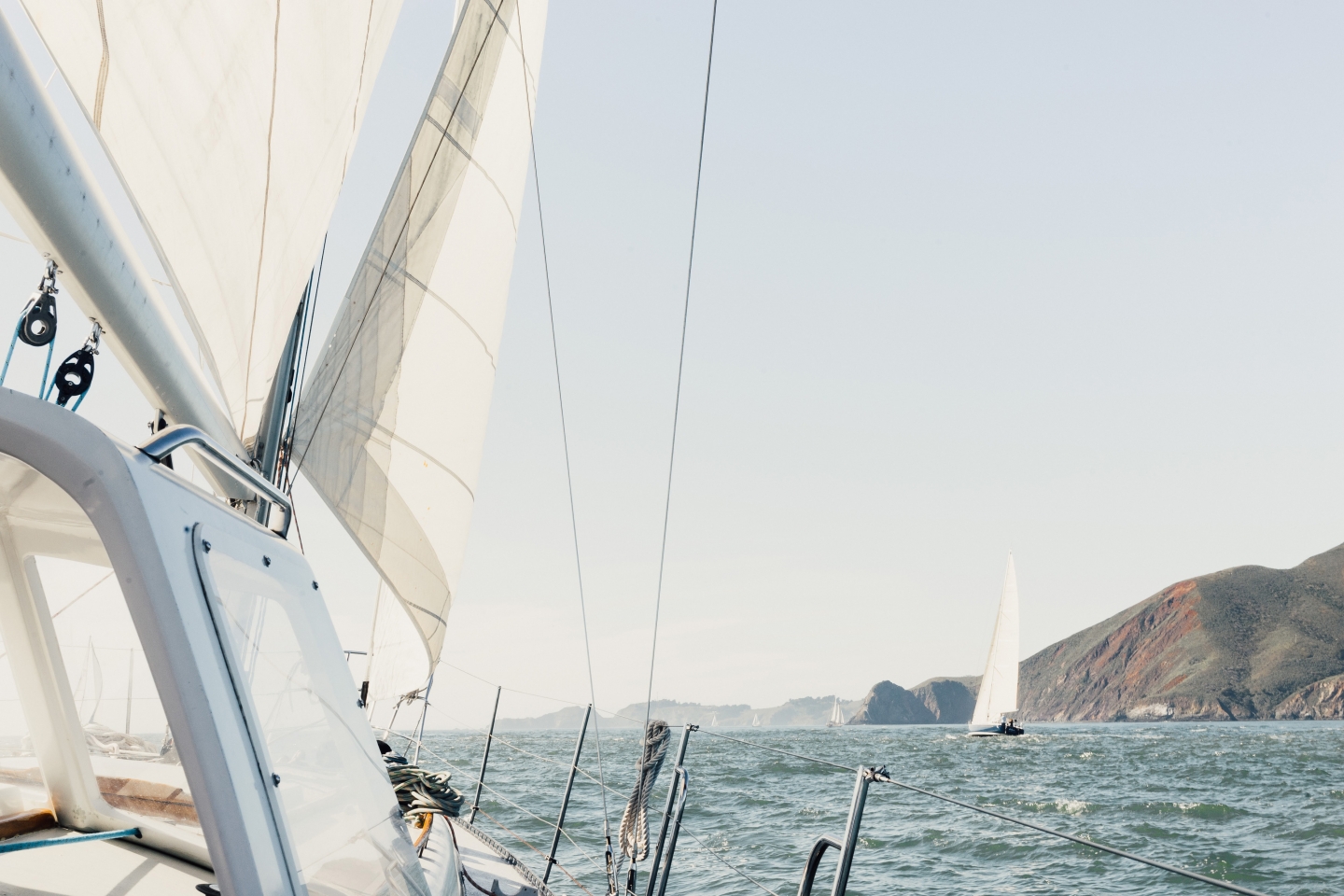
The role of a captain can stretch far beyond just the logistics of sailing a yacht, captains are often hired not only for their technical ability but for their wealth of experience and knowledge which they accumulate over many years. They are responsible not only for a very expensive piece of machinery, but also for the wellbeing and lives of those onboard. Read on to discover the ins-and-outs of the role of a captain in an interview with West Nautical Managing Director Geoff Moore.

What is the role of the captain onboard depending on the yacht range (<24m, 24-50m, 50+m)?
A captain’s role is always to run the crew, oversee the technical condition of the yacht and monitor the finances whilst keeping it safe, secure and in compliance of all local and international maritime regulations. Beyond that, the role that a captain fulfils changes deepening on the size of the yacht, the owner’s style and if there is a management company involved.
When operating on a yacht of less than 24 meters, the captains will be on their own, or maybe with their partner as a stewardess/cook, and so they work directly for the owner and they run the entire yacht operation themselves.
On a yacht between 24 and 50 meters, but less than 500 gross tonnes, the captains have from 4-12 crew, and a lot of administration to complete onboard. If the yacht is a charter vessel, there is a lot more financial reporting to do, and safety compliance paperwork and documentation, but the larger vessels will have a management company, and there will be a competent chief mate and engineer to help the captain run the maintenance and manage the logistics onboard.
A lot of yachts this size have a management company where they oversee the finances, technical and regulatory compliance aspects where the yacht needs a ‘Mini-ISM’ system, which ensures the yacht meets certain minimum safety standards.
Above 500 gross tonnes and the 50m size, there will be a professional management company engaged who work with the captains. At this size, there are a lot more crew and much larger budgets, so the captains here are far less ‘hands on’ and are in fact managing the yacht’s day-to-day operations rather than actively maintaining it and getting their hands dirty! They have a larger crew to conduct the work, and experienced heads of departments (chief engineer, chief officer, chief stewardess and head chef) and the captain oversees them.
When commercial, the yacht will need to comply with the ISM (safety) and ISPS (security) Codes, and the Maritime Labour Convention, and so there is a lot of paperwork, documentation and administration to complete onboard.
What are the different types of licences? Can the owner sail a yacht on his own?
Generally, the licences of yacht captains are:
- Master 200GT
- Master 500GT
- Master 3000GT
- Master Unlimited (coming from the commercial shipping industry)
These licences state the upper size limit of the yacht that the captain can take command of. For owners that want to skipper their own yacht, this can certainly be done if they hold the Master 200GT licence (or above), but generally we only see owners of sub-30 meter yachts wanting to enjoy driving, by manoeuvring the yachts in and out of marinas etc, but theyleave the captain to the day-to-day running of the yacht.
Should the owner invest the captain's education? What kind of education would it be?
Great question! Ultimately yes. The captain is like the CEO of a business, and nobody ever knows everything. Whilst we would expect a captain to be able to safely drive and manoeuvre the yacht, they may not be trained on finances, charter taxes, commercial elements and regulations. Therefore, some short courses and educational upgrade courses, along with some high-level safety training such as additional firefighting, medical or emergency response related topics. These will only make the captain more experienced and competent.
What are the current market salaries according to the yacht range?
Before I answer this, I have to state that every yacht, captain and owner are different! Private yacht captains live a different life to charter captains, and if the captain lives close to where the yacht is based, then they can be at home often and they have a good work-life balance, and these factors all play an important part in what the salary package is, along with other employment benefits such as how much paid holiday time they get.
Average industry monthly salaries:
22-30m – €3000 to €5500
30-40m – €5000 to €8000
40-50m – €8000 to €12,000
50-60m – €11,000 to €14,000
60-70m – €13,000 to €16,000
70-90m – €15,000 to €18,000
90m+ - €17,000 +
How do you know if a captain is working well or badly?
When the owner has a management company, they will always be overseeing the captain’s work, ensuring that invoices are correct and costs are reasonable, as well as ensuring the yacht is well maintained and in the condition the owner expects.
Ultimately, the owner will have their own standards of what they require from their crew with regards to the food they eat, how clean the yacht is, where they cruise and how they much they want to spend, and so the owner will always be able to judge the captain on the quality of their holiday experience onboard.
Where to find a good captain?
The most important element is to find a captain with the same experiences and standards to those of the owner’s requirements. Using a professional crew recruitment company always helps to search for candidates across the market, but it is important for owners to interview captain candidates in person to ensure that communication goes well and that there is a natural chemistry between the two parties, because the captain is the most important person on your yacht, and you need to entrust them not only with your very expensive asset, but also with the lives of your family and friends.
How to build a relationship with a captain, what's the most favourable form of communication?
Modern communication runs on WhatsApp messenger as much as through email and phone calls! Communication has to flow and it has to work well when off the yacht. Captains need to respond to their owners in a timely manner, with sufficient detail and professionalism.
When onboard the yacht together, the captain will generally see the owner when the owner wants to see him..! On smaller yachts this could be several times a day, but on larger yachts, it is the stewardesses and service crew who sees the owner more, but the captain will generally ensure he spends some time with the owner in the morning and evening at least to discuss the days plans and upcoming sailing ideas.
When should you start working with a management company? Why do you need a management company if you already have a captain? Will it double costs?
Think of a captain like a jet pilot. They are 100% responsible for the safety of the jet and the flight, ensuring the guests have a comfortable journey and the service is amazing, but they are not experts in overseeing the maintenance and financial elements of the jet.
There are some similarities with yachts where a yacht captain, depending on their experience, will be perfectly suited to the operation of the yacht for the charters and guest cruises, but they may not besuited to running the entire yacht’s annual budget and responsible for the whole operation.
Captains are trained and qualified to be a mariner, to drive the yacht and to be a safe sailor. They do not get trained or educated in the running of yachts, it is more that they gain experience along their career journey.
Management companies are needed for yachts over 500 gross tonnes when operating commercially, as under the International Safety Management (ISM) Code, a regulatory approved and certified professional organisation who assume the legal responsibility for the safety and security of the yacht are required. When this happens, the yacht runs very differently to an un-managed yacht, because there is always someone overseeing the yacht, and the captain and their crew know that they have someone to ask questions, for advice and guidance, as well as for support when needed.
Yes, of course there are additional costs, but certainly not double costs, and ultimately the yacht should run a lot more professionally and efficiently meaning that there should be less technical faults, less safety concerns and less incidents onboard, meaning the owner can save money in maintenance and breakdowns, and with the combined workforce and experience of a competent captain and management company, the owner has a solid team to look after their best interests.
What do captains do off-season?
Maintenance, maintenance, maintenance! A yacht needs constant work and care applied to it, so the captain must oversee the crew’s maintenance work of the annual servicing, paint work, repairs and upgrades. They will also co-ordinate the contractors attending the yacht to do work, and of course they and the rest of the crew need to take some holiday after the busy charter season!
What is the role of a captain during construction/a refit ?
Captains play a different role in new build construction and refit projects. During a new build, the captain offers valuable input on the design and layout of the yacht for the operational purpose of the vessel.
Shipyards do not operate yachts, they only build them, and so every build needs a captain’s input into it to ensure that when the yacht is delivered and in the middle of the sea, the crew are able to offer the service to the guests. Even small matters such as deciding where storage for certain items go, or to ensure the correct water toys and fishing equipment is onboard will make an improvement to the guests use of the boat.
During refits, captains have often had a big role to play in the work list, especially when it comes to owners’ upgrades. Owners will discuss with their captain during the year how they want to make changes in the winter, whether it is decorative changes, the addition of new equipment or technical changes etc. The captain then has to plan, manage and oversee the process of that happening in the winter.

A day in the life of a superyacht captain
It’s easy to think that a captain’s job is to drive a superyacht to glamorous locations and drop the anchor in idyllic anchorages, but as Kelly Gordon and other captains will tell you, that’s only a tiny part of the role.
For Kelly Gordon, captaining a superyacht was something she never imagined until she had already started a career as a chemistry professor when a chance encounter at a party on a large motor yacht changed everything. Now, having uncovered her passion for the sea and having achieved the ultimate position as a superyacht captain, Gordon is not only a role model for female crew who want to pursue a career on the deck and engineering side of superyachts, but is also an active advocate of crew mental health. But what exactly does a superyacht captain do, and is it just about driving the yacht from A to B and making sure the crew keep it in top condition?
The simple answer, says Gordon, is no – and in fact the role of a modern yacht captain is highly complex and multifaceted. Take Gordon’s current command, for example – a 33-metre private yacht that cruises extensively with the owning family on board. “My responsibilities of course encompass safely operating and navigating the boat – that’s the technical side of it,” Gordon begins. “But actually the smallest element is navigation and operation, and the far bigger side is crew management. I spend a tremendous amount of time with the crew, making sure everyone’s got what they need.
“Along with that too,” she continues, “is making sure that the owners and their family have what they need, and understanding what their plans are. Where do they want to go? What are they wanting to do? It’s about making sure they are always well cared for.”
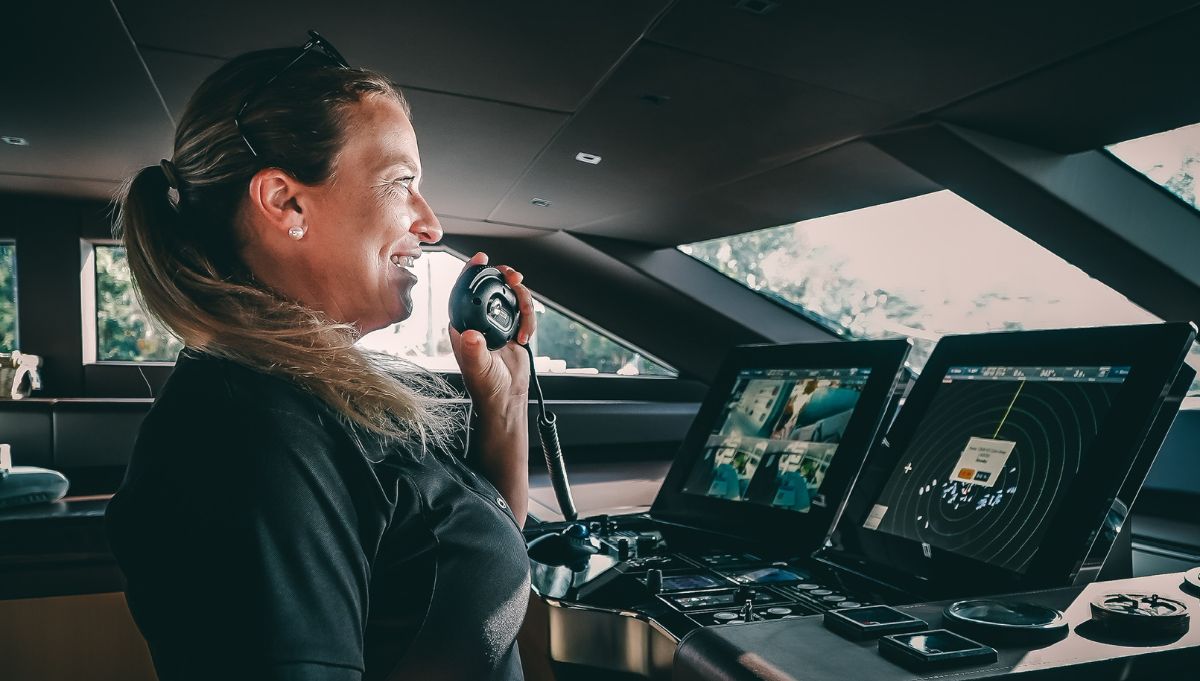
Changing landscapes
The early days of yachting were, in some ways, a much simpler time. Yachts on average were smaller, and captains and crews often came from a sailing or boating background. There were elements that a captain had to understand and undertake, such as holding a recognised commercial skipper’s ticket, keeping logs, managing the yacht’s accounts and so on. But as the fleet has grown and as yachts have grown, so too have the duties expected of captains.
“As a captain, especially the larger and larger you go in terms of yacht, you become the CEO of a company in a way,” Gordon offers. “But you’re doing what you’re trained to do. To operate and navigate the yacht actually ends up being the smaller percentage of what you do, and the day-to-day is emails, paperwork, schedules, plans, maintenance if you’re in the shipyard, and whether you charter or are private you still need to know where the boss or potential guest wants to go, and show them a good time.”
Paper tigers
One thing that has definitely changed over time is the increasing burden of paperwork related to regulatory elements such as the International Safety Management code (ISM) and in some cases the International Ship and Port Facility Security Code (ISPS). “The biggest change I’ve seen since I started is a regulatory change,” offers Captain Steve Osborne . “I find myself spending more and more time on more and more paperwork. There’s a lot of delegation you can do, but you have to really start to understand a lot of the legal frameworks of where you’re going [with the yacht] and be a bit more cautious and pay a bit more attention, because rules have changed over time and are a bit more stringent now.”
Gordon agrees that the burdens have increased, but also argues that there are benefits. “The paperwork has grown, but I think it’s a good thing,” she asserts. “I actually think there probably can stand to be a little more regulation in the industry. When I talk to my buddies who are working on commercial vessels and I see how things are done – granted, they have their own sets of issues as well – I think it’s good that we take a page or two out of their book.”
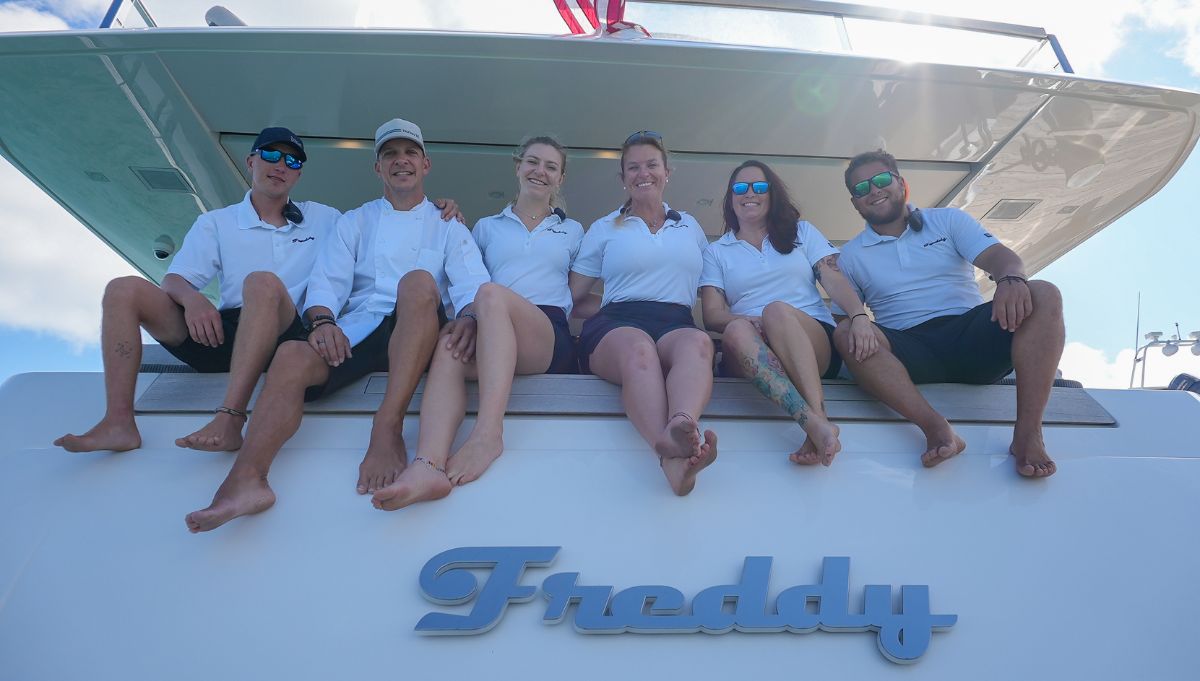
Mind over matter
One of the biggest elements of being a superyacht captain is being able to look after a superyacht crew, and that means not only nurturing and mentoring crew members but also, increasingly, being aware of other issues that can arise – particularly when crews are living in close quarters and working long hours.
“The driving-the-boat bit is easy, that’s our bread and butter,” says Captain Matthew Pownell-Jones. “It’s the other stuff that no one actually teaches you – how to care about the crew, how to listen to someone who has maybe just joined the crew and has a problem that no one knows about. The crew is a floating family, and if that’s the way you think of it then that’s how I feel a team works well.”
It’s something that Gordon has put front and centre not only of how she runs her own yacht and crew, but also of raising awareness in the industry of the importance of mental health considerations. “I’m pretty hard-charging in the mental health space for crew and the yachting industry,” she says. “I’m determined that we will see change, and will see a better and safer workplace for crew, both in terms of general safety on board and also in terms of mental safety.
“I’m not that old – I am only 42 – and just over the course of my life and in my 15 years in this industry I’ve seen it change in terms of being able to talk about it, and it being accepted as a conversation and as part of our overall health. It’s so important because on board we don’t work a nine-to-five then clock out and get to go home to our safe space.”
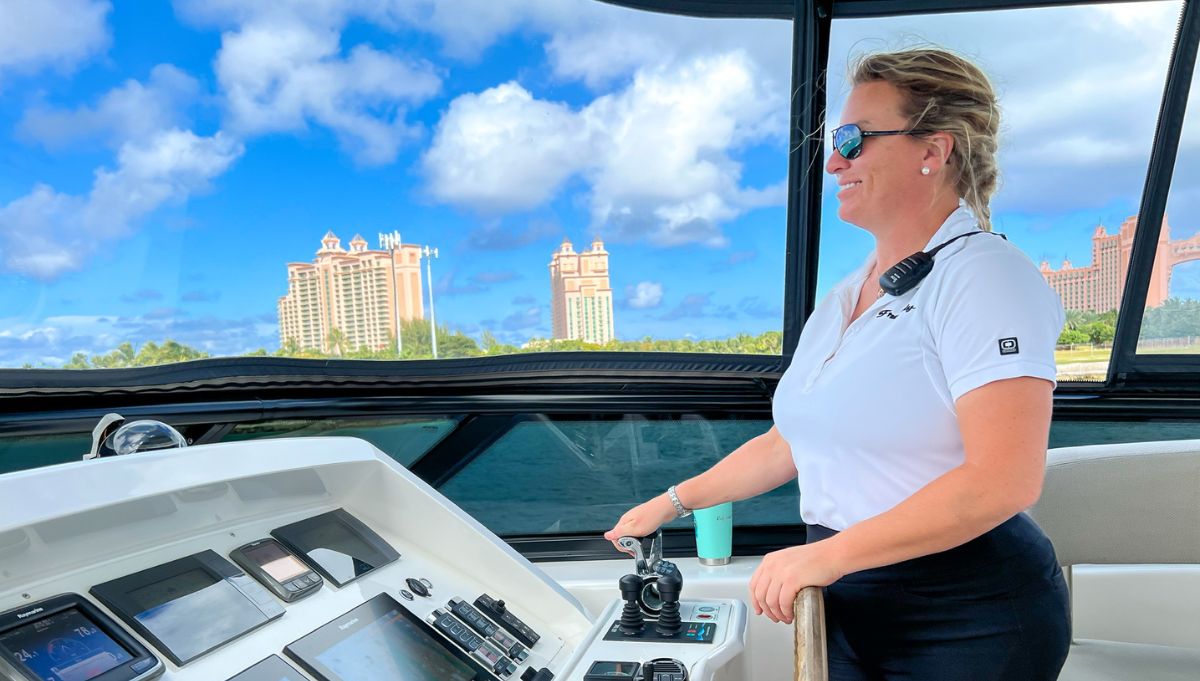
Guest appearance
For all the paperwork, planning and crew management, there is of course the part that makes superyachting what it is – yacht owners and yacht charterers enjoying what a superyacht offers and the places it can take them. It’s perhaps the final piece of the puzzle for an experienced superyacht captain.
“For private cruising or for yacht charter alike, first of all, you want to make sure the yacht is clean and ready to present to the boss or the guests and that each crew member knows who’s doing what,” Gordon enthuses. “If it’s a little booze cruise, the stews need make sure all the drinks are on board and that the yacht interior looks pretty nice and warm and fuzzy. My engineer has to make sure everything’s operating and working, and then the guys on deck make sure that everything’s taken care of on the exterior.
“Then with me, it’s communicating back and forth with the family or the charter guests as to where they want to go or what they want to do, and then communicating that to my crew. And when it gets busy and the days get long, with the crew potentially on call, I try to balance everything by making sure everyone is getting breaks, and offsetting the crews’ functions so that there’s always someone up with the guests and always someone getting some rest to be able to relieve whoever’s on duty.
“People ask me that the best part of my job as captain is outside being able to utilise my skill of navigation and operation of the yacht,” she concludes, “and my favourite part of the job is also the most difficult part – and that’s the crew. I love them to death. My current boat is a happy, fun, loving, playful, hard-working professional boat, but it’s taken a long time to put that together. If you work at it as a captain and you put the time in and invest in finding and mentoring, you can create that.”
Do you work in the superyacht industry? Yes No I would like to receive updates from Superyacht Life
Don’t miss out
Sign up to our newsletter and get our latest stories delivered monthly to your inbox.
- Yachting for beginners
- Owning a yacht
- Motor Yachts
- Sailing Yacht
- Indian Ocean
- Mediterranean
- Buying or Selling a Yacht
- Yachting Events
- FAQ – Luxury Yacht Charter
- FAQ – Buying a Yacht
- FAQ – Sell your Yacht
- How Much Does It Cost To Charter A Luxury Yacht?
- All our Blog Post & News

Yacht crew positions : Hierarchy, Missions & Salaries explained
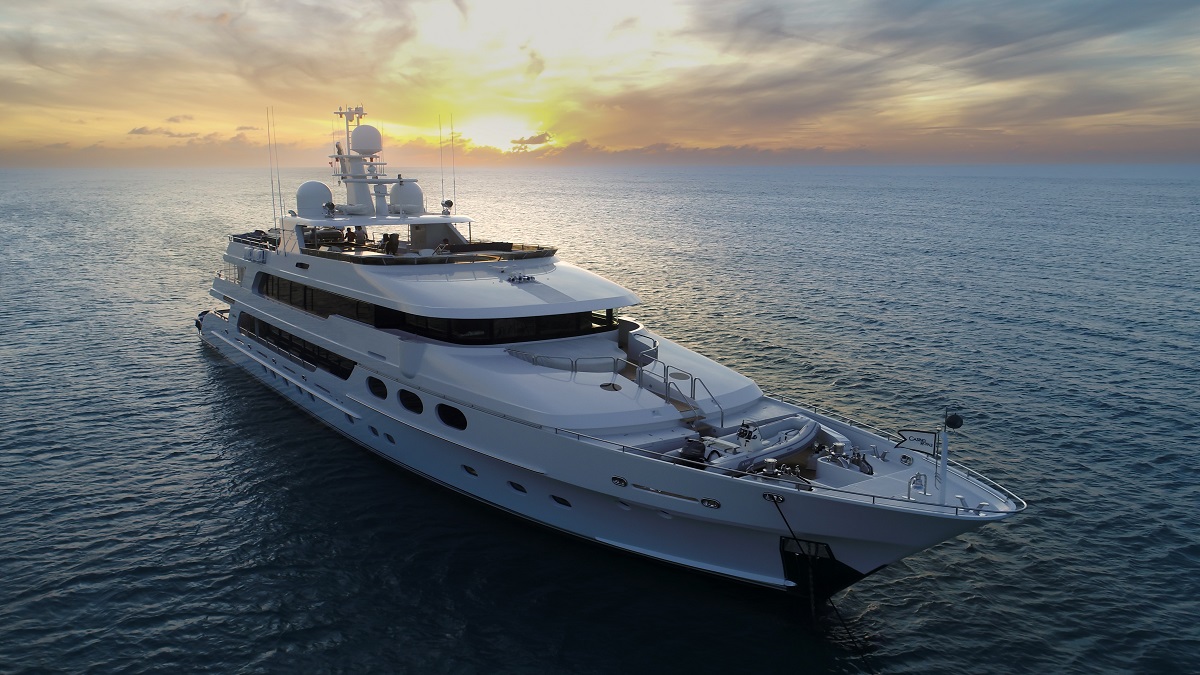
Like any well-run hotel, restaurant, or other luxury service, a crewed yacht needs organized structure and good management. Whether you’re staffing your own luxury vessel or looking for an exciting career working and traveling the world, you need to know how this structure works, and what you can expect to pay or earn and do in the various roles on board.
Every yacht is a little different, and organization may reflect the style of the captain or the demands of the owner. But the same jobs need to be done on almost every boat. Organized with ranks, heads of each division report to the Captain. It’s not a military-style organization, but there are parallels with merchant marine grades and structures.
Smaller yachts need fewer crew, and staff may wear multiple hats that cross more traditional divisions and may combine some jobs with others. Large yachts have more distinct divisions or subdivisions, with more specialization to divide tasks and manage staffing. The core skills are the same, but finding staff with the right blends to do the jobs is key. Crew with broader skills are highly sought after.
As a yacht owner, you shouldn’t have to worry about day-to-day management decisions or organizing all this. That’s why you have a captain, and it’s better to leave staffing decisions entirely up to him or her. But it’s still important to know what it is people you’re hiring do, why they’re there, and how many you need. You don’t want too many crew, or to be short-handed. An understanding of what your yacht needs helps you talk to the captain to keep your yacht running how you want it.
For those looking to break into yacht crew work, consider your skills and strengths, and what jobs appeal to you. You’ll need training before you work, and you can direct your job path through the training you seek. Your goal is a suitable position on a well-run yacht, so make yourself the most attractive candidate possible.
Yacht Work Life
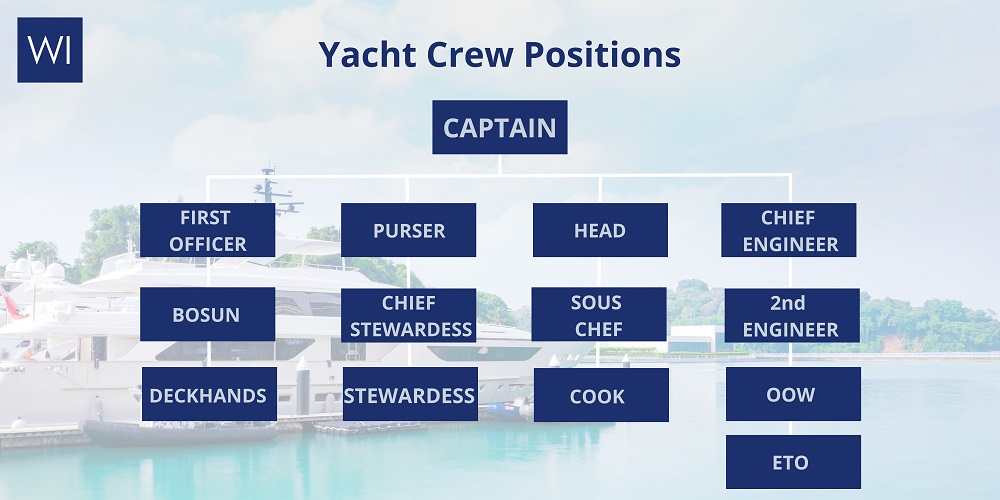
Working on a yacht is also living on the yacht. Crew must have a space to sleep, food, and all the basics that any employee needs. Large yachts have space reserved for crew, and owners looking for quality crew should provide good working and living conditions. Your crew takes care of you, and you should take care of them.
Depending on where a yacht operates or what flag she flies, a variety of labor laws or rules may be in effect. These requirements may be for work visas, contracts and written agreements, and compliance with merchant and ship crew treaties and laws. Be prepared to have work and non-disclosure agreements between yacht and crew, though a few yachts skip this.
Seasonal Jobs
Many yacht positions are seasonal. Year-round employment is more likely for senior crew like the captain and department heads, but not all yachts see year-round use. And some yachts may use different crew in different locales between seasonal moves.
Any job listing should give seasonal information, with geographic information, the length of the season, and the prospects for year-round positions and repeat employment.
Hours, Salaries, and Expectations
Yacht crew is a service job at its core, and every yacht owner is looking for service-oriented people who understand how to deliver a hotel-quality living and restaurant-quality fine dining. Work experience in luxury hotels and restaurants is a big plus for some jobs, and makes breaking into yacht work easier.
Yacht work can be very demanding, with periods of intense work when the owner and guests or a charter party is on board. Long days aren’t uncommon, but often balance with slack time when the boat is empty of passengers. There is always work to be done, but there’s usually a chance for time off.
Most salaries are monthly, since many positions are seasonal. Pay ranges are commensurate with experience, rank, and responsibility. Private vessels usually offer higher base pay, as charter crew can earn tips on top of their base salary. Because of the demands of the lifestyle, compensation is good and you have minimal living expenses on board.
Benefits and Time Off
Because so many jobs are seasonal and may occur in different countries and locations, benefits offered to yacht crew vary widely. But it is not uncommon for crew to be offered health and accident insurance and a flight to the vessel. Living on board, you’ll get food, rooming (usually shared), basic toiletries, uniforms, and laundry. Yachts with a longer view may offer additional training to long-term prospects.
Time off is usually linked to boat use, and may be sporadic in-season or when the boat has the owner and guests on board. There will always be some time off, but it may be between very intense work periods.
Most crew jobs have an employment contract that meets the Maritime Labour Convention 2006 (MLC). This should spell out the contract period and duration, as well as salary, leave and time off, probationary periods, repatriation policies, and any other crucial details to meet the minimum international standards of crew welfare.
This contract should also contain shipboard policies on confidentiality and non-disclosures, drug and alcohol use on board, personal hygiene expectations, interpersonal relationships, and dispute resolution. Job expectations and requirements can also be included, with specific language about roles, tasks, and cooperation between divisions.
Note that all crew agreements will explicitly prohibit drug use on board, most limit alcohol consumption and ban hard liquor on board, and many boats have policies prohibiting intimate personal crew relationships. Because the crew is living on board full time and in close quarters, rules to maintain decorum and crew harmony may be in writing.
Training & Certificates
Two key certifications are required for yacht crew. Employers look for the STCW (Standards of Training, Certification and Watch-keeping for Seafarers) and the ENG1 (Seafarer Medical Certificate). Insurers generally require crew to have these two certifications or the equivalent.
The ENG1 isn’t a class. It’s a medical exam to ensure that the crew is physically fit to serve at sea and has no underlying conditions that may arise far from help. It’s best for prospective crew to secure the ENG1 before investing more time and money training.
STCW is a week-long class on the basics of onboard safety. This includes hands-on modules covering personal survival, fire safety, first aid and CPR, accident prevention, and security awareness. It needs to be refreshed every five years.
Shared, Hybrid, and Crossover Jobs
Larger vessels will have more defined duties and specific areas of responsibility. But smaller yachts may want the crew to have different roles in different situations. For example, a hybrid job description may read “3rd Engineer/Steward” and describe a role in engineering when the boat is empty but on inside crew when passengers are on board.
When hiring or seeking jobs be prepared to look for creative crossover skill sets to meet the needs of the vessel.
Extra Skills and Duties
Any extra skills outside the regular duties makes crew more attractive. From stewards who can teach yoga, give massages or play cocktail piano to deck crew who know how to water ski, SCUBA dive, or fish, anything that crew can bring to enhance the passenger experience adds value to the employee.
If you’re looking for a position, list the skills you’d be comfortable using. If a vessel owner is looking for something specific, spell it out and figure out how that special duty fits into the employee work day.
The Four Main Divisions
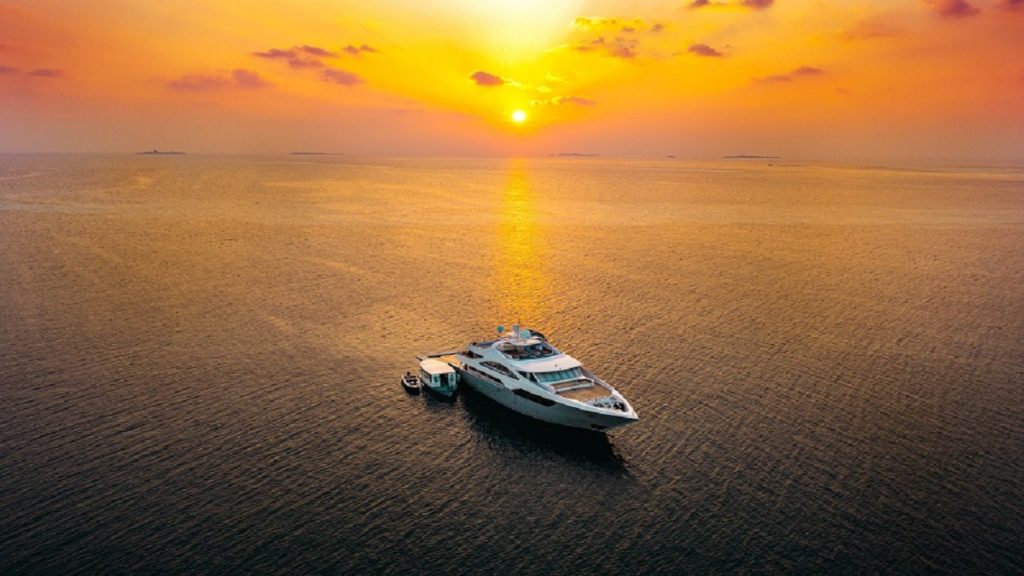
Most yacht crews break into four primary divisions which group related tasks and responsibilities together. While the grouping sounds like it’s by section of the boat, they’re really more functional. For example, stewards (Interior) will definitely serve meals, whether they’re in the main dining room or out on deck. Deckhands (deck) are going to be involved in painting, sanding, and varnish jobs anywhere on the boat.
The deck crew handles most of the exterior operations of the yacht, and runs it. Deck hands and crew keep the boat looking clean and shiny, and handling most vessel operations. This includes driving and operating the yacht, navigation, running all launches and ship’s craft, handling lines, and all maintenance and painting, washing, and shining.
2-Interior (or Inside)
Inside crew are primarily the stewards and housekeepers. Larger vessels will have a dedicated housekeeping staff separate from the stewards, but smaller vessels may not.
Stewards keep the interior clean, do all housekeeping, laundry, food and beverage service, cabin preparation, and anything else needed for the comfort of the passengers.
3-Engineering
Below decks, the engineering department ensures the safe and smooth running of all the ship’s machinery and electronics. Engineers are engine and systems specialists, and there will usually be a dedicated electronics expert. Most engineer jobs require professional training and certification.
Fine dining is a hallmark of the yachting experience, and a full-time galley crew prepares all meals for passengers and crew. The head chef plans the menus and provisions the boat, while junior chefs assist the head chef with meal preparation and keeping the galley spotless.
Yacht Job and Department Details
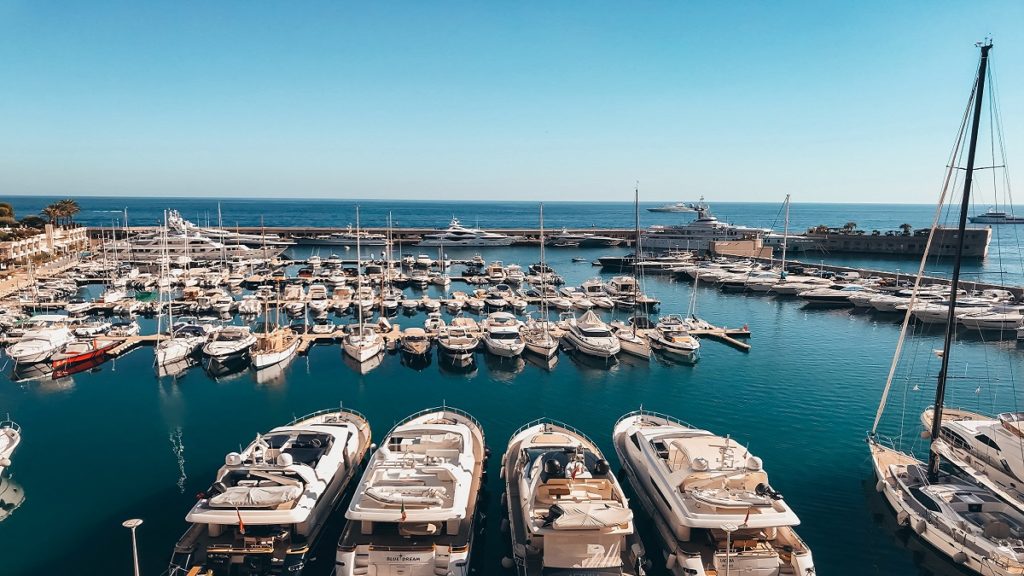
Departments are all organized in a hierarchy, with a department head reporting to the Captain. The clear chain of command makes for smooth operations, with all communications going up and down ranks. Junior staff will occasionally take instructions from other divisions as all crew is expected to help as needed. A captain or department head may organize staff differently, so reporting structures listed are guidelines only.
All salary ranges are monthly figures and are ranges based on yacht size and crew experience. Senior jobs on larger yachts have more responsibility than the same job title on yachts with smaller crews. Experienced crew are very desirable and can expect more pay for their positions.
Listed responsibilities are not exhaustive, and different yachts may allocate some jobs to different positions.
Read also: The yacht charter experience ladder
The Captain

The captain of the vessel is the overall decision maker for the yacht in all situations, including the safety of the vessel. The owner should leave the Captain responsible for operational decisions about hiring and staff and operating the ship. To become a captain requires years of experience and training, and a broad set of skills including yacht operations, personnel management, budgeting and finance. The captain works directly with the owner and owner’s representative, if the captain is not also acting as the representative.
On an organization chart, the Captain is usually placed in the deck division, but the Captain is always the senior-most crew on the yacht and all division heads report to the Captain.
Responsibilities include:
- Responsible for all navigation and running the yacht.
- Senior decision maker on all crew hiring.
- Manage repairs, refits, and yard work.
- Manage budgets and accounting. On larger yachts, this task ends more on the Purser, but the captain is always responsible.
- Ensure all paperwork, clearances, and legal requirements are completed.
- Primary contact with the owner or charter parties.
Reports to: The yacht owner
Salary Range: $6,000 to $22,000
The deckhands handle all the outside responsibilities of the ship, including cleaning and maintenance of the yacht and all the ship’s vessels and toys on board. Deck crew will have significant contact with passengers in this role, operating launches and delivering guests to and from shore and handling the toys.
All deck crew have watch responsibilities on passage, and daily responsibilities keeping the yacht pristine and clean. They will also do line handling and secure the yacht.
Deck department : Chief Mate/First Officer
The Chief Mate or First Officer is the second in command of the vessel, and left in charge when the Captain is not on board. The first mate has the requisite skills to stand in for the captain and run the yacht if needed and usually acts as the division head of the deck team.
The seamanship skills needed are similar to the Captain’s position.
- Primary safety officer for the yacht and all passengers and crew.
- Supervise and manage all operations on deck.
- Bridge watches on passage.
- Passage planning and navigation.
There may be additional mates on larger vessels, these 2nd, 3rd, etc. mates have similar responsibilities on rotation. But the first mate is senior and always second in command.
Reports to: Captain
Salary Range: $4,000 to $9,500 (First mate)
Second and more junior mates may earn $2,000 to $4,000
Deck department : Bosun
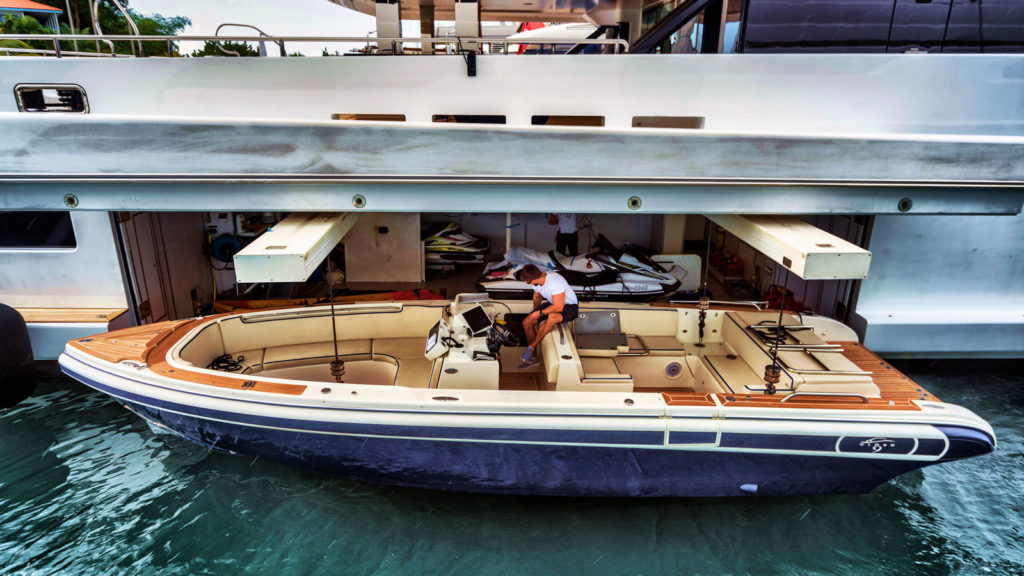
The Bosun is the senior deckhand and manages the junior hands on board. This will usually be the most experienced hand on board.
- Organizing all operations on deck.
- Coordinating the use, storing and launching of the ship’s boats, toys, and equipment.
- Managing the passerelle, watching passenger safety.
- Contact point for guest service on boats, toys, and trips to shore.
Reports to: First mate
Salary Range: $3,000 to $5,000
Deck department : Deckhands
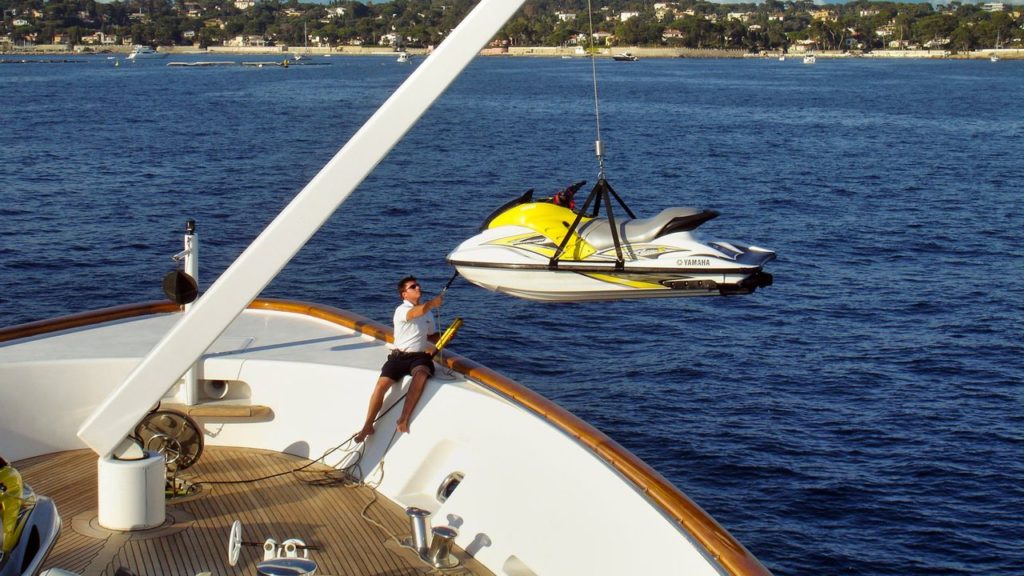
Deckhands are constantly busy with maintenance, cleaning, polishing, and assisting guests as needed. They will assist other departments as needed or given special duties.
- Daily cleaning of the yacht’s exterior.
- Painting, varnishing, polishing.
- Line handling.
- Launching and operating dinghies and tenders.
- Repairs and carpentry.
- Helping guests as needed – everything from handling baggage and gear to embarking and disembarking.
Reports to: Bosun
Salary range: $1,300 to $3,000
Though every position on a yacht is service-oriented, the interior or inside crew provides the primary customer service. They will interact the most with the passengers daily, and they’re directly responsible for the quality of their experience on board.
Interior department : the Purser
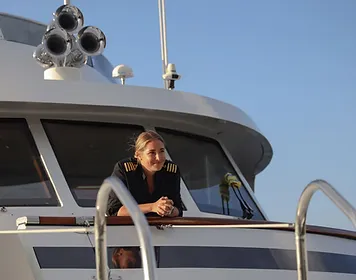
The purser is the chief financial officer of the yacht and handles all the financial operations on board. Accounting, purchasing, payroll and hiring, and all money matters end up with the Purser. This is a senior staff position, and may be the interior department head. Smaller yachts may eliminate the purser’s job and add it to the captain’s and other senior staff duties.
Responsibilities Include:
- Accounting and bookkeeping for all financial transactions.
- Human resources and payroll.
- Handling logistics for all departments related to purchasing.
- Managing contracts.
- Event coordination, including off yacht bookings and payments.
- Primary administration of the boat’s business paperwork.
- Inventory and supply management.
Salary Range: $4,000 to $8,000
Interior department : The Chief Steward/ess
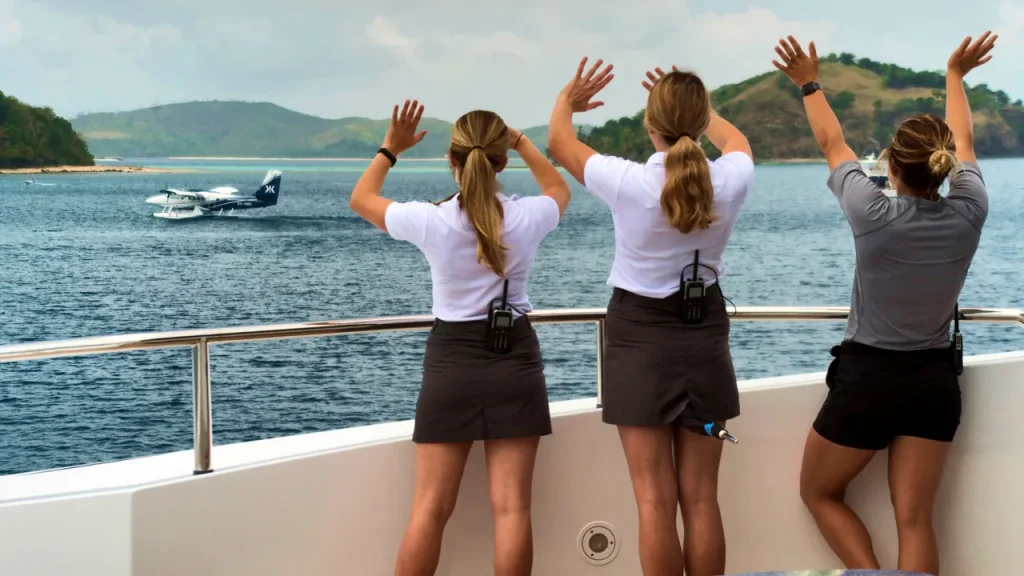
The chief steward or stewardess has primary responsibility for all service roles inside. Food and drink service, cabin preparation, and anything to do with helping the passengers be more comfortable and enjoy their stay. The chief steward will be inside crew with several years of experience.
The chief steward manages the interior staff, setting and enforcing vessel service standards. The chief steward ensures the crew delivers a five-star hospitality experience.
Chief Steward Responsibilities:
- Scheduling and training junior crew for meal and drink service and cabin preparation.
- Primary contact with guests for meals and drinks.
- Sommelier and wine service.
- Coordinate with the galley for meals and presentation.
- Decorate the interior, from flower arrangement to table settings.
- Arrange onshore activities and outings.
Reports to: Captain or Purser, depending on the yacht
Salary Range: $4,000 to $8,500
Stewards/Stewardesses
The stewards and stewardesses are the primary guest service staff. They will work closely with guests and passengers, and have daily contact with them as they meet most of their needs while on board.
Steward Responsibilities:
- Food and drink service.
- Room preparation and turndown service.
- Cleaning, polishing, housekeeping, and inside maintenance.
- Cabin detailing.
- Laundry, pressing, and folding.
- Help with outings, trips, debarkations.
Reports to: Chief Steward
Salary Range: $1,500 to $4,500
Housekeeping

Larger yachts may have a dedicated housekeeping and laundry staff. This will be part of the inside crew, under either the purser or the head steward. There may be a senior housekeeper, if there are more than one housekeeping crew on board.
Responsibilities are the cleaning and laundry portions of the steward’s job, and a laundry steward may spend most of her time inside the ship’s laundry.
An experienced Head of Housekeeping may earn from $4,500 to $7,000, while a Laundry Steward typically earns from $2,500 to $3,500.
Read also: CAN OWNING A YACHT TO CHARTER (REALLY) BE PROFITABLE?
Food service requirements on any yacht are high. Whether it’s a privately owned vessel or a charter, the expectations are always for top tier food service, with a variety of meals planned for the requirements of every passenger. Chefs and cooks prepare all meals on board for passengers and crew, but sometimes other interior crew may help with prep work or cleanup.
Smaller yachts have smaller galley crews, but the largest vessels may have an executive chef and several sous chefs. All chef positions require formal culinary training and experience, but cook positions are often entry level. Promotion from cook to chef is unusual without additional training.
Galley department : the Head / Executive Chef

On larger yachts, an Executive Chef will run the entire galley with the help of sous chefs and cooks. With an Executive Chef, there’s an expectation that the food and menus will be on a level with Michelin star-rated restaurants.
The executive chef brings a thorough understanding of food preparation and presentation, and moves food preparation past creative up to artistic. Job responsibilities are similar to a chef, but the job demands and the required experience and education are much higher.
Salary range: $7,000 to $11,000
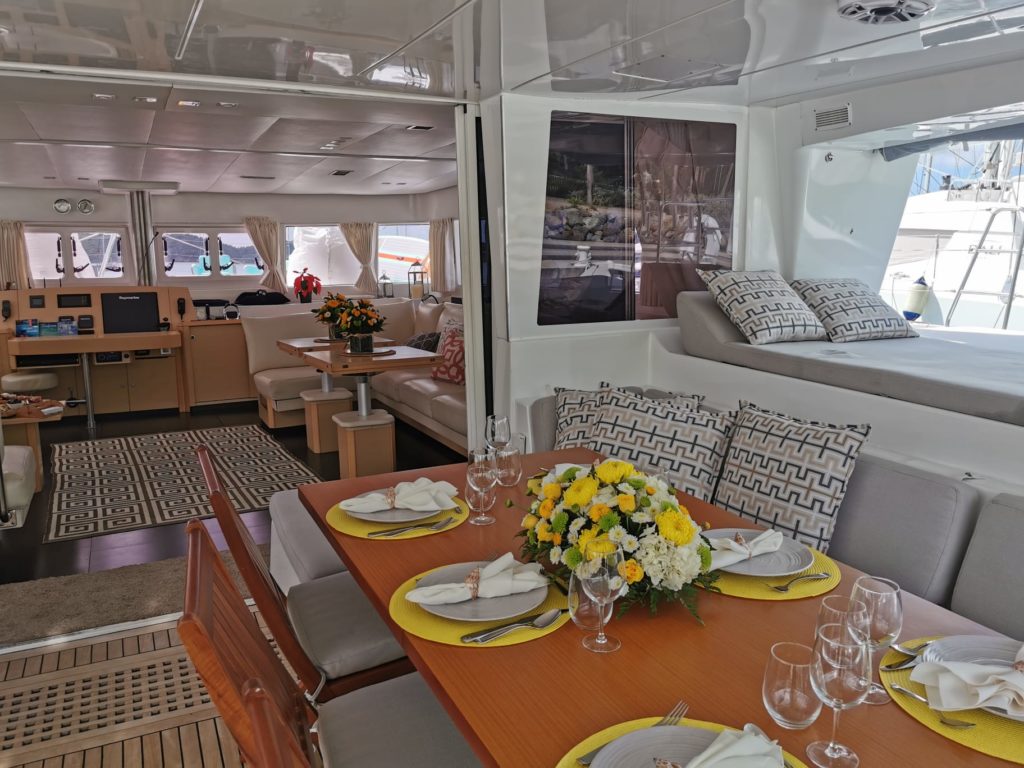
The chef has overall responsibility for all meals on the yacht, from provisioning in remote places to hygiene and good safety. If there’s only one chef, she’s the head of the galley crew. Finding the best provisions in far away locations and making the best of local food availability is a major part of the job.
- Planning a delicious and varied menu for passengers.
- Sourcing all food and arranging transport to the yacht.
- Maintaining and operating within the galley budget.
- Preparing passenger meals with professional presentation and style.
- Cleaning and maintaining galley and galley equipment.
- Deliver menus and meals on time, while running an organized and spotless galley.
Galley department : Sous Chef
The sous chefs assist the chef in all aspects of running the galley, and may have independent assignments to plan and guest and crew meals. While not primarily responsible for provisioning, the sous chef will help with food selection, menu preparation, and planning. A sous chef must have formal culinary training.
Reports to: Head chef
Salary Range: $3,500 – $6,000.

Galley department : The Cook
Cooks may be entry-level positions or experienced, but do not require formal gastronomy education. They will assist the chef and sous chefs, cooking meals and dishes for guests and crew, helping with provisioning, and keeping the galley neat.
- Assist with provisioning and buying high-quality food from local sources.
- Follow all food handling and safety guidelines.
- Assist the head chef as needed, taking direction and guidance.
- Prepare guest and crew meals as required.
- Staying on top of galley inventories and supplies.
Salary Range: $2,500 to $3,500
Engineering
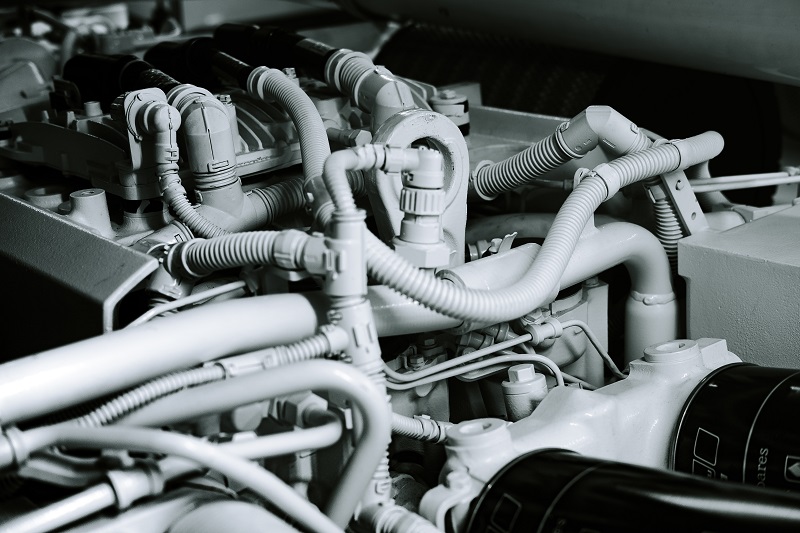
The engineering department keeps the yacht and all its systems working. Whether it’s the engines, electronics, air conditioning, or the plumbing – it’s up to engineering to keep it running.
There is considerable overlap with commercial shipping in the engineering field, as many of the same skills apply. And there is a broader range of qualifications and grades based on the size and power of the vessel. Job ratings may be set by required experience based on tonnage of ship or power of engines, with corresponding levels of pay and responsibility.
Unlike commercial shipping, engineers may get involved in other aspects of running the yacht, like helping with docking and water sports with mechanical toys.
Engineering certifications, training, ratings, experience and licensing are critical to hiring competent engineers, and for engineering crew it’s an important facet of career advancement. This is important for Chief and 2nd Engineers, which are often broken out by MCA (U.K. Maritime and Coastguard Agency) rating or other international equivalent.
MCA ratings for engineers Commercial and Private Yachts over 24m are:
Y4: Less than 200 Gross Tons and less than 1,500 kW engine power Y3: Less than 500 GT and 3,000 kW Y2: Less than 3,000 GT and 3,000 kW Y1: Less than 3,000 GT and 9,000 kW
There is also an unlimited rating for merchant vessels larger than the Y1 category. For discussing salary and responsibilities, we will include all ratings in one position description, but pay scales with the size of the yacht and any required higher ratings.
Chief Engineer
The chief engineer manages all aspects of keeping the yacht and its systems running. The chief engineer manages all the engineering staff, and directs all maintenance, repairs, troubleshooting and upgrades. This is a management position, but requires extensive hands-on technical experience and knowledge. Chief engineers on large yachts hold an MCA Y1 or Y2, smaller boats will have a lower rated chief and a smaller staff. Check Jooble.org to find abroad marine engineer vacancies.
- Provisioning, shopping, and stocking.
- Preparing passenger and crew meals.
- Following instructions and cooking under the direction of others.
- Galley cleaning.
- Follow food safety and storage procedures.
- Food pre-preparation.
Salary Range: $6,000 to $15,000
2nd Engineer
The second engineer is also a highly skilled position requiring a rating or license and several years of experience. This senior level engineer also needs knowledge of how to troubleshoot and maintain all yacht systems.
- Maintain and manage all engineering operations.
- Hire, train and supervise all engineers.
- Project manage all upgrades and retrofits, including managing budgets, contracts, and suppliers.
- Coordinate maintenance schedule for the entire yacht around the usage and seasonal schedules.
- Maintain costs and accounting for engineering operations.
- Design and handle all safety operations.
- Set and maintain standards for operations and cleanliness in the engine room.
Reports to: Chief engineer
Salary Range: $5,500 – $10,000
OOW (Officer of the Watch) Engineer
The OOW is a junior engineering position, but still licensed. There are two categories of OOW – MEOL (Marine Engine Operator License) and the more junior AEC (Assistant Engine Course). The overall responsibilities are similar, working to support the senior engineers and handle independent assignments. The AEC rating is entry level for licensed crew, but has training and certification.
- Support the chief in all projects.
- Maintain a clean, safe engine room.
- Perform all maintenance, troubleshooting and repair tasks as needed.
- Support motorized water sports.
- Occasionally assist with other vessel operations, like line handling.
Reports to: Chief Engineer
Salary Range, MEOL: $4,500 to $6,000 Salary Range, AEC: $2,500 to $3,500
Electronics/Technology Officer (ETO)
The ETO takes responsibility for all audio-visual and information technology on board. Ensuring passengers have access to the internet, movies, television, and music is a primary responsibility. This position carries a fair amount of passenger interaction, and an ETO needs good troubleshooting skills to go with customer service skills.
- Ensure all audio/visual and entertainment systems are always available for passengers.
- Assist passengers with personal technology and ship systems as needed.
- Conduct regular maintenance and upgrades of the network, information, and A/V systems around passenger schedules.
- Assist other engineers as needed, especially with electronic systems.
- Contribute as needed with other departments for boat and passenger operations.
Salary Range: $4,000 to $9,000
Junior Engineer
This is a lower or entry level position for someone with engineering skills but without formal licensing or certification. The junior engineer will help with safety and cleanliness, and assist in any engineering tasks as needed. The ability to solve problems and fix things opens this spot for anyone capable and willing to do the job.
- Help with cleaning, maintenance, and safety functions.
- Help anywhere needed on the yacht.
- Assist senior engineers as needed, taking direction and following instructions exactly.
- Constantly develop skills.
Read also: IS BUYING A BOAT A BAD IDEA?
Whether you are a yacht owner or considering entering this dynamic industry with an established and reliable crew, it is essential to have an understanding of the yacht’s hierarchical structure, mission priorities, and salary expectations. By doing your research on the complexity of yachting before hiring your team, you can confidently select the right group of experienced and qualified professionals for your needs. Staying up-to-date on top industry trends and knowing the capabilities of each type of yacht crew position will enable you to make sound decisions that support a safe and cost-effective journey. With quality personnel at your helm, you can cruise unhindered in luxury and explore new destinations with peace of mind.
Fractional Yacht Ownership : Everything you Need to Know
What is the best country to register your yacht offshore, you might also like.
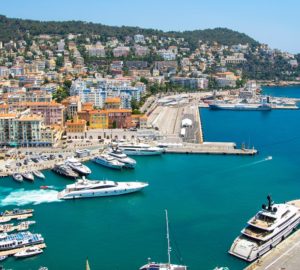
What differentiates a yacht from a superyacht or a mega yacht?
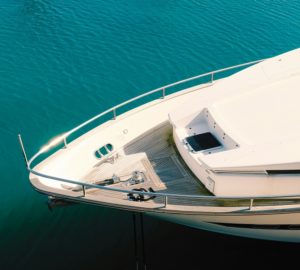
Chartering Requirements and Regulations: A Guide for Boat Owners
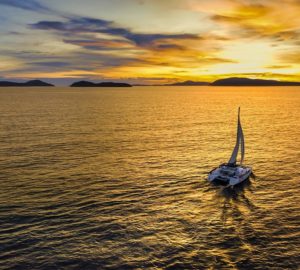
What are the Fastest Cruising Catamaran on the Market?

Yacht Crew Positions and Salaries
The organisational structure onboard a superyacht follows a strong hierarchy based upon a military model. Exact job duties and lines of authority are set and strictly adhered to. This hierarchy is followed on the vast majority of yachts; however, responsibilities of the crew on smaller yachts are often merged.
There are four departments on yachts with clear organisational structure:
- Deck (including Bridge) – Safety, passage delivery, maintenance of the yacht's exterior, guest outdoor activities
- Engineering – Safety and smooth operational running of the yacht
- Interior – Housekeeping, guest wellbeing, activities, accounting
- Galley – Food preparation, stock control, hygiene, galley maintenance
The top of the hierarchy on each yacht is the Captain , who reports to the yacht owner either directly, or through a representative or a yacht management company.
Salaries vary and depend on the yacht size, use, type and location, as well as the experience and qualification of the crew member. We included typical salaries of crew based on the data available from reputable industry sources, as well as our research of over 60,000 crew registered with us.
Deck Positions
The primary duty of the Captain is the overall safe manning and operation of the yacht. Yacht Captain is responsible for the vessel, yacht crew, owner and guests, including personnel management, shipyard/project management, legal and regulatory compliance, accounting, achieving owners' objectives, and answers to the owner regarding all decisions.
| Captain | €4,000 - €15,000 |
First Mate / Chief Officer
The First Mate or Chief Officer is the right hand of the Captain. Takes command of the yacht from Captain when required. Shares Captain's responsibilities as required.
| Chief Officer | €3,000 - €13,500 |
| 2nd Officer | €3,000 - €8,000 |
| 3rd Officer | €2,500 - €6,000 |
| Security Officer | €3,000 - €5,000 |
Bosun / Lead Deckhand
Bosuns are usually experienced Deckhands with additional responsibilities. They are in charge of Deckhands onboard the yacht and often spend a lot of time with guests during outdoor activities. The Bosun is normally the main tender driver.
| Mate | €2,500 - €6,000 |
| Bosun | €2,500 - €5,500 |
| Lead Deckhand | €2,500 - €5,000 |
Responsible for the maintenance of the exterior of the yacht and keeping it in pristine condition at all times. Deckhands also assist in maintaining, cleaning and operating yacht's tenders.
| Junior Deckhand | €2,000 - €3,000 |
| Carpenter | €3,000 - €4,000 |
Engineering Positions
Chief engineer.
Responsible for the Engineering Department and for all technical aspects of the boat and its equipment. The Chief Engineer's duties include overseeing all mechanical and electrical operations, ensuring all planned maintenance takes place and liaising with subcontractors.
| Chief Engineer | €5,000 - €15,000 |
Second / Third Engineer
The Second and Third Engineers report directly to the Chief Engineer. They assist in maintaining all mechanical and electrical operations of the yacht.
| 2nd Engineer | €3,000 - €10,000 |
| 3rd Engineer | €2,500 - €6,500 |
| Sole Engineer | €3,500 - €12,000 |
| Motorman | €2,500 - €4,000 |
ETO / AV/IT Officer
Electro-Technical Officer (ETO) and AV/IT Officer are in charge of daily maintenance of all electronic, computer, audio/visual and communications equipment and their efficient operation. This includes the radio, radar, telephones, satellite communications, navigation systems, computers, Internet connection, interior equipment (TVs, sound systems), etc.
| ETO | €4,000 - €8,000 |
| AV/IT Officer | €4,000 - €7,000 |
Electrician
The Electrician is responsible for maintenance of all electrical circuits onboard the vessel, circuit breakers, switches, lighting, batteries, etc.
| Electrician | €4,000 - €6,500 |
This is an administrative position on large yachts. The Purser is responsible for all operations in the interior department, including inventory, purchasing, provisioning, accounting, organising guest activities, and assisting the Captain with the yachts paperwork.
| Purser | €5,000 - €9,000 |
Chief Steward(ess)
Duties are similar to those of other Steward(ess)es onboard the boat, but on a more senior level, including managing the interior department and training. Small yachts with less crew do not have a Purser. The Chief Steward(ess) is in charge of all the responsibilities normally carried out by the Purser on large yachts.
| Chief Steward(ess) | €4,500 - €8,500 |
| Interior Manager | €4,000 - €8,000 |
| Head of Servicer | €4,000 - €7,000 |
| Head Housekeeper | €3,000 - €5,500 |
| Spa Manager | €3,500 - €5,500 |
Steward(ess)
Steward's or Stewardess's main responsibility is to maintain the interior of the yacht and provide the highest standard of care to the owner and guests. They serve food and drinks, prepare guest activities, pack and unpack luggage and are on call for anything that the guests want anytime day or night. On some yachts, they help the deck crew moor the yacht.
| 2nd Steward(ess) | €3,000 - €6,500 |
| 3rd Steward(ess) | €2,500 - €4,000 |
| Spa Steward(ess) | €3,000 - €4,000 |
| Service Steward(ess) | €2,500 - €5,000 |
| Housekeeping Steward(ess) | €2,500 - €4,000 |
| Laundry Steward(ess) | €2,500 - €4,000 |
| Sole Steward(ess) | €3,000 - €6,000 |
| Junior Steward(ess) | €2,000 - €3,500 |
| Butler | €3,500 - €6,000 |
| Stew/Deck | €2,500 - €4,000 |
The Head/Executive Chef onboard a luxury superyacht is a culinary trained professional responsible for the overall management of the galley department on larger yachts, including guest and crew meals, provisioning, food safety, maintaining strict hygiene standards and financial/budgetary administration.
| Head Chef | €6,000 - €10,000 |
Assists the Head Chef in all aspects of galley duties. The Sous Chef may be required to independently provide crew meals or guest meals at the direction of the Head Chef.
| Sous Chef | €3,500 - €8,000 |
Crew Chef / Cook
Large yachts employ a separate crew and guest chef. The Crew chef provides meals for the crew.
| Crew Chef / Cook | €3,000 - €5,000 |
| Sole Chef | €3,500 - €9,000 |
| Stew / Cook | €2,000 - €4,500 |
Other Positions
Many yachts, especially the large ones, have several additional positions. These are often combined with primary roles, e.g. Stewardess / Masseuse or Deckhand / Dive Instructor . The most common are:
| Beautician | €3,000 - €4,000 |
| Hairdresser | €3,000 - €4,000 |
| Massage Therapist | €2,000 - €4,500 |
| Nurse | €3,000 - €4,500 |
| Dive Instructor | €3,000 - €6,000 |
Career Advice:
Email address:
Remember me Forgotten password?
Password Reset
Enter your email address and we will email you a password reset link.
Email address:
Boat Reviews
- Boats Specs
- Marine Pros
- Boat Insurance
- Boat Warranties
- Boat Transport
- Boat Towing
- Marine Forecasts

Your Ultimate Boating Resource

What are the duties and responsibilities of a boat crew?
If you’re planning on sailing on a boat or yacht, it’s important to understand the roles and responsibilities of the crew. A smooth and safe sailing experience will require each member to work together to ensure the vessel and everyone on it are accounted for and safe.
Here are the duties and responsibilities of a boat crew:
Captain: The captain is the team leader of the crew, responsible for navigating the vessel, monitoring the weather and sea conditions, and making decisions on the direction and course. The captain is also responsible for the safety of the crew and the vessel. In addition, the captain delegates tasks to other crew members, and ensure everyone is following the protocols.
First Mate: The first mate is the second-in-command and assists the captain in all duties. The first mate is responsible for maintenance checks before and during the voyage, monitoring the safety of the crew, and checking that the right safety equipment like life jackets and floatation devices are available on board.
Deckhand: The deckhand is responsible for maintaining the cleanliness and sanitation of the boat, monitoring the safety of the crew, and monitoring the usage of fuel, water, and other necessary supplies.
Engineer: The engineer is responsible for the proper functioning of the boat’s mechanics and propulsion systems such as the engine, electrical systems, water and waste system, and steering. A good engineer must be able to diagnose and solve technical issues efficiently.
Cook or chef: The cook or chef is responsible for meal preparation and keeping the crew well-nourished to keep up the energy levels. Meal preparation could involve local dishes, fresh seafood, and all kinds of gourmet dishes.
Safety Officer: The safety officer is responsible for the safety and well-being of the crew. The safety officer carries out safety procedures and drills such as safety briefings, safety gear checks, and emergency drills. They also monitor the safety of the vessel and safety equipment.
These duties are just the basics of what is expected of a boat crew. Depending on the size of the vessel, additional crew members may include a navigator, mechanic, and stewardess, who are responsible for ensuring the comfort of the guests, and maintaining a clean and well-presented vessel.
Each crew member’s role is essential in ensuring a successful and safe sailing experience. Working collaboratively and following set protocols ensures that the voyage is not only enjoyable but also runs smoothly from start to finish.
Related Questions
What type of wood is used for pier pilings, what is the difference between a dock and a floating pier, what is the proper technique for pulling a beginner wakeboarder, what does ‘no wake’ mean on a lake, what is the difference between wash and wake, is wakesurfing possible in the sea, why don’t wooden piers rot, what size wakeboard is needed, how to achieve more pop on a wakeboard, does wake surfing translate to ocean surfing, latest posts, overview of the 2024 sea-doo rxp-x 325, overview of the 2024 parker offshore 2900 cc, what your boat’s beam is and why it matters, power cats of 2024: ultimate guide to the top power catamarans this year, don't miss, our newsletter.
Get the latest boating tips, fishing resources and featured products in your email from BoatingWorld.com!
Navigating the Heat: 10 Safety Tips for a Safe Boat Ride in the Summer Heat
Highs, lows, and tidal know-how: a deep dive into ocean currents, 10 essential tips for fishing near private property, the benefits of using a drift sock: guidance for anglers, lure fishing: secrets for imitating live bait and attracting fish, explore the untapped depths of america’s best bass fishing spots, outboard motor maintenance: tips for keeping your engine in top shape, the essential boat tool kit: tools every boater needs, diy boat building: 8 tips and tricks for building your own vessel, the art of miniature maritime craftsmanship: ship in a bottle, antifouling paints: a guide to keeping your boat shipshape, beginner’s guide to standup paddle boarding: tips and techniques, boating for fitness: how to stay active on the water, kayak safety: how to stay safe on the water, anchoring in a kayak or canoe: how to secure your small boat, overview of the 2024 yamaha 252sd, overview of the 2024 tiara yachts 48 le, overview of the 2024 bass cat jaguar sts, 2024 pursuit os 445: an overview, 2024 aquila 47 molokai review, 2024 sea-doo switch 13 sport review, gear reviews, megabass oneten max lbo jerkbait review, fortress anchors fx-7 anchoring system review, fortress anchors fx-11 anchoring system review, fortress anchors commando anchor kit review, fortress anchors aluminum anchors review, stay in touch.
To be updated with all the latest news, offers and special announcements.
- Privacy Policy
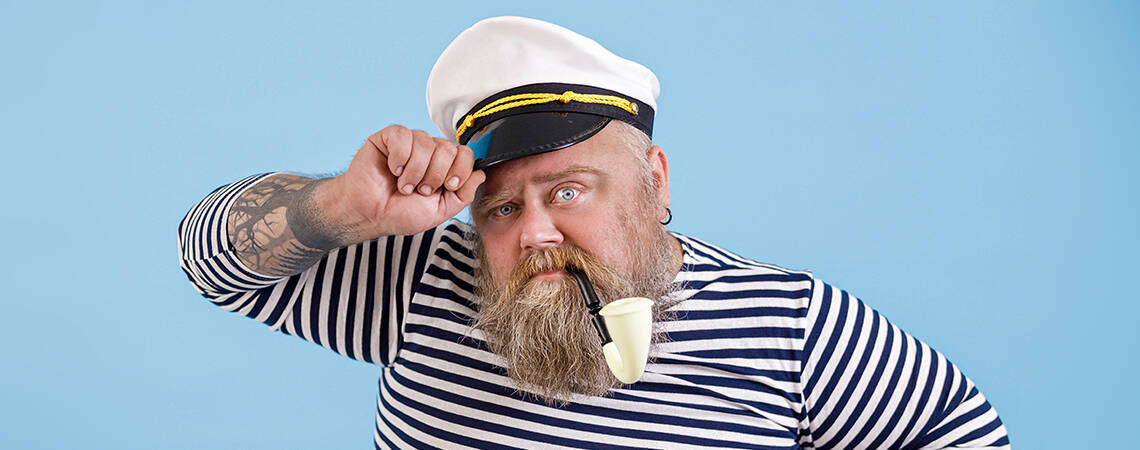
Skipper vs Captain: Who’s Who and What is the Difference?
Skipper vs Captain – what’s the difference, you wonder. I’m here to clarify that for you and present my point of view. Without further delay, let’s find out who’s who and learn the difference.
Skipper vs Captain
Define a skipper, etymology of skipper, what is a skipper on a boat, define a captain, etymology of captain, what is a captain on a boat, a simple “official” rule: captain vs skipper, a simple “unofficial” rule: captain vs skipper, skipper or captain, skipper vs captain – bottom line.
Honestly, “Skipper” comes more heartwarming to me. It sounds romantic, wild, and free, rather than “Captain.”
The Captain is a synonym of the impeccable order on a ship; he stands tall, undisputed, and official. While skippers represent freedom. Skippers construe the image of seafaring, I think.
The skipper and captain words are not equal yet interchangeable: any skipper is a captain, some captains are skippers, and the context is mostly emotional.
Who is the Skipper?
With the word skipper , an image of a salty sea dog with a wooden pipe in his teeth immediately hits my mind, he bravely cuts the roaring ocean apart with his brig, and he must murmur a “fifteen men on a dead man’s chest.” Flying a jolly roger is optional, but yes, this is how in a nutshell, we define a skipper!
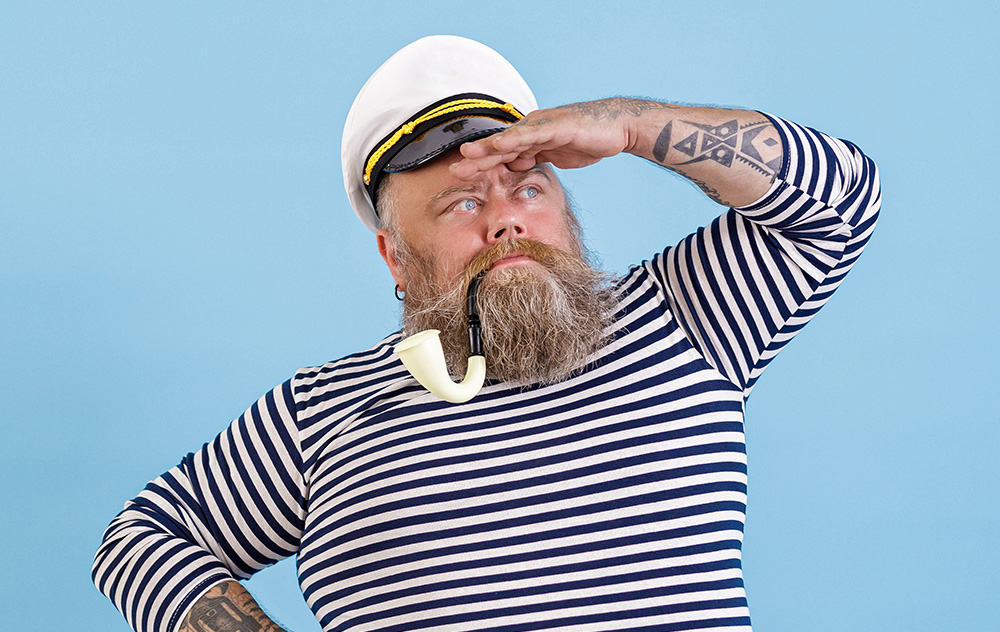
Both Cambridge and Merriam-Webster dictionaries, where the former stands for Classic English and the latter describe the American version of the language, state firmly that a skipper is a master of a ship (master and commander in one, to be precise).
Also, a skipper can serve as a word for one who leads a sports team or an aircraft. So he is a leader and the owner altogether.
To better understand who a skipper is, let’s dig up how the word has appeared in the language. Etymologically, Skipper as a word comes from Old and Middle English and shares the same root with the word “ship”:
SCHIP → SCIP → SKIP → SKIPPER
Thus, Skipper is one with the ship, not only sharing the etymology but sharing a character. More important, he is an owner of himself, and the word “skipper” often means he is an actual owner of the boat. The latter is not too strict language-wise yet displays the idea of who is a skipper.
We see in the dictionaries a skipper is a soul of a boat and the only one responsible for everything (just like a captain). The Skipper is presumably an owner of the boat or may behave like one; indeed, he is always an owner of the situation, compared to Captain – the latter can be ordered to do something. Skipper belongs to no one; he is ideologically an owner to himself.
For example, in everyday speech, we usually refer to the captains of pleasure yachts as skippers because pleasure yachts are relatively small private ships, where the owner and a captain are frequently the same person. Even though you can hire a seasonal skipper for your yacht, forming a partnership, business relations, doubtfully an assignment. Skipper is yet a freeman, or a freelancer, in our case, once hired.
Skipper is an ultimate professional, the same as Captain, but this is a free choice of Skipper to be such. Skipper lives one life for his boat and himself. The skipper is the master of his ship.
A skipper is also a captain of the boat, as of what the official papers state.
The word skipper mainly stands for emotion rather than for rank.
Who is the Captain?
We already know a bit about Skipper, so let’s now define the Captain.
We look for help in the Cambridge and the Merriam Webster again, the two most reliable dictionaries, both agree that a captain is a person in charge of a ship .
You can feel a tiny difference if we compare “a person in charge” to the definition of a skipper: “a master of a ship”. The former is assigned, the latter is just there.
Captain as a word may also define a rank in the force (navy, military, or police). So a captain is an official person, including one on a ship. More important he is assigned to be a leader, even if he has assigned himself. Captain as a word can refer to one who leads a sports team or an aircraft as well as the “skipper” term .
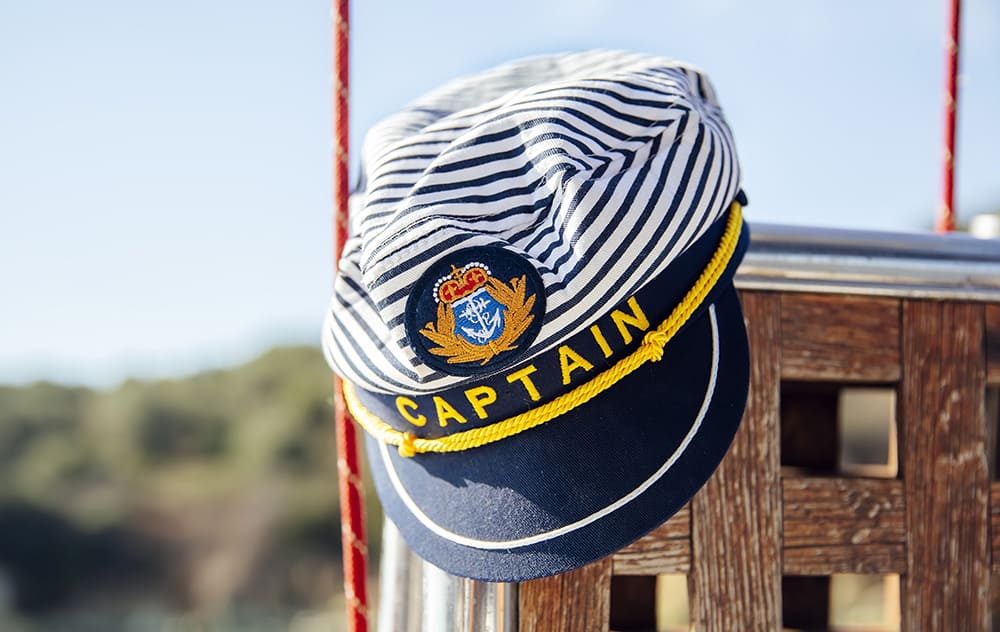
The “captain” word features a Latin origin, where “caput,” plural – “capita,” in Latin means “head.” There are many words like captain, capital, chapter, capsize, and many others, deriving from the Latin caput. All these words refer to a head but in a different measure.
The existence of the skipper word does not make a captain anything less desirable. A captain on a boat is the one in charge of everything. If she is a big boat, like a trans-Atlantic cruise liner, he is in charge of thousands of lives and controls a huge amount of things alone!
TIP Wondering how much do cruise ship captains make? Check!
Just a reminder, we still speak about the same person named either captain or skipper depending on the context.
A captain is always neat and trim, and you necessarily expect him to wear a snow-white uniform and a cap (we can see the same Latin root in the latter). The captain is the definition of order, he is a certified ultimate professional, he is the law on a ship, he is assigned for that, and it is his duty.
Difference Between Skipper and Captain
A captain is responsible for the ship, while a skipper has pulled it as a free choice!
Captain’s duty gives no right to be unpredictable, while Skipper is for that (but we speak about the same person named differently, remember?) The name of the principal penguin in “Madagascar” movie was Skipper, the leader of the penguin gang – just recall his commanding style and how he was driving an airplane. That’s the real Skipper.
We address a Skipper of a sailboat as Captain: “howdy, Captain?” but we refer to him using either word depending on what we want to express.
The “captain” word is also an official term but interchangeable even though being official: for example, my sailing license states I’m a skipper , but it means I can captain yachts.
You say “captain” if you want to compliment a person, as if you are giving him a rank of a captain, showing endless respect and obedience, also acknowledging his unreachable position.
You say “skipper” when your goal is to emphasize emotion and a wilderness of a captain. You refer this way to stress your captain is a dude. You hardly wish to call a “uniform” a dude, right?
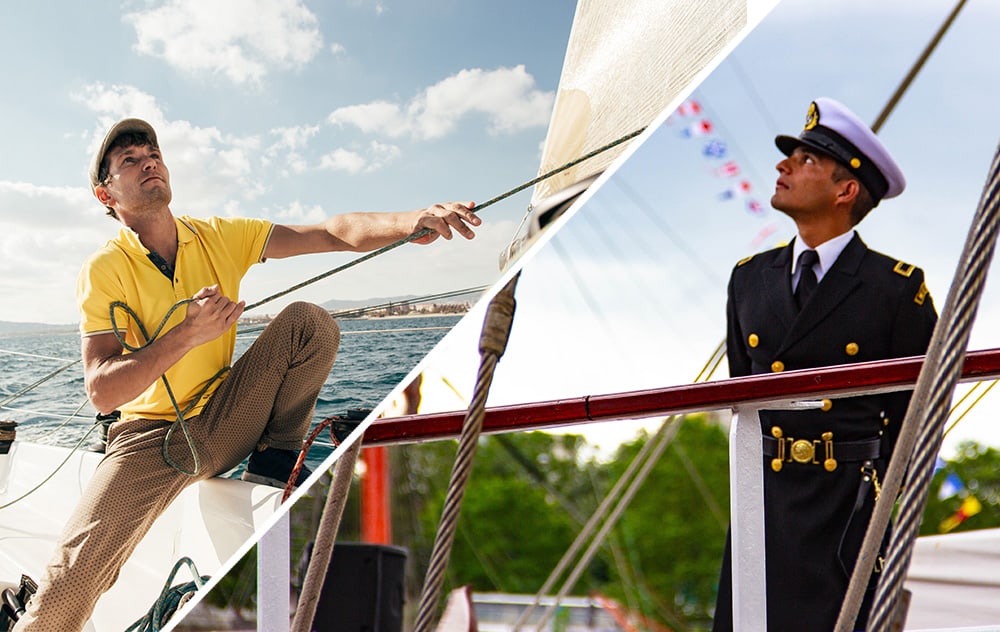
- Usually, the captains of bigger ships are called “captains,” applying that there is a permanent crew of significant size. Such captains are assigned for the job and are subsequently on duty.
- The captains of pleasure yachts are usually referred to as “skippers” because there is no formal assignment, and they are free people going anywhere they want, at any moment they want.
- Yet, in the official papers in the ports, both types are “captains.”
- Saying captain, you imagine a white uniform and a cap on top.
- Saying skipper, you imagine a confident pirate, yo-ho-ho, “and a bottle of rum,” adding up how skippers of pleasure boats tend to perform nearly insane maneuvers from time to time.
None of the two words is “higher.” Both words mean the masters of the sea.
So we can see “skipper” is an emotional word, while “captain” is an official term, and they both represent the same person (what we call interchangeable), but they stress way different contexts.
Here we have listed a bunch of definitions :
- Skipper is the (life-) style.
- Captain is the (official) position.
- On a cruise ship, you are a captain.
- Hunting whales you are a skipper.
- On “Titanic” he was likely a captain.
- On “Cutty Sark” he was definitely a skipper.
If you saw the movie “Master and Commander,” Captain Jack Aubrey owned HMS “Surprise,” he was not hired for her. As a navy officer, he bent his orders and put the crew at risk while chasing a wartime enemy; it was both his duty and a desperate wish to take the prize. Does it come as a conflicting definition? Let’s name him a skipper.
Yes, you can call even an aircraft carrier’s Captain a Skipper, then you emphasize that he is a reckless, pirate-minded type of commander, he is in love with what he is doing, and he acts as if she is his ship.
What is the difference between a skipper and a captain – I have told you all I know; the words, however, are mostly interchangeable. The difference is purely emotional.
Till the next time, Skipper… or Captain!
Disclaimers
All product names, logos, and brands are property of their respective owners. All company, product and service names used in this website are for identification purposes only. Use of these names, logos, and brands does not imply endorsement.
It is our policy to make every effort to respect the copyrights of outside parties. If you believe that your copyright has been misused, please provide us with a message stating your position and we will endeavor to correct any misuse immediately.
Some of the links in this post are affiliate links. As an Amazon Associate, we earn from qualifying purchases. This means if you click on the link and purchase the item, we may receive an affiliate commission, at no extra cost to you. This helps us keep this website alive. Learn more here .

Hi, I’m Igor, Skipper of S/Y "The Hooker". A decade ago, I conquered my childhood dream: to be a sailing skipper, own a sailing yacht. Yes, it knocked dullness out of my urban life — Read more →
One comment
Thanks for the information! This is really helpful and gives me a clear picture of the differences between skipper and captain.
Leave a Reply Cancel Reply
Your email address will not be published. Required fields are marked *
Name *
Email *
Add Comment *
Save my name, email, and website in this browser for the next time I comment.
Post Comment
Related Posts
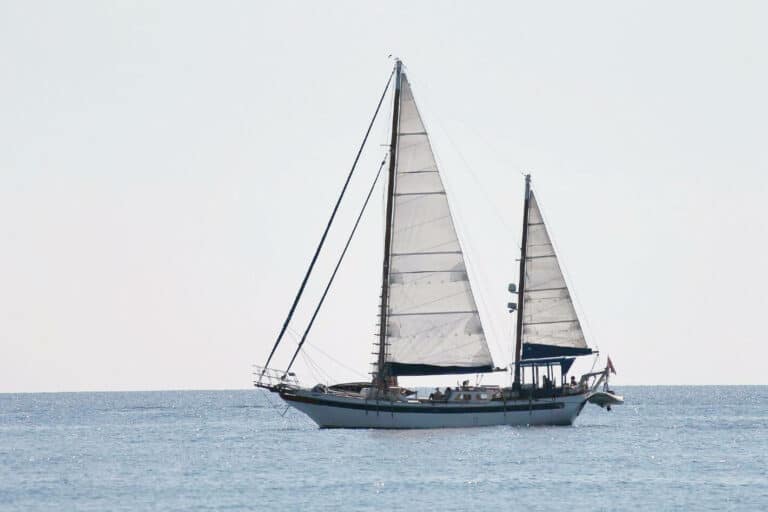
Difference Between Ketch and Yawl Explained
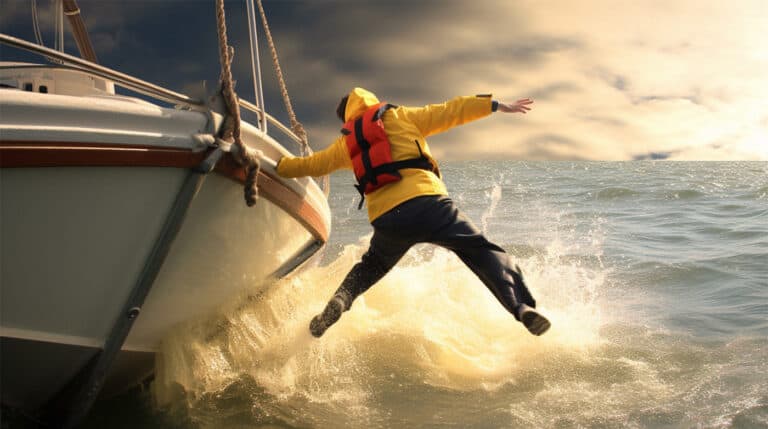
What Is Most Likely To Cause Someone To Fall Overboard?
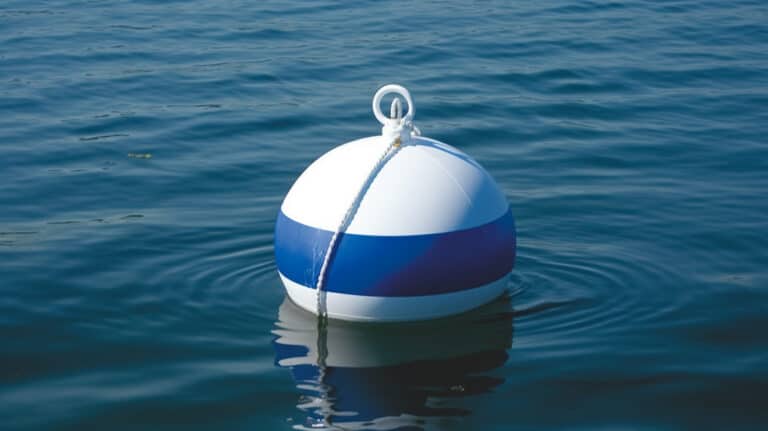
You See A White Buoy With A Blue Band, What Type Of Buoy Is This?
Amazon Disclosure
DesperateSailors.com is a participant in the Amazon Services LLC Associates Program, an affiliate advertising program designed to provide a means for sites to earn advertising fees by advertising and linking to Amazon.com. As an Amazon Associate, we earn from qualifying purchases. Amazon and the Amazon logo are trademarks of Amazon.com, Inc., or its affiliates.
Please refer to our Privacy & Affiliate policy for more details.
- Brokerage New Construction How to Buy How to Sell
- Yacht Fleet Yacht Catalog Charter Marketing Destination Guides
- Financial Services Payroll & Accounting Payroll Service Process Logistical Support Admin Services Crew Admin
- Job Descriptions Crew FAQ
- About Sitemap
How Much Does a Yacht Captain Make?
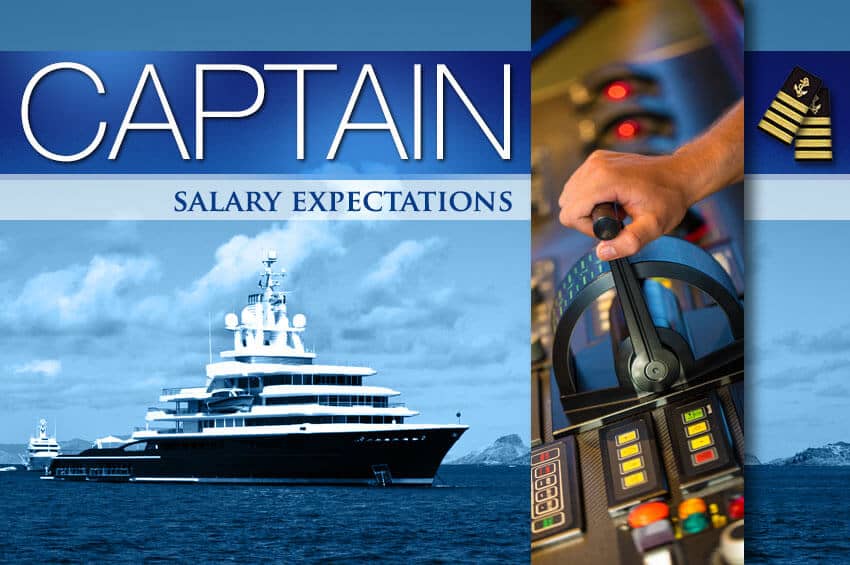
Captains of luxury yachts command a base salary well into six figures. Dependent on the length of the vessel, tenure of experience, and level of licensing yacht captain salaries range from $48,000 to over $300,000.
As the length of yachts increases, the complexity of the position of captain escalates. Although the job of yacht captain is often portrayed as one of luxury and leisure, it is a career choice of vast responsibility. While the exact details of a job description vary from program to program, the captain is the CEO of a small corporation. He/she reports to the Chairman of the Board - the yacht owner.
The Luxury Yacht Group webpage presents salary guidelines. Variation within the ranges reflect license level, experience and longevity of the captain 1 .
| Senior Master | 170 ft – 200 ft + | $144,000 - $300,000 |
| Captain | 100 ft – 170 ft | $84,000 - $180,000 |
| Junior Captain | 60 ft – 100 ft | $48,000 - $98,000 |
Additional parts of the salary package include bonuses, health insurance, flight expenses, paid vacation, training and certification cost reimbursement, and uniforms. Because the position requires residency aboard the vessel 24/7 all food and sundries are routinely supplied to crew. If the yacht is available for charter, the captain will also earn tips from charter guests. The industry is unique and each vessel in it has individual programs.
An average mega yacht with 12 crew has operating expenses between four and ten million dollars. The budget is based on where the yacht is moored, whether it is available for charter, and its travel destinations. On some yachts, a management company or a part of the owner’s business network handles accounting and makes financial decisions. On other yachts, the captain manages all aspects of the budget, chooses what charters to take and where to station the boat between charters, when and where to have yard work, and all personnel decisions.
A basic list of captain job responsibilities includes:
- Ultimate safety for passengers, crew, environment & vessel
- Achieving owner’s objectives?
- Crew hiring and dismissal?
- Personnel management?
- Shipyard/project management?
- Legal and regulatory compliance?
- Navigation?
Ultimate safety
The Captain holds the life of all aboard in his hands. He is also held accountable for the yacht itself and the environment. He must understand the mechanics of the boat, all electronic tools aboard, international regulatory requirements, and rules of the flag state.
Achieving owner’s objectives
Owner objectives are broad ranging. The captain is the mouthpiece for the interests of the owner. He holds the responsibility to reach outcomes which benefit the owner. The owner may simply require the captain to provide luxury service when he (she) is aboard. Some owners regularly use the vessel with family and guests, others may be aboard only occasionally. Charter periods for the vessel also factor into the objectives of the owner.
Crew hiring and dismissal
The requirements of the Marine Labor Convention (MLC) for contracting, dismissing, and managing are explicit and require strict adherence. Throughout any hiring or dismissal, the safety of the vessel and owner as well as issues of confidentiality must be assured by the captain. Identifying the best employees for the program involve a balance of certification, experience and personality.
Personnel management
Managing between 12 and 40 regular crew members aboard a mega/superyacht, day workers and seasonal hires is routine. From dive master, to stewardess, chef, and ETO, the captain must have a working knowledge of the positions and set expectations for performance. In a multi-cultural environment (both guests and crew), the example the captain sets for work ethic, responsibility, and communication optimizes yacht operations. The challenge is complicated by the close quarters of crew accommodations and the group working/living together 24/7.
Shipyard/project management
The Captain oversees issues of time and costs for routine maintenance and vessel upgrades. Knowledge of register and flag requirements are tools the captain uses to define the project, obtain quotes, and supervise the work.
Legal and regulatory
The maritime industry is dynamic. In addition to the flag state and regulatory requirements mentioned above, the captain must remain current with all Maritime Guidance Notices (MGN), Maritime Information Notes (MIN), amendments to all international marine safety codes, and product notices. A knowledge of the global differences in regulations, enforcement agencies and regional mores is critical.
Each vessel has a different business model. At a minimum, the captain is responsible for budget oversight and financial record keeping. If the owner engages a management company, the captain is the interface between the yacht and that organization.
The classic definition of a captain’s job is that of a navigator. Safely plotting a course, following the course, docking and departing from berths are all fundamental vessel handling skills. A seasoned captain has personal familiarity of cruising geographies. Despite the importance and skills required, a small percentage of a captain’s time is dedicated to task.
How does that list of responsibilities distill into the profile of a captain? It takes decades of training, hours logged, certification, and experience to reach the level of performance required to captain a mega/super yacht. In addition to each of those quantifiable requirements, elements of character and temperament differentiate captains.
- Calm and charismatic personality?
- Superior leadership, communication, management and diplomacy skills?
- Excellent boat handling and navigational skills?
- Excellent ISM and ISPS knowledge and practices?
- Excellent maintenance, engineering and technical / troubleshooting experience?
- Ability to remain calm and give directions in an emergency situation?
- Organized and methodical?
- Financial management, business acumen, management skills?
- Languages and cultural sensitivity
- Extensive maritime licensing
Leadership of the crew involves training, coaching and refereeing. When a captain steps into the position of leadership on a large vessel, it is understood that he has ten years (minimum) of increasing responsibility. Training and education were used during that decade to resolve situations without damage to vessel, harm of the environment, or human injury.
As manager and protector of the owner’s investment, the captain negotiates for goods and services. When issues arise, it is the captain who develops options and makes recommendations. Using the comparison to a traditional business, the CEO (captain) and the President of the Board (owner) interface on strategic decisions.
The mega yacht captain is more than just an asset manager. The captain implements owner preferences in order to assure him the best yachting experience. Once an owner has determined the style of yacht he wants to own - how, when, where they want to use vessel - costs of operating and budget generalities are defined. The ultimate goal of captain and crew is the happiness of the owner(s) and their guests. Crew is the primary factor in the owner/guest experience and in a successful program. The captain fully understands and manages the limitations of vessel and crew.
As vessels increased in length, machinery and electronics increased in complexity. In parallel with those changes, regulatory agencies and flag states requirements escalated. The requirements of International Safety Management Code (ISM) and International Ship and Port Security Code (ISPS) reflect the challenges of operating a mega yacht. The captain holds responsibility for implementing all requirements aboard and remaining current with the changes made to respond to new issues within the industry.
During the last decade, the number of superyacht hulls nearly doubled. Based on the 2010 Global Order Book, the superyacht industry managed to grow even during the financial crisis of 2008. The Knight Frank Wealth Report (2016) for the decade concluded that the wealth required to maintain a yacht appears impervious to economic cycles. It does project a slight worldwide slowing of the number of ultra-high-networth individuals during the upcoming decade.
How does that economic data translate into job opportunity for yacht captains who have followed the established career path? How resilient is the opportunity during periods like the global downturn experienced in 2008?
Marcy Laturno, Director of Crew Placement & Charter Specialist at Luxury Yacht Group answered:
A long-term mega yacht captain added:
Securing a position as captain aboard mega and super yachts is competitive. Although new builds are released every year, each year there are additional individuals who have established professional credentialing and adequate experience aboard. Professional captains seek positions where they can assemble a stable crew, build longevity and establish a relationship with the yacht owner.
The position of mega/super yacht captain commands a salary which reflects the level of responsibility and the years of personal and professional development. A relatively small number of positions creates a competitive job market where longevity and experience are rewarded.
- Luxury Yacht Group website
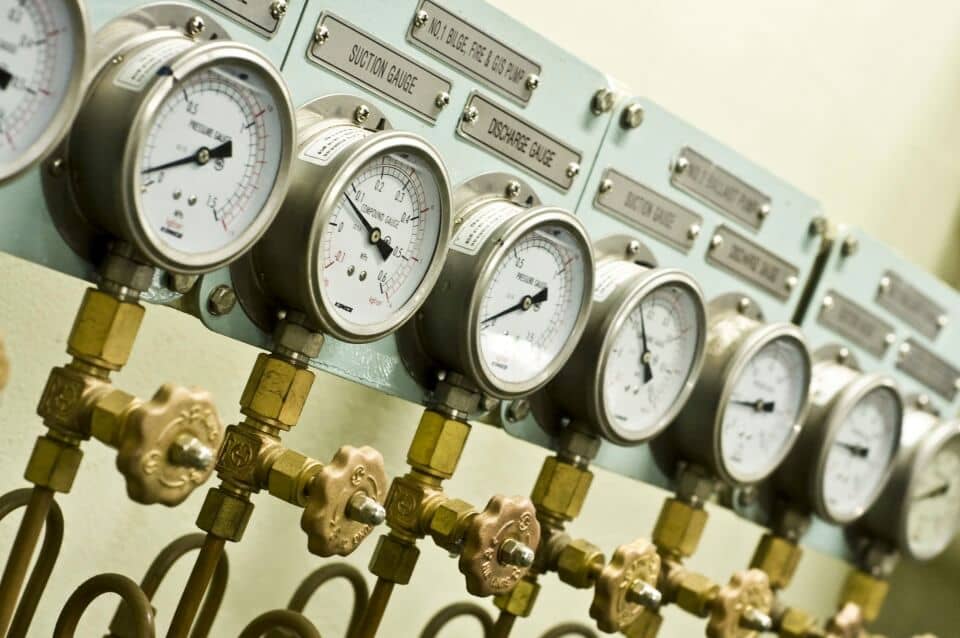
Engineering License Changes
The MCA has restructured the engineering certifications. The MEOL course has been done away with, and the AEC course made mandatory and more thorough. Luxury Yacht Group explains all these changes, what engineers progressing through the ranks can do now, and how Y ticket holders can convert their licenses over to the structure.
14 Mar 2018
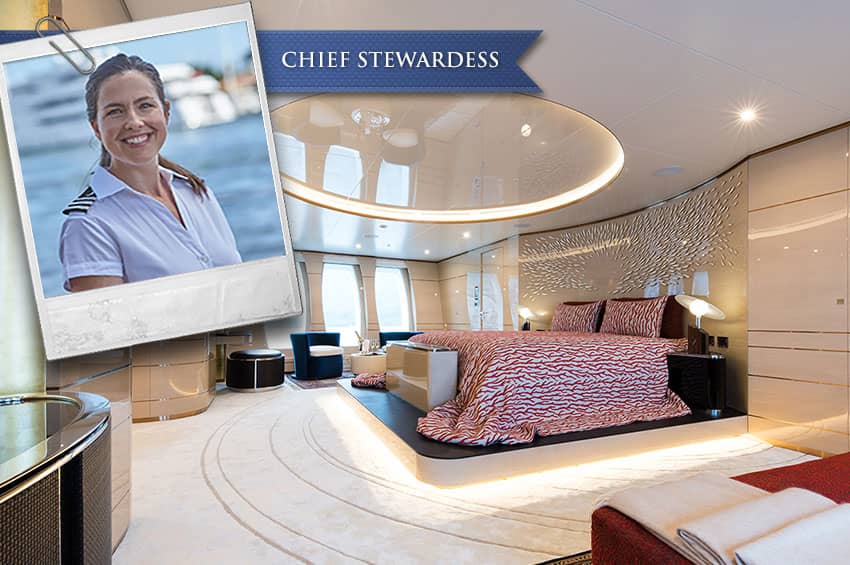
A Day in the Life Series – Chief Stewardess
For a yacht to run smoothly, it requires many working parts, and the interior department is a large component of this. The chief stewardess oversees this department and makes sure all the stewardesses onboard know what their tasks and responsibilities are. The interior department is largely in charge of the guest services whilst they are onboard, and responsible for interior maintenance of the yacht when they are not.
18 Dec 2017
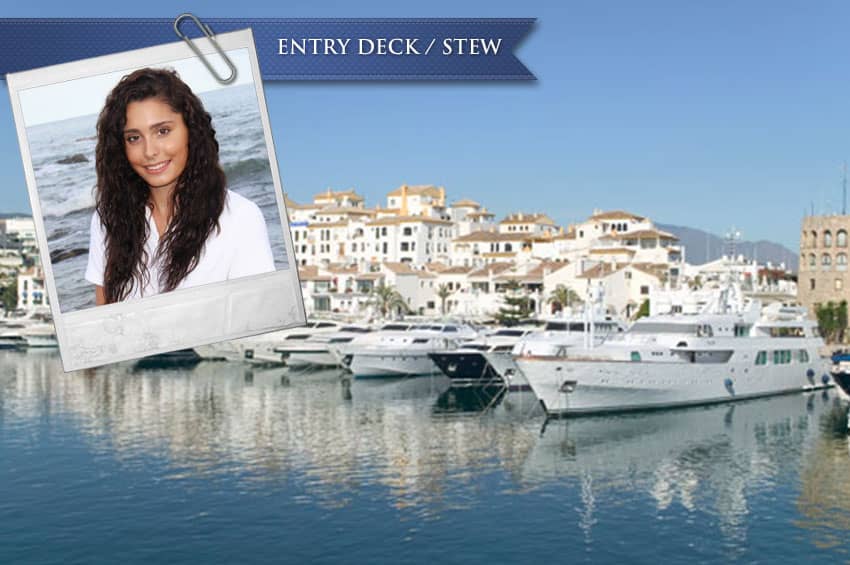
A Day in the Life Of Series - Entry Stewardess
Joining the yachting industry is an exciting and daunting undertaking. In this two part interview we speak with Melanie about why she decided to join the superyacht industry, what her hopes and goals are, and what she has learnt so far as an entry level stewardess.
29 Nov 2017
- Skip to primary navigation
- Skip to main content
- Skip to footer

(866) 300-5984 [email protected]
What are the Requirements for Earning a Captain’s License ?
U.s. coast guard requirements for national oupv or master up to 100 tons.
A Captain’s License is required to operate a commercial vessel or to take paying passengers out on your vessel. Understanding the Captain’s License Requirements is important prior to taking a captain’s license course. The prerequisites should be reviewed before applying for any U.S. Coast Guard credential. This is advised so you don’t spend your time and money pursuing a license that you don’t qualify for. For Maritime Institute’s fee-based credential services, click here to get more info.
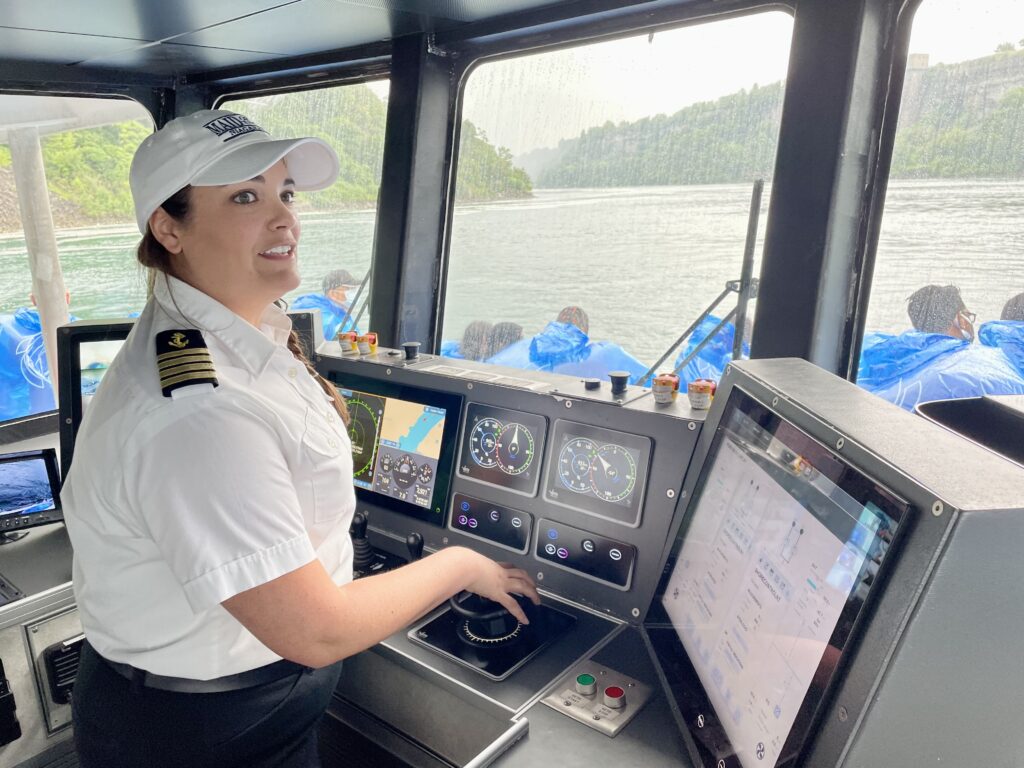
Prerequisites for Operator of Uninspected Passenger Vessels (OUPV/”6-Pack”)
The National OUPV license is limited to uninspected vessels, of less than 100 gross tons, operating on U.S. domestic waters ONLY. Also limited to carrying six or less paying passengers. You must meet all of the requirements established by the USCG National Maritime Center in order to apply for this license. The USCG checklist of requirements is located here on the National Maritime Center website: https://www.dco.uscg.mil/nmc/checklist/ . Under National Officer Endorsements for Deck, click on National OUPV Less Than 100 GRT.
Important sea service requirements for OUPV:
- Must be at least 18 years old.
- Must be able to document 360 days of experience on a vessel, of which at least 90 days must be on Near Coastal/Ocean waters otherwise license will be limited to Inland Waters ONLY. ( See: What Counts as Sea Service )
- 90 days of sea service must be within the last 3 years of when you apply.
- 90 days of sea service must be on Ocean or Near Coastal waters or otherwise the license will be limited to Inland Waters only.
- If you are not a U.S. Citizen, you can apply for this license but it will be limited tonnage and restricted to undocumented vessels.
Prerequisites for Master up to 100 Tons on Inland Waters/Great Lakes
With a Master license you may operate inspected/commercial vessels and also take more than six paying passengers. You must meet all of the requirements established by the USCG National Maritime Center in order to apply for this license. The USCG checklist of requirements is located here on the National Maritime Center website: https://www.dco.uscg.mil/nmc/checklist/ . Under National Officer Endorsements for Deck, click on National Master 100 GL and Inland.
Important sea service requirements for Master Inland/GL:
- Must be at least 19 years old.
- Must be able to document 360 days of experience on a vessel. ( See: What Counts as Sea Service )
- The tonnage of the license (25 Ton, 50 Ton, or 100 Ton) that you get, is determined by your experience. See USCG checklist in the paragraph above for the specific tonnage qualifications .
If you plan on operating an inspected sailing vessel, you must have a sailing endorsement along with the Master Inland/GL license. The required amount of sea service for a sailing endorsement on a Master Inland/GL license is: 180 days on sail or auxiliary sail vessels.
Prerequisites for Master up to 100 Tons on Near Coastal Waters
With a Master license you may operate inspected/commercial vessels and also take more than six paying passengers. You must meet all of the requirements established by the USCG National Maritime Center in order to apply for this license. The USCG checklist of requirements is located here on the National Maritime Center website: https://www.dco.uscg.mil/nmc/checklist/ . Under National Officer Endorsements for Deck, click on National Master 100NC .
- Must be able to document 720 days of experience on a vessel, of which at least 360 days must be on Near Coastal/Ocean waters. ( See: What Counts as Sea Service )
If you plan on operating an inspected sailing vessel, you must have a sailing endorsement along with the Master Near Coastal license. The required amount of sea service for a sailing endorsement on a Master NC license is: 360 days on sail or auxiliary sail vessels.
- Cookie Policy
- Privacy Policy
- Terms of Use
Sign Up For Our E-Newsletter!
Maritime Institute Online Course Portal Book Examination - Everett, WA Book Examination - San Diego, CA
Privacy Overview
Log in to maritime institute.
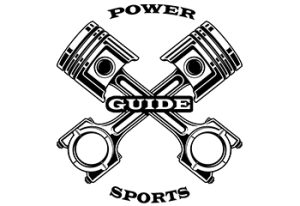
What is the Difference Between Captain and Skipper?
Have you ever watched a movie where there were boats and heard the terms ‘Captain’ and ‘Skipper?’ If you have then you’re definitely not alone.
These are two common terms when referring to boating of any type, though the words can often be used without knowing what they really mean. In fact, sometimes they’re used interchangeably. And sometimes you may hear them used but not really know what they mean. So, let’s take a look.
The Captain of a ship is the person who is set to command the ship, usually in regards to a large ship. On the other hand, the Skipper is also in charge of commanding the ship but usually in regards to smaller ships and boats .
While both of these terms refer to the same position on a boat, they’re usually not used for the same type of boat. Still, there are a number of situations where the terms might be used interchangeably.
You may hear a ship’s Captain called the Skipper because the role is relatively equal. In some instances, the Skipper is the person in charge of the ship or boat while the Captain is in charge of the entire crew and everything that is happening on the boat.

Why Do They Call Captains Skipper?
The Captain is likely called the Skipper because many feel these two terms mean the same thing. After all, the Captain of the boat is the person in charge and the Skipper is the master of the ship . Because these two things sound so similar they are used the same way often.
Captain and Sipper are often used to mean the same thing even though they’re not exactly the same. The Captain is in charge of the crew and everything happening on the boat. They are in command of the ship, while a Skipper is in charge of the ship alone rather than anyone that is actually on it.
Also, a Captain is usually used on a larger ship while a Skipper is used on a smaller ship. Even still, all but the most professional of crews will often use these terms to mean the same thing. And neither will likely be offended by being called by the other title.
Is Skipper a Real Name?
Skipper on its own is generally not a name, though it has been used that way for boys. It’s an English term that’s actually used to refer to a specific position on the crew of a ship. The Skipper is the person who is in charge of the ship.
If you’ve ever seen the show Gilligan’s Island you’ve likely heard one of the characters referred to as ‘Skipper.’ This wasn’t actually his name, but was his role on the ship. It was used as a nickname throughout the series, however.
That’s probably where the idea of ‘Skipper’ as a name came from and some boys have had this name given to them over the years. In general, however, it’s used to refer to a position on the ship’s crew rather than the actual name of a person. But if you hear someone being called skipper when they’re not on a ship you may want to ask.
What Does it Mean When Someone Calls You Skipper?
When you are called ‘Skipper’ it usually means that you are the master of the ship. This term is also used as a slang term occasionally to refer to someone who is very wealthy, usually a male. There are some who actually have the name ‘Skipper’ and so it could also be used to refer to someone by name.
Being called ‘Skipper’ could have a number of different meanings. It’s usually going to take a little more context to know what the person meant when they called you this.
If you are or act like a wealthy person they may use it as a slang term, especially if they are not considered a peer. For those on a ship, however, being called Skipper usually means that you are the master of the ship or that the person believes you are.
How Much Does a Skipper Make?
In the United States a Skipper will typically make about $37 per hour. This comes out to roughly $76,584 per year. This will depend on the type of company they work for and the type of boat that they are responsible for as well. It may also depend on how long they’ve been in the business.
A skipper could make as little as $39,000, depending on where they work and what kind of boat they work on. This would be the bottom 10% of skippers in the country. On the other hand, those who are in the top 10% could make upwards of $148,000 per year. Keep in mind that larger companies are going to pay more and the skipper will be in charge of a larger ship. There may be other responsibilities as well.
The Captain of a boat could make between $56,000 and $84,000 on average, and with Captains and skippers often being referred to interchangeably you may want to make sure of the pay scale if you’re looking to start on as either of these positions. While the Captain generally works on a larger vessel, that doesn’t mean that they always earn more and in fact, their average pay can be less.
A ship’s Captain or a skipper is going to be the person that’s in charge of what’s going on. While you typically won’t find both on the same boat, you will want to know who is the person in charge at any given time. In most cases, smaller boats will have a skipper in charge and larger boats will have a Captain. But make sure you talk with the crew to find out who is the person in charge and what their title is. This will make it easier to reach out to them if you need them.
Related Articles

One of the earliest forms of travel among people is boats. Before there were carts,…

If you’ve ever stood on a dock and watched a boat sail away you know…
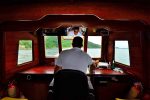
If you’ve ever been on a boat or even watched a movie with a boat…

If you own a boat or you’re thinking about renting one the idea of living…
Recent Content
How Much is a Honda Outboard Motor? [Price List]
The prices of Honda outboard motors start at $1,000 and climb up to a whopping $27,000. To be more precise, average prices within each category are as follows...
How Much HP does a Yamaha Outboard Have? [Chart]
As a rule of thumb, Yamaha outboard motors house 2.5-450 HP engines depending on the model. To be more precise, the engine power in each main class is as...
- Frank Magazine
- Denison History
- Virtual Tours
- Alaskan Yachts
- Azimut Yachts
- Back Cove Yachts
- Beneteau Yachts
- Benetti Superyachts
- Bertram Yachts
- Boston Whaler
- Broward Yachts
- Buddy Davis Sportfish
- Burger Yachts
- Cabo Yachts
- Carver Motoryachts
- Center Console
- Chris-Craft Yachts
- Cruisers Yachts
- DeFever Trawlers
- Dufour Sailboats
- Fairline Yachts
- Feadship Yachts
- Ferretti Yachts
- Formula Yachts
- Fountaine Pajot Cats
- Grady-White
- Grand Banks Trawlers
- Hargrave Yachts
- Hatteras Yachts
- Hinckley Picnic Boats
- Horizon Yachts
- Hydra-Sports
- Intrepid Boats
- Jarrett Bay Sportfish
- Jeanneau Yachts
- Kadey-Krogen Trawlers
- Lazzara Yachts
- Lekker Boats
- Luhrs Sportfish
- Marlow Yachts
- Maritimo Yachts
- Marquis Yachts
- McKinna Motoryachts
- Meridian Yachts
- Midnight Express
- Mochi Craft
- Neptunus Motoryachts
- Nordhavn Trawlers
- Nordic Tugs
- Ocean Alexander Yachts
- Offshore Yachts
- Oyster Sailing Yachts
- Pacific Mariner Yachts
- Palmer Johnson Yachts
- Pershing Yachts
- Prestige Yachts
- Princess Yachts
- Pursuit Yachts
- Riva Yachts
- Riviera Yachts
- Sabre Downeast
- San Lorenzo Yachts
- Sea Ray Boats
- SeaVee Central Consoles
- Selene Trawlers
- Scout Yachts
- Sunseeker Yachts
- Tiara Yachts
- Trinity Superyachts
- Viking Yachts
- Westport Yachts
Nautical + Sailing Terms You Should Know [578 Phrases]
![meaning of yacht captain Nautical + Sailing Terms You Should Know [578 Phrases]](https://cdn.denisonyachtsales.com/wp-content/uploads/2019/06/nautical-terms-you-should-know.jpg)
June 5, 2019 2:05 pm
A seaman’s jargon is among the most challenging to memorize. With over 500 terms used to communicate with a captain, crew, and sailors regarding navigation and more, there’s a word for nearly everything. No need to jump ship, this comprehensive list will have you speaking the lingo in no time.
Abaft the beam: A relative bearing of greater than 90 degrees from the bow. e.g. “two points abaft the port beam.”
Abaft: Toward the stern, relative to some object (“abaft the fore hatch”).
Abandon Ship: An imperative to leave the vessel immediately, usually in the face of some imminent danger.
Abeam: “On the beam”, a relative bearing at right angles to the centerline of the ship’s keel.
Aboard: On or in a vessel. Close aboard means near a ship.
Above board: On or above the deck, in plain view, not hiding anything.
Accommodation ladder: A portable flight of steps down a ship’s side.
Admiral: Senior naval officer of Flag rank. In ascending order of seniority, Rear Admiral, Vice Admiral, Admiral and Admiral of the Fleet (Royal Navy). Derivation reputedly Arabic, from “Emir al Bath” (“Ruler of the waters”).
Admiralty law: Body of law that deals with maritime cases. In the UK administered by the Probate, Divorce and Admiralty Division of the High Court of Justice.
Adrift: Afloat and unattached in any way to the shore or seabed. It may also imply that a vessel is not anchored and not under control, therefore goes where the wind and current take her, (loose from moorings, or out of place). Also refers to any gear not fastened down or put away properly. It can also be used to mean “absent without leave”.
Affreightment: Hiring of a vessel
Aft: Towards the stern (of the vessel).
Afterdeck: Deck behind a ship’s bridge
Afterguard: Men who work the aft sails on the quarterdeck and poop deck
Aground: Resting on or touching the ground or bottom.
Ahead: Forward of the bow.
Ahoy: A cry to draw attention. A term used to hail a boat or a ship, as “Boat ahoy!”.
Ahull: With sails furled and helm lashed to the lee-side.
Aid to Navigation: ( ATON) Any device external to a vessel or aircraft specifically intended to assist navigators in determining their position or safe course, or to warn them of dangers or obstructions to navigation.
All hands: Entire ship’s company, both officers and enlisted personnel.
All-Round White Light: On power-driven vessels less than 39.4 feet in length, this light may be used to combine a masthead light and sternlight into a single white light that can be seen by other vessels from any direction. This light serves as an anchor light when sidelights are extinguished.
Aloft: Above the ship’s uppermost solid structure; overhead or high above.
Alongside: By the side of a ship or pier.
Amidships (or midships): In the middle portion of the ship, along the line of the keel.
Anchor ball: Black shape hoisted in the forepart of a ship to show that ship is anchored in a fairway.
Anchor buoy: A small buoy secured by a light line to anchor to indicate the position of the anchor on the bottom.
Anchor chain or cable: Chain connecting the ship to the anchor.
Anchor detail: Group of men who handle ground tackle when the ship is anchoring or getting underway.
Anchor light: White light displayed by a ship at anchor. Two such lights are displayed by a ship over 150 feet (46 m) in length.
Anchor watch: Making sure that the anchor is holding and the vessel is not drifting. Important during rough weather and at night. Most marine GPS units have an Anchor Watch alarm capability.
Anchor: An object designed to prevent or slow the drift of a ship, attached to the ship by a line or chain; typically a metal, hook-like object, designed to grip the bottom under the body of water.
Anchorage: A suitable place for a ship to anchor. Area of a port or harbor.
Anchor’s aweigh: Said of an anchor when just clear of the bottom.
As the crow flies: A direct line between two points (which might cross land) which is the way crows travel rather than ships which must go around land.
Ashore: On the beach, shore or land.
Astern: Toward the stern; an object or vessel that is abaft another vessel or object.
ASW: Anti-submarine warfare.
Asylum Harbor: A harbor used to provide shelter from a storm.
Athwart, athwartships: At right angles to the fore and aft or centerline of a ship.
Avast: Stop! Cease or desist from whatever is being done.
Awash: So low in the water that the water is constantly washing across the surface.
Aweigh: Position of an anchor just clear of the bottom.
Aye, aye: Reply to an order or command to indicate that it, firstly, is heard; and, secondly, is understood and will be carried out. (“Aye, aye, sir” to officers).
Azimuth circle: Instrument used to take bearings of celestial objects.
Azimuth compass: An instrument employed for ascertaining the position of the sun with respect to magnetic north. The azimuth of an object is its bearing from the observer measured as an angle clockwise from true north.
Back and fill: To use the advantage of the tide being with you when the wind is not.
Backstays: Long lines or cables, reaching from the rear of the vessel to the mast heads, used to support the mast.
Baggywrinkle: A soft covering for cables (or any other obstructions) that prevents sail chafing from occurring.
Bale Cube (or Bale Capacity): The space available for cargo measured in cubic feet to the inside of the cargo battens, on the frames, and to the underside of the beams.
Ballaster: One who supplies ships with ballast.
Bank (sea floor): A large area of elevated sea floor.
Banyan: Traditional Royal Navy term for a day or shorter period of rest and relaxation.
Bar pilot: A bar pilot guides ships over the dangerous sandbars at the mouth of rivers and bays.
Bar: Large mass of sand or earth, formed by the surge of the sea. They are mostly found at the entrances of great rivers or havens, and often render navigation extremely dangerous, but confer tranquility once inside. See also: Touch and go, grounding. Alfred Lord Tennyson’s poem ‘Crossing the bar’ an allegory for death.
Bargemaster: Owner of a barge.
Barrelman: A sailor that was stationed in the crow’s nest.
Beacon: A lighted or unlighted fixed aid to navigation attached directly to the earth’s surface. (Lights and daybeacons both constitute beacons).
Beam ends: The sides of a ship. “On her beam ends” may mean the vessel is literally on her side and possibly about to capsize; more often, the phrase means the vessel is listing 45 degrees or more.
Beam: The beam of a ship is its width at the widest point or a point alongside the ship at the mid-point of its length.
Bear away: Turn away from the wind, often with reference to a transit.
Bear down: Turn away from the wind, often with reference to a transit.
Bearing: The horizontal direction of a line of sight between two objects on the surface of the earth.
Bee: Hardwood on either side of bowsprit through which forestays are reeved
Before the mast: Literally, the area of a ship before the foremast (the forecastle). Most often used to describe men whose living quarters are located here, officers being housed behind (abaft) the mast and enlisted men before the mast. This was because the midships area where the officers were berthed is more stable, being closer to the center of gravity, and thus more comfortable. It is less subject to the up and down movement resulting from the ship’s pitching.
Belay: To secure a rope by winding on a pin or cleat
Belaying pins: Bars of iron or hardwood to which running rigging may be secured, or belayed.
Berth: A bed on a boat, or a space in a port or harbor where a vessel can be tied up.
Best bower (anchor): The larger of two anchors carried in the bow; so named as it was the last, best hope.
Bilge: The bilge is the compartment at the bottom of the hull of a ship or boat where water collects so that it may be pumped out of the vessel at a later time.
Bilged on her anchor: A ship that has run upon her own anchor.
Bimini: Weather-resistant fabric stretched over a stainless steel frame, fastened above the cockpit of a sailboat or flybridge of a power yacht which serves as a rain or sun shade.
Bimmy: A punitive instrument.
Binnacle list: A ship’s sick list. The list of men unable to report for duty was given to the officer or mate of the watch by the ship’s surgeon. The list was kept at the binnacle.
Binnacle: The stand on which the ship’s compass is mounted.
Bitter end: The anchor cable is tied to the bitts when the cable is fully paid out, the bitter end has been reached. The last part of a rope or cable.
Bitts: Posts mounted on a ship for fastening ropes
Bloody: An intensive derived from the substantive ‘blood’, a name applied to the Bucks, Scrowers, and Mohocks of the seventeenth centuries.
Blue Peter: A blue and white flag hoisted at the foretrucks of ships about to sail.
Boat: A craft or vessel designed to float on, and provide transport over, water.
Boatswain or bosun: A non-commissioned officer responsible for the sails, ropes, and boats on a ship who issues “piped” commands to seamen.
Bobstay: Rope used on ships to steady the bowsprit
Bollard: From “bol” or “bole”, the round trunk of a tree. A substantial vertical pillar to which lines may be made fast. Generally on the quayside rather than the ship.
Boltrope: Strong rope stitched to edges of a sail
Booby hatch: A sliding hatch or cover.
Booby: A type of bird that has little fear and therefore is particularly easy to catch, hence booby prize.
Boom vang: A sail control that lets one apply downward tension on the boom, countering the upward tension provided by the mainsail. The boom vang adds an element of control to mainsail shape when the mainsheet is let out enough that it no longer pulls the boom down. Boom vang tension helps control leech twist, a primary component of sail power.
Boom: A spar used to extend the foot of a fore-and-aft sail.
Booms: Masts or yards, lying on board in reserve.
Bosun: Boatswain
Bottomry: Pledging a ship as security in a financial transaction.
Bow: The front of a ship.
Bower: Anchor carried at bow of a ship
Bowline: A type of knot, producing a strong loop of a fixed size, topologically similar to a sheet bend. Also, a rope attached to the side of a sail to pull it towards the bow (for keeping the windward edge of the sail steady).
Bowse: To pull or hoist.
Bowsprit: A spar projecting from the bow used as an anchor for the forestay and other rigging.
Brail: To furl or truss a sail by pulling it in towards the mast, or the ropes used to do so.
Bream: To clean a ship’s bottom by burning off seaweed.
Bridge: A structure above the weather deck, extending the full width of the vessel, which houses a command center, itself called by association, the bridge.
Bring to: Cause a ship to be stationary by arranging the sails.
Broaching-to: A sudden movement in navigation, when the ship, while scudding before the wind, accidentally turns her leeward side to windward, also use to describe the point when water starts to come over the gunwale due to this turn.
Buffer: The chief bosun’s mate, responsible for discipline.
Bulkhead: An upright wall within the hull of a ship. Particularly a load bearing wall.
Bulwark: The extension of the ship’s side above the level of the weather deck.
Bumboat: A private boat selling goods.
Bumpkin: An iron bar (projecting outboard from a ship’s side) to which the lower and topsail brace blocks are sometimes hooked. Chains supporting/stabilizing the bowsprit.
Bunt: Middle of sail, fish-net or cloth when slack.
Buntline: One of the lines tied to the bottom of a square sail and used to haul it up to the yard when furling.
Buoy: A floating object of defined shape and color, which is anchored at a given position and serves as an aid to navigation.
Buoyed Up: Lifted by a buoy, especially a cable that has been lifted to prevent it from trailing on the bottom.
Burgee: Small ship’s flag used for identification or signaling.
By and Large: By means into the wind, while large means with the wind. By and large, is used to indicate all possible situations “the ship handles well both by and large”.
By the board: Anything that has gone overboard.
Cabin boy: attendant on passengers and crew.
Cabin: an enclosed room on a deck or flat.
Cable: A large rope; also a measure of length or distance. Equivalent to (UK) 1/10 nautical mile, approx. 600 feet; (USA) 120 fathoms, 720 feet (219 m); other countries use different values.
Cabotage: Shipping and sailing between points in the same country.
Camber: Slight arch or convexity to a beam or deck of a ship.
Canister: A type of anti-personnel cannon load in which lead balls or other loose metallic items were enclosed in a tin or iron shell. On firing the shell would disintegrate releasing the smaller metal objects.
Cape Horn fever: The name of the fake illness a malingerer is pretending to suffer from.
Capsize: When a ship or boat lists too far and rolls over, exposing the keel. On large vessels, this often results in the sinking of the ship.
Capstan: A huge rotating hub (wheel) mounted vertically and provided with horizontal holes to take up the capstan bars (when manually rotated), used to wind in anchors or other heavy objects; and sometimes to administer flogging over.
Captain’s daughter: The cat o’ nine tails, which in principle is only used on board on the captain’s (or a court martial’s) personal orders.
Careening: Cause the ship to tilt on its side, usually to clean or repair the hull below the water line.
Cargo Deadweight Tons: The weight remaining after deducting fuel, water, stores, dunnage and such other items necessary for use on a voyage from the deadweight of the vessel.
Carlin: Similar to a beam, except running in a fore and aft direction.
Cat Head: A beam extending out from the hull used to support an anchor when raised in order to secure or “fish” it.
Cat: To prepare an anchor, after raising it by lifting it with a tackle to the Cat Head, prior to securing (fishing) it alongside for sea. (An anchor raised to the Cat Head is said to be catted).
Catamaran: A vessel with two hulls.
Catboat: A cat-rigged vessel with only one sail, usually on a gaff.
Centreboard: A removable keel used to resist leeway.
Chafing Gear: Material applied to a line or spar to prevent or reduce chafing. See Baggywrinkle.
Chafing: Wear on the line or sail caused by constant rubbing against another surface.
Chain-wale or channel: A broad, thick plank that projects horizontally from each of a ship’s sides abreast a mast, distinguished as the fore, main, or mizzen channel accordingly, serving to extend the base for the shrouds, which supports the mast.
Chine: A relatively sharp angle in the hull, as compared to the rounded bottoms of most traditional boat hulls.
Chock: Metal casting with curved arms for passing ropes for mooring ship.
Chock-a-block: Rigging blocks that are so tight against one another that they cannot be further tightened.
Clean bill of health: A certificate issued by a port indicating that the ship carries no infectious diseases.
Clean slate: At the helm, the watch keeper would record details of speed, distances, headings, etc. on a slate. At the beginning of a new watch the slate would be wiped clean.
Cleat: A stationary device used to secure a rope aboard a vessel.
Clew: Corner of sail with a hole to attach ropes.
Clew-lines: Used to truss up the clews, the lower corners of square sails.
Club: hauling the ship drops one of its anchors at high speed to turn abruptly. This was sometimes used as a means to get a good firing angle on a pursuing vessel.
Coaming: The raised edge of a hatchway used to help keep out water.
Cocket: Official shipping seal; customs clearance form.
Cofferdam: Narrow vacant space between two bulkheads of a ship.
Cog: Single-masted, square-sailed ship with a raised stern.
Companionway: A raised and windowed hatchway in the ship’s deck, with a ladder leading below and the hooded entrance-hatch to the main cabins.
Compass: Navigational instrument that revolutionized travel.
Complement: The full number of people required to operate a ship. Includes officers and crewmembers; does not include passengers.
Cordage: Ropes in the rigging of a ship.
Corrector: a device to correct the ship’s compass.
Courses: The mainsail, foresail, and mizzen.
Coxswain or cockswain: The helmsman or crew member in command of a boat.
Cringle: Loop at the corner of a sail to which a line is attached.
Crosstrees: Horizontal crosspieces at a masthead used to support ship’s mast.
Crow’s nest: Specifically a masthead constructed with sides and sometimes a roof to shelter the lookouts from the weather, generally by whaling vessels, this term has become a generic term for what is properly called masthead. See masthead.
Cube: The cargo carrying capacity of a ship, measured in cubic feet.
Cuddy: A small cabin in a boat.
Cunningham: A line invented by Briggs Cunningham, used to control the shape of a sail.
Cut and run: When wanting to make a quick escape, a ship might cut lashings to sails or cables for anchors, causing damage to the rigging, or losing an anchor, but shortening the time needed to make ready by bypassing the proper procedures.
Cut of his jib: The “cut” of a sail refers to its shape. Since this would vary between ships, it could be used both to identify a familiar vessel at a distance and to judge the possible sailing qualities of an unknown one.
Cut splice: A join between two lines, similar to an eye-splice, where each rope end is joined to the other a short distance along, making an opening which closes under tension.
Cutline: The “valley” between the strands of a rope or cable. Before serving a section of laid rope e.g. to protect it from chafing, it may be “wormed” by laying yarns in the cuntlines, giving that section an even cylindrical shape.
Daggerboard: A type of centerboard that is removed vertically.
Davit: Device for hoisting and lowering a boat.
Davy Jones (Locker): An idiom for the bottom of the sea.
Daybeacon: An unlighted fixed structure which is equipped with a dayboard for daytime identification.
Dayboard: The daytime identifier of an aid to navigation presenting one of several standard shapes (square, triangle, rectangle) and colors (red, green, white, orange, yellow, or black).
Deadeye: A round wooden plank which serves a similar purpose to a block in the standing rigging of large sailing vessels.
Deadrise: The design angle between the keel (q.v.) and horizontal.
Deadweight Tons (DWT): The difference between displacement, light and displacement, and loaded. A measure of the ship’s total carrying capacity.
Deadwood: Timbers built into ends of a ship when too narrow to permit framing.
Deckhand: A person whose job involves aiding the deck supervisor in (un)mooring, anchoring, maintenance, and general evolutions on deck.
Deck supervisor: The person in charge of all evolutions and maintenance on deck; sometimes split into two groups: forward deck supervisor, aft deck supervisor.
Deckhead: The under-side of the deck above. Sometimes paneled over to hide the pipework. This paneling, like that lining the bottom and sides of the holds, is the ceiling.
Decks: the structures forming the approximately horizontal surfaces in the ship’s general structure. Unlike flats, they are a structural part of the ship.
Demurrage: Delay of the vessel’s departure or loading with cargo.
Derrick: A lifting device composed of one mast or pole and a boom or jib which is hinged freely at the bottom.
Directional light: A light illuminating a sector or very narrow-angle and intended to mark a direction to be followed.
Displacement, Light: The weight of the ship excluding cargo, fuel, ballast, stores, passengers, and crew, but with water in the boilers to steaming level.
Displacement, Loaded: The weight of the ship including cargo, passengers, fuel, water, stores, dunnage and such other items necessary for use on a voyage, which brings the vessel down to her load draft.
Displacement: A measurement of the weight of the vessel, usually used for warships. Displacement is expressed either in long tons of 2,240 pounds or metric tons of 1,000 kg.
Disrate: To reduce in rank or rating; demote.
Dodger: Shield against rain or spray on a ship’s bridge.
Dog watch: A short watch period, generally half the usual time (e.g. a two-hour watch between two four hour ones). Such a watch might be included in order to slowly rotate the system over several days for fairness or to allow both watches to eat their meals at approximately normal times.
Dolphin: A structure consisting of a number of piles driven into the seabed or riverbed in a circular pattern and drawn together with wire rope.
Downhaul: A line used to control either a mobile spar or the shape of a sail.
Draft, Air: Air Draft is the distance from the water line to the highest point on a ship (including antennas) while it is loaded.
Draft: The distance between the waterline and the keel of a boat; the minimum depth of water in which a boat will float.
Dressing down: Treating old sails with oil or wax to renew them, or a verbal reprimand.
Driver: The large sail flown from the mizzen gaff.
Driver-mast: The fifth mast of a six-masted barquentine or gaff schooner. It is preceded by the jigger mast and followed by the spanker mast. The sixth mast of the only seven-masted vessel, the gaff schooner Thomas W. Lawson, was normally called the pusher-mast.
Dromond: Large single-sailed ship powered by rowers.
Dunnage: Loose packing material used to protect a ship’s cargo from damage during transport. Personal baggage.
Dyogram: Ship’s chart indicating compass deflection due to ship’s iron.
Earrings: Small lines, by which the uppermost corners of the largest sails are secured to the yardarms.
Embayed: The condition where a sailing vessel is confined between two capes or headlands, typically where the wind is blowing directly onshore.
Ensign: Large naval flag.
Escutcheon: Part of ship’s stern where name is displayed.
Extremis (also known as “in extremis”): The point under International Rules of the Road (Navigation Rules) at which the privileged (or stand-on) vessel on a collision course with a burdened (or give-way) vessel determines it must maneuver to avoid a collision. Prior to extremes, the privileged vessel must maintain course and speed and the burdened vessel must maneuver to avoid a collision.
Fairlead: Ring through which rope is led to change its direction without friction.
Fardage: Wood placed in the bottom of the ship to keep cargo dry.
Fathom: A unit of length equal to 6 feet (1.8 m), roughly measured as the distance between a man’s outstretched hands.
Fender: An air or foam filled bumper used in boating to keep boats from banging into docks or each other.
Fiddley: Iron framework around hatchway opening.
Figurehead: Symbolic image at the head of a traditional sailing ship or early steamer.
Fireship: A ship loaded with flammable materials and explosives and sailed into an enemy port or fleet either already burning or ready to be set alight by its crew (who would then abandon it) in order to collide with and set fire to enemy ships.
First Lieutenant: In the Royal Navy, the senior lieutenant on board; responsible to the Commander for the domestic affairs of the ship’s company. Also known as ‘Jimmy the One’ or ‘Number One’. Removes his cap when visiting the mess decks as a token of respect for the privacy of the crew in those quarters. Officer i/c cables on the forecastle. In the U.S. Navy the senior person in charge of all Deckhands.
First Mate: The Second in command of a ship.
Fish: To repair a mast or spar with a fillet of wood. To secure an anchor on the side of the ship for sea,otherwise known as “catting”.
Flag hoist: A number of signal flags strung together to convey a message, e.g. “England expects…”.
Flagstaff: Flag pole at the stern of a ship.
Flank: The maximum speed of a ship. Faster than “full speed”.
Flatback: A Great Lakes slang term for a vessel without any self-unloading equipment.
Flemish Coil: A line coiled around itself to neaten the decks or dock.
Flog: To beat, to punish.
Fluke: The wedge-shaped part of an anchor’s arms that digs into the bottom.
Fly by night: A large sail used only for sailing downwind, requiring little attention.
Following sea: Wave or tidal movement going in the same direction as a ship.
Foot: The bottom of a sail.
Footloose: If the foot of a sail is not secured properly, it is footloose, blowing around in the wind.
Footrope: Each yard on a square-rigged sailing ship is equipped with a footrope for sailors to stand on while setting or stowing the sails.
Fore: Towards the bow (of the vessel).
Forebitt: Post for fastening cables at a ship’s foremast.
Forecabin: Cabin in the fore part of a ship.
Forecastle: A partial deck, above the upper deck and at the head of the vessel; traditionally the sailors living quarters. Pronounced “foc-sle”. The name is derived from the castle fitted to bear archers in time of war.
Forefoot: The lower part of the stem of a ship.
Foremast: Mast nearest the bow of a ship
Foresail: The lowest sail set on the foremast of a square-rigged ship.
Forestays: Long lines or cables, reaching from the front of the vessel to the mast heads, used to support the mast.
Forward: The area towards the bow.
Founder: To fill with water and sink → Wiktionary.
Frap: To draw a sail tight with ropes or cables.
Freeboard: The height of a ship’s hull (excluding superstructure) above the waterline. The vertical distance from the current waterline to the lowest point on the highest continuous watertight deck. This usually varies from one part to another.
Full and by: Sailing into the wind (by), but not as close-hauled as might be possible, so as to make sure the sails are kept full. This provides a margin for error to avoid being taken aback (a serious risk for square-rigged vessels) in a tricky sea. Figuratively it implies getting on with the job but in a steady, relaxed way, without undue urgency or strain.
Furl: To roll or wrap a sail around the mast or spar to which it is attached.
Futtock: Rib of a ship.
Gaff: The spar that holds the upper edge of a fore-and-aft or gaff sail. Also, a long hook with a sharp point to haul fish in.
Gaff-topsail: Triangular topsail with its foot extended upon the gaff.
Galley: The kitchen of the ship.
Gangplank: A movable bridge used in boarding or leaving a ship at a pier; also known as a “brow”.
Gangway: Either of the sides of the upper deck of a ship
Garbled: Garbling was the (illegal) practice of mixing cargo with garbage.
Garboard: The strake closest to the keel (from Dutch gaarboard).
Genoa: Large jib that overlaps the mainsail
Global Positioning System (GPS): A satellite-based radio navigation system providing continuous worldwide coverage. It provides navigation, position, and timing information to air, marine, and land users.
Grain Cube (or Grain Capacity): The maximum space available for cargo measured in cubic feet, the measurement being taken to the inside of the shell plating of the ship or to the outside of the frames and to the top of the beam or underside of the deck plating.
Grapnel: Small anchor used for dragging or grappling.
Gross Tons: The entire internal cubic capacity of the ship expressed in tons of 100 cubic feet to the ton, except certain spaces which are exempted such as: peak and other tanks for water ballast, open forecastle bridge and poop, access of hatchways, certain light and air spaces, domes of skylights, condenser, anchor gear, steering gear, wheelhouse, galley and cabin for passengers.
Groundage: A charge on a ship in port.
Gudgeon: Metal socket into which the pintle of a boat’s rudder fits.
Gunnage: Number of guns carried on a warship.
Gunwhale: Upper edge of the hull.
Gybe: To swing a sail from one side to another.
Halyard or Halliard: Originally, ropes used for hoisting a spar with a sail attached; today, a line used to raise the head of any sail.
Hammock: Canvas sheets, slung from the deckhead in mess decks, in which seamen slept. “Lash up and stow” a piped command to tie up hammocks and stow them (typically) in racks inboard of the ship’s side to protect the crew from splinters from shot and provide a ready means of preventing flooding caused by damage.
Hand Bomber: A ship using coal-fired boilers shoveled in by hand.
Handsomely: With a slow even motion, as when hauling on a line “handsomely.”
Hank: A fastener attached to the luff of the headsail that attaches the headsail to the forestay. Typical designs include a bronze or plastic hook with a spring-operated gate or a strip of cloth webbing with a snap fastener.
Harbor: A harbor or haven is a place where ships may shelter from the weather or are stored. Harbors can be man-made or natural.
Haul wind: To point the ship so as to be heading in the same direction as the wind, generally not the fastest point of travel on a sailing vessel.
Hawse: Distance between ship’s bow and its anchor.
Hawse-hole: A hole in a ship’s bow for a cable or chain, such as for an anchor, to pass through.
Hawsepiper: An informal maritime industry term used to refer to a merchant ship’s officer who began his or her career as an unlicensed merchant seaman and did not attend a traditional maritime college/academy to earn the officer license.
Hawser: Large rope for mooring or towing a ship.
Head of navigation: A term used to describe the farthest point above the mouth of a river that can be navigated by ships.
Head: The toilet or latrine of a vessel, which for sailing ships projected from the bows.
Headsail: Any sail flown in front of the most forward mast.
Heave down: Turn a ship on its side (for cleaning).
Heave: A vessel’s transient up-and-down motion.
Heaving to: To stop a sailing vessel by lashing the helm in opposition to the sails. The vessel will gradually drift to leeward, the speed of the drift depending on the vessel’s design.
Heeling: The lean caused by the wind’s force on the sails of a sailing vessel.
Helm: Ship’s steering wheel.
Helmsman: A person who steers a ship.
Hogging or hog: The distortion of the hull where the ends of the keel are lower than the center.
Hold: In earlier use, below the orlop deck, the lower part of the interior of a ship’s hull, especially when considered as storage space, as for cargo. In later merchant vessels, it extended up through the decks to the underside of the weather deck.
Holiday: A gap in the coverage of newly applied paint, slush, tar, or other preservatives.
Holystone: Sandstone material used to scrape ships’ decks
Horn: A sound signal which uses electricity or compressed air to vibrate a disc diaphragm.
Horse: Attachment of sheets to the deck of the vessel (Main-sheet horse).
Hounds: Attachments of stays to masts.
Hull: The shell and framework of the basic flotation-oriented part of a ship.
Hydrofoil: A boat with wing-like foils mounted on struts below the hull.
Icing: A serious hazard where cold temperatures (below about -10°C) combined with high wind speed (typically force 8 or above on the Beaufort scale) result in spray blown off the sea freezing immediately on contact with the ship.
Idlers: Members of a ship’s company not required to serve watches. These were in general specialist tradesmen such as the carpenter and the sailmaker.
In Irons: When the bow of a sailboat is headed into the wind and the boat has stalled and is unable to maneuver.
In the offing: In the water visible from on board a ship, now used to mean something imminent.
Inboard: Inside the line of a ship’s bulwarks or hull.
Inboard-Outboard drive system: A larger Power Boating alternative drive system to transom mounted outboard motors.
Jack: Ship’s flag flown from jack-staff at the bow of a vessel.
Jack-block: Pulley system for raising topgallant masts.
Jack-cross-tree: Single iron cross-tree at the head of a topgallant mast.
Jacklines or Jack Stays: Lines, often steel wire with a plastic jacket, from the bow to the stern on both port and starboard. The Jack Lines are used to clip on the safety harness to secure the crew to the vessel while giving them the freedom to walk on the deck.
Jackstaff: Short staff at ship’s bow from which the jack is hoisted.
Jackyard: Spar used to spread the foot of a gaff-topsail
Jib: A triangular staysail at the front of a ship.
Jibboom: Spar forming an extension of the bowsprit.
Jibe: To change a ship’s course to make the boom shift sides.
Jigger-mast: The fourth mast, although ships with four or more masts were uncommon, or the aft-most mast where it is smallest on vessels of less than four masts.
Junk: Old cordage past its useful service life as lines aboard ship. The strands of old junk were teased apart in the process called picking oakum.
Jurymast: Mast erected on a ship in place of one lost.
Kedge: Small anchor to keep a ship steady.
Keel: A boat’s backbone; the lowest point of the boat’s hull, the keel provides strength, stability and prevents sideways drift of the boat in the water.
Keel: The central structural basis of the hull.
Keelson: Lengthwise wooden or steel beam in ship for bearing stress.
Kentledge: Pig-iron used as ballast in ship’s hold.
Killick: A small anchor. A fouled killick is the substantive badge of non-commissioned officers in the RN. Seamen promoted to the first step in the promotion ladder are called “Killick”. The badge signifies that here is an Able Seaman skilled to cope with the awkward job of dealing with a fouled anchor.
Ladder: On board a ship, all “stairs” are called ladders, except for literal staircases aboard passenger ships. Most “stairs” on a ship are narrow and nearly vertical, hence the name. Believed to be from the Anglo-Saxon word “hiaeder”, meaning ladder.
Lagan: Cargo jettisoned from the ship but marked by buoys for recovery.
Laker: Great Lakes slang for a vessel who spends all its time on the 5 Great Lakes.
Landlubber: A person unfamiliar with being on the sea.
Lanyard: Rope or line for fastening something in a ship.
Larboard: The left side of the ship.Derived from the old ‘lay-board’ providing access between a ship and a quay.
Lastage: Room for stowing goods in a ship.
Lateen: Triangular sail rigged on ship’s spar.
Lateral System: A system of aids to navigation in which characteristics of buoys and beacons indicate the sides of the channel or route relative to a conventional direction of buoyage (usually upstream).
Laveer: To sail against the wind.
Lay down: To lay a ship down is to begin construction in a shipyard.
Lay: To come and go, used in giving orders to the crew, such as “lay forward” or “lay aloft”. To direct the course of the vessel. Also, to twist the strands of a rope together.
Lazaret: Space in ship between decks used for storage.
League: A unit of length, normally equal to three nautical miles.
Lee shore: A shore downwind of a ship. A ship which cannot sail well to windward risks being blown onto a lee shore and grounded.
Lee side: The side of a ship sheltered from the wind (opposite the weather side or windward side).
Leeboard: Wood or metal planes attached to the hull to prevent leeway.
Leech: The aft or trailing edge of a fore-and-aft sail; the leeward edge of a spinnaker; a vertical edge of a square sail. The leech is susceptible to twist, which is controlled by the boom vang and mainsheet.
Lee helm: If the helm was centered, the boat would turn away from the wind (to the lee). Consequently, the tiller must be pushed to the lee side of the boat in order to make the boat sail in a straight line.
Leeward: In the direction that the wind is blowing towards.
Leeway: The angle that a ship is blown leeward by the wind. See also “weatherly”.
Length at Waterline (LWL): The ship’s length measured at the waterline.
Length Overall (LOA): The maximum length of the ship.
Length: The distance between the forwardmost and aftermost parts of the ship.
Let go and haul: An order indicating that the ship is in line with the wind.
Lifeboat: A small steel or wood boat located near the stern of a vessel. Used to get the crew to safety if something happens to the mothership.
Line: The correct nautical term for the majority of the cordage or “ropes” used on a vessel. A line will always have a more specific name, such as mizzen topsail halyard, which describes its use.
Liner: Ship of The Line: a major warship capable of taking its place in the main (battle) line of fighting ships. Hence the modern term for most prestigious passenger vessel: Liner.
List: The vessel’s angle of lean or tilt to one side, in the direction called the roll.
Loggerhead: An iron ball attached to a long handle, used for driving caulking into seams and (occasionally) in a fight. Hence: “at loggerheads”.
Loxodograph: Device used to record the ship’s travels.
Lubber’s line: A vertical line inside a compass case indicating the direction of the ship’s head.
Luff: The forward edge of a sail. To head a sailing vessel more towards the direction of the wind.
Luffing: When a sailing vessel is steered far enough to windward that the sail is no longer completely filled with wind. The flapping of the sail(s) which results from having no wind in the sail at all.
Lugsail: Four-sided sail bent to an obliquely hanging yard.
Lutchet: Fitting on ship’s deck to allow the mast to pivot to pass under bridges.
Lying ahull: Waiting out a storm by dousing all sails and simply letting the boat drift.
Mainbrace: The brace attached to the mainmast.
Mainmast (or Main): The tallest mast on a ship.
Mainsail: Principal sail on a ship’s mainmast.
Mainsheet: Sail control line that allows the most obvious effect on mainsail trim. Primarily used to control the angle of the boom, and thereby the mainsail, this control can also increase or decrease downward tension on the boom while sailing upwind, significantly affecting sail shape. For more control over downward tension on the boom, use a boom vang.
Mainstay: Stay that extends from the main-top to the foot of the foremast.
Man overboard: A cry let out when a seaman has gone overboard.
Manrope: Rope used as a handrail on a ship.
Marina: A docking facility for small ships and yachts.
Martingale: Lower stay of rope used to sustain the strain of the forestays.
Mast: A vertical pole on a ship which supports sails or rigging.
Master: Either the commander of a commercial vessel, or a senior officer of a naval sailing ship in charge of routine seamanship and navigation but not in command during combat.
Masthead Light: This white light shines forward and to both sides and is required on all power-driven vessels.
Masthead: A small platform partway up the mast, just above the height of the mast’s main yard. A lookout is stationed here, and men who are working on the main yard will embark from here. See also Crow’s Nest.
Matelot: A traditional Royal Navy term for an ordinary sailor.
Mess: An eating place aboard ship. A group of the crew who live and feed together.
Midshipman: A non-commissioned officer below the rank of Lieutenant. Usually regarded as being “in training” to some degree.
Mizzen staysail: Sail on a ketch or yawl, usually lightweight, set from, and forward of, the mizzen mast while reaching in light to moderate air.
Mizzen: Three-masted vessel; aft sail of such a vessel.
Monkey fist: A ball woven out of line used to provide heft to heave the line to another location. The monkey fist and other heaving-line knots were sometimes weighted with lead (easily available in the form of foil used to seal e.g. tea chests from dampness) although Clifford W. Ashley notes that there was a “definite sporting limit” to the weight thus added.
Moonraker: Topmost sail of a ship, above the skyscraper.
Moor: To attach a boat to a mooring buoy or post. Also, to a dock a ship.
Navigation rules: Rules of the road that provide guidance on how to avoid collision and also used to assign blame when a collision does occur.
Net Tons: Obtained from the gross tonnage by deducting crew and navigating spaces and allowances for propulsion machinery.
Nipper: Short rope used to bind a cable to the “messenger” (a moving line propelled by the capstan) so that the cable is dragged along too (Used because the cable is too large to be wrapped around the capstan itself). During the raising of an anchor, the nippers were attached and detached from the (endless) messenger by the ship’s boys. Hence the term for small boys: “nippers”.
Oakum: Old ropes untwisted for caulking the seams of ships.
Oreboat: Great Lakes Term for a vessel primarily used in the transport of iron ore.
Orlop deck: The lowest deck of a ship of the line. The deck covering in the hold.
Outhaul: A line used to control the shape of a sail.
Outrigger: Spar extended from the side of the ship to help secure mast.
Outward bound: To leave the safety of the port, heading for the open ocean.
Overbear: To sail downwind directly at another ship, stealing the wind from its sails.
Overfall: Dangerously steep and breaking seas due to opposing currents and wind in a shallow area.
Overhaul: Hauling the buntline ropes over the sails to prevent them from chaffing.
Overhead: The “ceiling,” or, essentially, the bottom of the deck above you.
Overreach: When tacking, to hold a course too long.
Overwhelmed: Capsized or foundered.
Owner: Traditional Royal Navy term for the Captain, a survival from the days when privately-owned ships were often hired for naval service.
Ox-Eye: A cloud or other weather phenomenon that may be indicative of an upcoming storm.
Painter: Rope attached to the bow of a boat to attach it to a ship or a post.
Pallograph: Instrument measuring ship’s vibration.
Parrel: A movable loop, used to fasten the yard to its respective mast.
Patroon: Captain of a ship; coxswain of a longboat.
Pay: Fill a seam (with caulking or pitch), or to lubricate the running rigging; pay with slush (q.v.), or protect from the weather by covering with slush. See also: The Devil to pay. (French from paix, pitch).
Paymaster: The officer responsible for all money matters in RN ships including the paying and provisioning of the crew, all stores, tools, and spare parts. See also: purser.
Pilot: Navigator. A specially knowledgeable person qualified to navigate a vessel through difficult waters, e.g. harbor pilot, etc.
Pipe (Bos’n’s), or a Bos’n’s Call: A whistle used by Boatswains (bosuns or bos’ns) to issue commands. Consisting of a metal tube which directs the breath over an aperture on the top of a hollow ball to produce high pitched notes. The pitch of the notes can be changed by partly covering the aperture with the finger of the hand in which the pipe is held. The shape of the instrument is similar to that of a smoking pipe.
Pipe down: A signal on the bosun’s pipe to signal the end of the day, requiring lights (and smoking pipes) to be extinguished and silence from the crew.
Piping the side: A salute on the bos’n’s pipe(s) performed in the company of the deck watch on the starboard side of the quarterdeck or at the head of the gangway, to welcome or bid farewell to the ship’s Captain, senior officers and honored visitors.
Pitch: A vessel’s motion, rotating about the beam axis, so the bow pitches up and down.
Pitchpole: To capsize a boat end over end, rather than by rolling over.
Pontoon: A flat-bottomed vessel used as a ferry or a barge or float moored alongside a jetty or a ship to facilitate boarding.
Poop deck: A high deck on the aft superstructure of a ship.
Port: Towards the left-hand side of the ship facing forward (formerly Larboard). Denoted with a red light at night.
Preventer (Gybe preventer, Jibe preventer): A sail control line originating at some point on the boom leading to a fixed point on the boat’s deck or rail (usually a cleat or pad eye) used to prevent or moderate the effects of an accidental jibe.
Primage: Fee paid to loaders for loading ship.
Privateer: A privately-owned ship authorized by a national power (by means of a Letter of Marque) to conduct hostilities against an enemy. Also called a private man of war.
Propeller walk or prop walk: Tendency for a propeller to push the stern sideways. In theory, a right-hand propeller in reverse will walk the stern to port.
Prow: A poetical alternative term for bows.
Purser: Ship’s officer in charge of finances and passengers.
Quarterdeck: The aftermost deck of a warship. In the age of sail, the quarterdeck was the preserve of the ship’s officers.
Quartering: Sailing nearly before the wind.
Quayside: Refers to the dock or platform used to fasten a vessel to.
Radar reflector: A special fixture fitted to a vessel or incorporated into the design of certain aids to navigation to enhance their ability to reflect radar energy. In general, these fixtures will materially improve the visibility for use by vessels with radar.
Radar: Acronym for Radio Detection And Ranging. An electronic system designed to transmit radio signals and receive reflected images of those signals from a “target” in order to determine the bearing and distance to the “target”.
Rake: The inclination of a mast or another part of a ship.
Range lights: Two lights associated to form a range (a line formed by the extension of a line connecting two charted points) which often, but not necessarily, indicates the channel centerline. The front range light is the lower of the two, and nearer to the mariner using the range. The rear light is higher and further from the mariner.
Ratlines: Rope ladders permanently rigged from bulwarks and tops to the mast to enable access to topmasts and yards. Also, serve to provide lateral stability to the masts.
Reach: A point of sail from about 60° to about 160° off the wind. Reaching consists of “close reaching” (about 60° to 80°), “beam reaching” (about 90°) and “broad reaching” (about 120° to 160°).
Reef points: Small lengths of cord attached to a sail, used to secure the excess fabric after reefing.
Reef: To temporarily reduce the area of a sail exposed to the wind, usually to guard against adverse effects of strong wind or to slow the vessel.
Reef-bands: Long pieces of rough canvas sewed across the sails to give them additional strength.
Reef-tackles: Ropes employed in the operation of reefing.
Reeve: To pass a rope through a ring.
Rigging: the system of ropes, cables, or chains employed to support a ship’s masts and to control or set the yards and sails.
Righting couple: The force which tends to restore a ship to equilibrium once a heel has altered the relationship between her center of buoyancy and her center of gravity.
Rigol: The rim or ‘eyebrow’ above a port-hole or scuttle.
Roach: Curved cut in the edge of sail for preventing chafing.
Roband: Piece of yarn used to fasten a sail to a spar.
Roll: A vessel’s motion rotating from side to side, about the fore-aft axis. List (qv) is a lasting tilt in the roll direction.
Rolling-tackle: A number of pulleys, engaged to confine the yard to the weather side of the mast; this tackle is much used in a rough sea.
Rostrum: Spike on the prow of warship for ramming.
Rowlock: Contrivance serving as a fulcrum for an oar.
Royal: Small sail on the royal mast just above topgallant sail.
Running rigging: Rigging used to manipulate sails, spars, etc. in order to control the movement of the ship. Cf. standing rigging.
Sailing Certification : An acknowledgment of a sailing competence from an established sailing educational body (like NauticEd).
Sail-plan: A set of drawings showing various sail combinations recommended for use in various situations.
Saltie: Great Lakes term for a vessel that sails the oceans.
Sampson post: A strong vertical post used to support a ship’s windlass and the heel of a ship’s bowsprit.
Scandalize: To reduce the area of a sail by expedient means (slacking the peak and tricing up the tack) without properly reefing it.
Scud: To sail swiftly before a gale.
Scudding: A term applied to a vessel when carried furiously along by a tempest.
Scuppers: An opening on the side rail that allows water to run off the deck.
Scuttle: A small opening, or lid thereof, in a ship’s deck or hull. To cut a hole in, or sink something.
Scuttlebutt: Cask of drinking water aboard a ship; rumour, idle gossip.
Scuttles: Portholes on a ship.
Sea anchor: A stabilizer deployed in the water for heaving to in heavy weather. It acts as a brake and keeps the hull in line with the wind and perpendicular to waves.
Sea chest: A valve on the hull of the ship to allow water in for ballast purposes.
Seaman: Generic term for a sailor.
Seaworthy: Certified for, and capable of, safely sailing at sea.
Self-Unloader: Great Lakes slang term for a vessel with a conveyor or some other method of unloading the cargo without shoreside equipment.
Shaft Horsepower (SHP): The amount of mechanical power delivered by the engine to a propeller shaft. One horsepower is equivalent to 746 watts in the SI system of units.
Shakes: Pieces of barrels or casks broken down to save space. They are worth very little, leading to the phrase “no great shakes”.
Sheer: The upward curve of a vessel’s longitudinal lines as viewed from the side.
Sheet: A rope used to control the setting of a sail in relation to the direction of the wind.
Ship: Strictly, a three-masted vessel square-rigged on all three masts, though generally used to describe most medium or large vessels. Derived from the Anglo-Saxon word “scip”.
Ship’s bell: Striking the ship’s bell is the traditional method of marking time and regulating the crew’s watches.
Ship’s company: The crew of a ship.
Shoal: Shallow water that is a hazard to navigation.
Shrouds: Standing rigging running from a mast to the sides of ships.
Sickbay: The compartment reserved for medical purposes.
Sidelights: These red and green lights are called sidelights (also called combination lights) because they are visible to another vessel approaching from the side or head-on. The red light indicates a vessel’s port (left) side; the green indicates a vessel’s starboard (right) side.
Siren: A sound signal which uses electricity or compressed air to actuate either a disc or a cup-shaped rotor.
Skeg: Part of ship connecting the keel with the bottom of the rudderpost.
Skipper: The captain of a ship.
Skysail: A sail set very high, above the royals. Only carried by a few ships.
Skyscraper: A small, triangular sail, above the skysail. Used in light winds on a few ships.
Slipway: Ramp sloping into the water for supporting a ship.
Slop chest: A ship’s store of merchandise, such as clothing, tobacco, etc., maintained aboard merchant ships for sale to the crew.
Small bower (anchor): The smaller of two anchors carried in the bow.
Snotty: Naval midshipman.
Sonar: A sound-based device used to detect and range underwater targets and obstacles. Formerly known as ASDIC.
Spanker: Sail on the mast nearest the stern of a square-rigged ship.
Spanker-mast: The aft-most mast of a fore-and-aft or gaff-rigged vessel such as schooners, barquentines, and barques. A full-rigged ship has a spanker sail but not a spanker-mast (see Jigger-mast).
Spar: A wooden, in later years also iron or steel pole used to support various pieces of rigging and sails. The big five-masted full-rigged tall ship Preussen (German spelling: Preußen) had crossed 30 steel yards, but only one wooden spar—the little gaffe of its spanker sail.
Spindrift: Finely-divided water swept from the crest of waves by strong winds.
Spinnaker pole: A spar used to help control a spinnaker or other headsail.
Spinnaker: A large sail flown in front of the vessel while heading downwind.
Spirketing: Inside planking between ports and waterways of a ship.
Splice: To join lines (ropes, cables, etc.) by unraveling their ends and intertwining them to form a continuous line. To form an eye or a knot by splicing.
Sponson: Platform jutting from ship’s deck for gun or wheel.
Sprit: Spar crossing a fore-and-aft sail diagonally.
Spritsail: Sail extended by a sprit.
Squared away: Yards held rigidly perpendicular to their masts and parallel to the deck. This was rarely the best trim of the yards for efficiency but made a pretty sight for inspections and in the harbor. The term is applied to situations and to people figuratively to mean that all difficulties have been resolved or that the person is performing well and is mentally and physically prepared.
Squat effect: Is the phenomenon by which a vessel moving quickly through shallow water creates an area of lowered pressure under its keel that reduces the ship’s buoyancy, particularly at the bow. The reduced buoyancy causes the ship to “squat” lower in the water than would ordinarily be expected.
Standing rigging: Rigging which is used to support masts and spars, and is not normally manipulated during normal operations. Cf. running rigging.
Starboard: Towards the right-hand side of a vessel facing forward. Denoted with a green light at night. Derived from the old steering oar or ‘steerboard’ which preceded the invention of the rudder.
Starbolins: Sailors of the starboard watch.
Starter: A rope used as a punitive device.
Stay: Rigging running fore (forestay) and aft (backstay) from a mast to the hull.
Staysail: A sail whose luff is attached to a forestay.
Steering oar or steering board: A long, flat board or oar that went from the stern to well underwater, used to control the vessel in the absence of a rudder.
Steeve: To set a ship’s bowsprit at an upward inclination.
Stem: The extension of the keel at the forward of a ship.
Stemson: Supporting timber of a ship.
Stern tube: The tube under the hull to bear the tail shaft for propulsion (usually at the stern).
Stern: The rear part of a ship, technically defined as the area built up over the sternpost, extending upwards from the counter to the taffrail.
Sternlight: This white light is seen only from behind or nearly behind the vessel.
Sternpost: Main member at the stern of a ship extending from keel to deck.
Sternway: Movement of a ship backward.
Stevedore: Dock worker who loads and unloads ships.
Stokehold: Ship’s furnace chamber.
Strake: One of the overlapping boards in a clinker-built hull.
Studding-sails (pronounced “stunsail”): Long and narrow sails, used only in fine weather, on the outside of the large square sails.
Stunsail: Light auxiliary sail to the side of principal sails.
Supercargo: Ship’s official in charge of business affairs.
Surge: A vessel’s transient motion in a fore and aft direction.
Sway: A vessel’s motion from side to side. Also used as a verb meaning to hoist. “Sway up my dunnage.”
Swigging: To take up the last bit of slack on a line such as a halyard, anchor line or dock line by taking a single turn round a cleat and alternately heaving on the rope above and below the cleat while keeping the tension on the tail.
Swinging the compass: Measuring the accuracy in a ship’s magnetic compass so its readings can be adjusted – often by turning the ship and taking bearings on reference points.
Swinging the lamp: Telling sea stories. Referring to lamps slung from the deckhead which swing while at sea. Often used to indicate that the storyteller is exaggerating.
Swinging the lead: Measuring the depth of water beneath a ship using a lead-weighted sounding line.
Taffrail: Rail around the stern of a ship.
Tail shaft: A kind of metallic shafting (a rod of metal) to hold the propeller and connected to the power-engine. When the tail shaft is moved, the propeller may also be moved for propulsion.
Taken aback: An inattentive helmsmen might allow the dangerous situation to arise where the wind is blowing into the sails “backward”, causing a sudden (and possibly dangerous) shift in the position of the sails.
Tally: The operation of hauling aft the sheets, or drawing them in the direction of the ship’s stern.
The Ropes: Refers to the lines in the rigging.
Thole: Pin in the side of a boat to keep an oar in place.
Three sheets to the wind: On a three-masted ship, having the sheets of the three lower courses loose will result in the ship meandering aimlessly downwind.
Tiller: Handle or lever for turning a ship’s rudder.
Timberhead: Top end of ship’s timber used above the gunwale.
Timenoguy: Rope stretched from place to place in a ship.
Timoneer: From the French, “timonnier”, is a name given on particular occasions to the steersman of a ship.
Ton: The unit of measure often used in specifying the size of a ship. There are three completely unrelated definitions for the word. One of them refers to weight, while others refer to volume.
Tonnage: A measurement of the cargo-carrying capacity of merchant’s vessels. It depends not on weight, but on the volume available for carrying cargo. The basic units of measure are the Register Ton, equivalent to 100 cubic feet, and the Measurement Ton, equivalent to 40 cubic feet. The calculation of tonnage is complicated by many technical factors.
Topgallant: Mast or sail above the topmast and below the royal mast.
Topmast: The second section of the mast above the deck; formerly the upper mast, later surmounted by the topgallant mast; carrying the topsails.
Topsail: The second sail (counting from the bottom) up to a mast. These may be either square sails or fore-and-aft ones, in which case they often “fill in” between the mast and the gaff of the sail below.
Topsides: The part of the hull between the waterline and the deck. Also, Above-water hull.
Touch and go: The bottom of the ship touching the bottom, but not grounding.
Towing: The operation of drawing a vessel forward by means of long lines.
Traffic Separation Scheme: Shipping corridors marked by buoys which separate incoming from outgoing vessels. Improperly called Sea Lanes.
Tranship: To transfer from one ship to another.
Transire: Ship’s customs warrant for clearing goods.
Transom: A more or less flat surface across the stern of a vessel.
Travellers: Small fittings that slide on a rod or line. The most common use is for the inboard end of the mainsheet; a more esoteric form of traveler consists of “slight iron rings, encircling the backstays, which are used for hoisting the top-gallant yards, and confining them to the backstays”.
Treenail: Long wooden pin used to fix planks of the ship to the timbers.
Trice: To haul in and lash secure a sail with a small rope.
Trick: A period of time spent at the wheel (“my trick’s over”).
Trim: Relationship of ship’s hull to the waterline.
Trunnel: Wooden shipbuilding peg used for fastening timbers.
Trysail: Ship’s sail bent to a gaff and hoisted on a lower mast.
Tuck: Part of the ship where ends of lower planks meet under the stern.
Turtleback: Structure over ship’s bows or stern.
Turtling: When a sailboat (in particular a dinghy) capsizes to a point where the mast is pointed straight down and the hull is on the surface resembling a turtle shell.
Under the weather: Serving a watch on the weather side of the ship, exposed to wind and spray.
Underway: A vessel that is not at anchor, or made fast to the shore, or aground.
Underwater hull or underwater ship: The underwater section of a vessel beneath the waterline, normally not visible except when in drydock.
Unreeve: To withdraw a rope from an opening.
Vanishing angle: The maximum degree of heel after which a vessel becomes unable to return to an upright position.
Wake: Turbulence behind a ship.
Wales: A number of strong and thick planks running length-wise along the ship, covering the lower part of the ship’s side.
Walty: Inclined to tip over or lean.
Wardroom: Quarters for ship’s officers.
Washboard: Broad thin plank along ship’s gunwale to keep out sea water.
Watch: A period of time during which a part of the crew is on duty. Changes of watch are marked by strokes on the ship’s bell.
Watching: Fully afloat.
Watercraft: Water transport vessels. Ships, boats, personal watercraft.
Waterline: The intersection of a boat’s hull and the water’s surface, or where the boat sits in the water.
Waveson: Goods floating on the sea after a shipwreck.
Wear: To turn a ship’s stern to windward to alter its course
Weather deck: Whichever deck is exposed to the weather—usually either the main deck or, in larger vessels, the upper deck.
Weather gage: Favorable position over another sailing vessel to with respect to the wind.
Weather side: The weather side of a ship is the side exposed to the wind.
Weatherboard: Weather side of a ship.
: If the helm was centered, the boat would turn towards the wind (weather). Consequently, the tiller must be pulled to the windward side of the boat in order to make the boat sail in a straight line. See lee helm.
Weatherly: A ship that is easily sailed and maneuvered; makes little leeway when sailing to windward.
Weatherly: Able to sail close to the wind with little leeway.
Weigh anchor: To heave up (an anchor) preparatory to sailing.
Wells: Places in the ship’s hold for the pumps.
Wheelhouse: Location on a ship where the steering wheel is located, often interchanged with pilothouse and bridge.
Whipstaff: Vertical lever controlling ship’s rudder.
White Horses: Waves in wind strong enough to produce foam or spray on the wave tops.
Wide berth: To leave room between two ships moored (berthed) to allow space for a maneuver.
Windage: Wind resistance of the boat.
Windbound: A condition wherein the ship is detained in one particular station by contrary winds.
Windlass: A winch mechanism, usually with a horizontal axis. Used where mechanical advantage greater than that obtainable by block and tackle was needed (such as raising the anchor on small ships). Modern sailboats use an electric “Windlass” to raise the anchor.
Windward: In the direction that the wind is coming from.
Xebec: Small three-masted pirate ship.
Yard: Tapering spar attached to ship’s mast to spread the head of a square sail.
Yardarm: The very end of a yard. Often mistaken for a “yard”, which refers to the entire spar. As in to hang “from the yardarm” and the sun being “over the yardarm” (late enough to have a drink).
Yarr: Acknowledgement of an order, or agreement.
Yaw: A vessel’s motion rotating about the vertical axis, so the bow yaws from side to side.
Yawl: Ship’s small boat; sailboat carrying mainsail and one or more jibs.
Zabra: Small Spanish sailing vessel.
Latest News

NEWS | August 23, 2024
Cocktails & canapés at 37th america’s cup [s/y seaquell].
Cocktails & Canapés at 37th America’s Cup [S/Y SEAQUELL] Thursday, August 29th | 19:00-21:00 Denison Yachting cordially invites you to an evening of cocktails and canapés aboard the Sailing Yacht SEAQUELL during the 37th America’s Cup Round Robins at Port Forum. Enjoy a relaxed gathering on board, set against

Newport International Boat Show [Brokerage Boats On Display]
Newport International Boat Show [Brokerage Boats On Display] Thursday-Sunday | September 12-15, 2024 Denison invites you to view a number of available brokerage boats at the 2024 Newport International Boat Show. The Newport International Boat Show, set for September 12-15, 2024, in Newport, Rhode Island, is one of

NEWS | August 19, 2024
85′ azimut 2006 sold by florent moranzoni [eva].
85′ Azimut 2006 Sold by Florent Moranzoni [EVA] EVA, an 85′ (26.82m) Azimut built in 2006, was sold by Florent Moranzoni, who represented the Seller. Special thanks to James von Eiberg of Bluebnc, who represented the Buyer. EVA can accommodate ten guests in four comfortable cabins, including a

- Career Advice
- Salary Guide
- Dockwalk Presents
- Digital Dockwalk
Epaulets Explained: Everything You Need to Know About the Crew Ranking System

Holly is the editor of Dockwalk. She grew up racing sailboats in England before switching to the world of superyachts and moving across the pond to Fort Lauderdale.
Just been handed your first pair of epaulets? Here's everything you need to know...
When greeting guests at the passerelle your shirt must be tucked, hair tied back, and do not forget your epaulets. It is funny to think how a piece of material could be held in such high regard, but in yachting it is an all-important symbol of rank.
The word epaulet, also spelled 'epaulette', comes from the French word “epaule” meaning shoulder (no surprise there) but its origins can be traced back to military coats worn at the end of the 17th century. Back then, epaulets were ribbons tied into knots with the fringe end left free. They were partially decorative but also prevented shoulder belts from slipping as they carried around a bayonet or sword.
- A Who's Who of Everyone You'll Meet Working on a Luxury Yacht
By the early 18th century, epaulets had become a distinguishing feature of commissioned rank in the military and were adopted into the United States Navy uniform regulations in 1797. Captains wore an epaulet on each shoulder while the lieutenants wore only one, which eventually evolved into today's stripe system.
The system isn’t rocket science: the more stripes you have on your epaulets the higher you rank. Naturally, the captain sits at the top of the pecking order with four stripes while green crew will likely be given just the one, although this can vary from yacht to yacht depending on size and number of crew on board.
Four stripes : Captain, chief engineer
Three stripes : First officer, first engineer, chief stewardess, chef
Two stripes : Bosun, second stewardess, second engineer
One stripe : Deckhand, third stewardess, third engineer
The stripes are also accompanied by symbols that represent which department each member of crew belongs to. The captain, first officer, and deckhands have anchors emblazoned on their epaulets, while engineers have a propellor. Stewardesses' epaulets are often silver and embroidered with a crescent moon. The shape is a historic symbol of food and supplies and can be traced back to the 1800s where Napoleon introduced crescent-shaped bread into the rations for the Grande Armée.
In the military, epaulets are generally limited to ceremonial uniforms and the same goes on board a luxury yacht. White shirts and epaulets are generally worn on smart occasions such as welcoming guests aboard or dinner service. More often, you'll find crews dressed down in polo shirts or t-shirts branded with the yacht's name and a pair of shorts.
- The Origins of Nautical Words and Phrases
More from Dockwalk
Most popular on dockwalk.
- Search Please fill out this field.
- Manage Your Subscription
- Give a Gift Subscription
- Newsletters
- Sweepstakes
:max_bytes(150000):strip_icc():format(webp)/allison-holker-soft-launch-tout-082924-060ea9f7128c46ae91efac7ad3a5f119.jpg)
The Captain of the Sunken Italian Yacht is Under Investigation. Is He Responsible for the Tragedy? (Exclusive)
James Cutfield is under investigation in connection with the yacht that sank off the coast of Sicily, claiming seven lives
PERINI NAVI PRESS OFFICE/HANDOUT/EPA-EFE/Shutterstock
The captain of a sunken Italian yacht is under investigation after the accident off the coast of Sicily last week that killed seven people and left 15 survivors .
New Zealand-born James Cutfield, 50, was chief officer of the British-flagged yacht Bayesian , which sank during a storm in the Tyrrhenian Sea near the Sicilian port of Porticello on Monday, Aug. 19.
He has been questioned several times by Italian authorities, a source close to the investigation previously told PEOPLE. Police have opened manslaughter and negligent shipwreck investigations in connection with the sinking, per Ambrogio Cartosio, the Chief Prosecutor of Termini Imerese.
Despite investigators’ focus on him, his actual culpability for the tragedy remains uncertain, as Italian attorney and legal expert Praxilla Trabattoni explains in this Q & A. (Trabattoni is also a contributing writer for PEOPLE).
What does the interrogation of Cutfield mean?
Cutfield’s questioning does not immediately imply that he will be tried, Trabattoni says, given that this kind of investigation is commonplace for such incidents.
This and similar cases require a preliminary investigation in which authorities notify parties involved so that they can appoint their own forensic experts and legal teams to participate in investigations, including, in this case, the autopsies of the victims.
Is Cutfield under arrest?
While Cutfield is being investigated for negligent shipwreck and manslaughter , he is not under arrest. For a pre-trial arrest — as happened in the 2007 Amanda Knox case — there are certain criterion the prosecutors have to meet.
“First, the crime should foresee a sentencing of no less than five years,” Trabattoni says. “Secondly, there needs to be a serious indication of guilt.”
Third, she says, prosecutors would have to have concerns that the purported defendant is at risk of tampering with evidence or is a flight risk or could commit a similar crime.
HANDOUT/Vigili del Fuoco/AFP via Getty
Is there a precedent for a case like this?
This kind of investigation is not entirely unchartered territory.
Trabattoni notes similarities with the 2012 capsizing of Costa Concordia off the Tuscan island of Giglio, which killed 32 and left 4,200 survivors , as previously reported by the Associated Press and BBC.
Francesco Schettino, the captain of that ship, was later sentenced to 16 years in prison on charges similar to the ones Cutfield is possibly facing, per the outles. The search and rescue of the Bayesian is being conducted by the same crew that assisted with the Costa Concordia disaster, she says.
But there's a long way to go before Cutfield could meet a similar fate - including a bulletproof case from prosecutors.
How could authorities prove the captain's guilt?
Prosecutors have to prove beyond a reasonable doubt that the actions or omissions of the captain caused or contributed to the tragedy, Trabattoni says. They can do so by examining the boat and seeing if survivor and witness accounts are consistent with the physical evidence they find.
For example, if the captain had heard that there was a weather alert and he failed to deploy the stabilizer, or if he decided not to go into a port that would have been provided a safe haven, or if he didn’t ensure that all the doors were shut during the night. These constitute behavior that would have contributed to the tragedy, Trabattoni says.
Prosecutors also have a legal obligation not only to look for evidence against the party, but also in favor of the defendant, requiring a diligent investigation of the case, she says.
FABIO LA BIANCA/BAIA Santa Nicolicchia/AFP via Getty
What Could Cutfield Argue in His Defense?
The captain has to prove that he behaved and maintained his duties and obligations both during the tragedy and after, says Trabattoni. There's also the question, Was there anything he could've done to save lives?
He could also claim that it was an unforeseeable and unpredictable weather phenomenon and there was nothing he could've done to avoid a disaster, she says. He could also claim that there was design or manufacturer flaw in the vessel.
Are other surviving crew members culpable?
Several crew members are now expected to be placed under investigation, local news outlets Rai , Adnkronos and Sky Italia report. One of them is the first mate of the yacht, Tijs Koopman , who has been asked to not leave the Sicilian city of Palermo so that he can be questioned, per Corriere della Sera and TV channel TG La7.
“What often happens, and what happened in the Costa Concordia case, is that those further down the pecking order will cut deals and explain everything that happened,” Trabattoni says. This usually implies the captain would get most of the blame and, in turn, a harsher sentencing, she adds.
“Maritime law dictates that the captain is in charge and responsible for the boat, crew and all the people sailing with him so the ultimate responsibility and liability lies with him,” she says.
The accident claimed the lives of several high-profile individuals. They have been identified by authorities as British tech entrepreneur Mike Lynch and his daughter, Hannah Lynch; the yacht's chef Recaldo Thomas; prominent New York attorney Christopher Morvillo and his wife, Neda , and Morgan Stanley International chairman Jonathan Bloomer and his wife, Judy .
Want to keep up with the latest crime coverage? Sign up for PEOPLE's free True Crime newsletter for breaking crime news, ongoing trial coverage and details of intriguing unsolved cases.
Related Articles
Advertisement
Supported by
Investigation Into Yacht That Sank Off Sicily Broadens
Prosecutors are looking into the actions of two other crew members in connection with the sinking of the luxury yacht Bayesian, which caused the deaths of seven people.
- Share full article

By Elisabetta Povoledo
Reporting from Rome.
Prosecutors in Sicily have broadened their investigation into the sinking of the luxury yacht, the Bayesian, and are now looking into the actions of two more crew members, their lawyer said Thursday.
The captain of the yacht, James Cutfield, is also facing a manslaughter inquiry to determine whether his actions negligently caused the shipwreck, one of his lawyers said Tuesday.
Seven people — six passengers and one crew member — died in the Aug. 19 accident amid a pre-dawn storm off the coast of Sicily. Among the victims was the British tech entrepreneur Mike Lynch, whose family owned the Bayesian, as well as his 18-year-old daughter Hannah.
On Wednesday, prosecutors placed under investigation Tim Parker Eaton, who was in charge of the Bayesian’s engine room, and Matthew Griffiths, the crew member who was on lookout duty that night. They are both represented by Marco Scopesi, a lawyer based in Genoa, who confirmed that the two men were under investigation.
In Italy, placing someone under formal investigation does not necessarily mean criminal charges will follow.
The cruise was to celebrate Mr. Lynch’s acquittal in June on charges that he had led one of the biggest frauds in the technology industry by vastly inflating the value of a company he had founded when he had sold it to Hewlett-Packard for $11 billion in 2011. This summer, he had scheduled several cruises to thank the lawyers who had helped him win the case.
Prosecutors in the Sicilian town of Termini Imerese are looking into what caused the 183-foot sailboat — described by the company that owns the ship maker as “unsinkable” — to suddenly capsize and sink to a depth of 165 feet. There had been 22 people on board the Bayesian when it sank, 10 crew members and 12 guests. After the shipwreck, the 15 people who escaped had been transferred to a hotel in the nearby town of Santa Flavia, where journalists were kept at bay.
Last weekend, the six passengers who had survived the shipwreck left the hotel. This week, the nine crew members, including those under investigation, left the hotel and Italy, according to two people familiar with the situation not authorized to speak about it publicly. The crew members had not been prohibited from leaving Italy.
Prosecutors interrogated Captain Cutfield on Tuesday, but he asserted his right to remain silent. Giovanni Rizzuti, one of his lawyers, told Italian media that his client was very “distressed.” Mr. Ruzzuti also said that as he had only taken the case on Monday, he needed time to come up with a “thorough, complete and correct” line of defense, and go through the elements of the case, he said. Captain Cutfield left Sicily on Thursday, according to a person familiar with the case.
In Italy, placing someone under investigation means that they can have a lawyer present when non-repeatable examinations, like autopsies, are carried out.
Mr. Scopesi said that like the captain of the Bayesian, his clients were under investigation on charges of manslaughter and causing a shipwreck, “in a very general way, the prosecution hasn’t focused on anything specifically,” he said.
“We’re still at the beginning” of the investigation, he said.
Emma Bubola contributed reporting.
Elisabetta Povoledo is a reporter based in Rome, covering Italy, the Vatican and the culture of the region. She has been a journalist for 35 years. More about Elisabetta Povoledo

The global authority in superyachting
- NEWSLETTERS
- Yachts Home
- The Superyacht Directory
- Yacht Reports
- Brokerage News
- The largest yachts in the world
- The Register
- Yacht Advice
- Yacht Design
- 12m to 24m yachts
- Monaco Yacht Show
- Builder Directory
- Designer Directory
- Interior Design Directory
- Naval Architect Directory
- Yachts for sale home
- Motor yachts
- Sailing yachts
- Explorer yachts
- Classic yachts
- Sale Broker Directory
- Charter Home
- Yachts for Charter
- Charter Destinations
- Charter Broker Directory
- Destinations Home
- Mediterranean
- South Pacific
- Rest of the World
- Boat Life Home
- Owners' Experiences
- Conservation and Philanthropy
- Interiors Suppliers
- Owners' Club
- Captains' Club
- BOAT Showcase
- Boat Presents
- Events Home
- World Superyacht Awards
- Superyacht Design Festival
- Design and Innovation Awards
- Young Designer of the Year Award
- Artistry and Craft Awards
- Explorer Yachts Summit
- Ocean Talks
- The Ocean Awards
- BOAT Connect
- Between the bays
- Golf Invitational
- BOATPro Home
- Superyacht Insight
- Global Order Book
- Premium Content
- Product Features
- Testimonials
- Pricing Plan
- Tenders & Equipment
Yacht classification definitions
The merchant shipping sector is ruled by safety regulations developed since the beginning of the 20th century, and is familiar with international conventions such as SOLAS, MARPOL and Load Lines. But the application of common safety requirements to pleasure vessels is something relatively new – a continuous work in progress – and is very much dependant on the service and the flag of the yacht.
Defining the problems
Definitions do not help. How often have we read of large yachts, superyachts, megayachts, gigayachts or other bombastic adjectives? How many times have we mentioned MCA, RINA, and Lloyd’s, without having a clear idea of who’s doing what?
A good starting point for understanding the subject is to clarify the main definitions and the roles of the main players:
Large yacht
A large yacht is a pleasure vessel with a load line length equal to or over 24m. Almost all the flag administrations have adopted safety codes dedicated to large yachts and this is, therefore, the only definition having a universal meaning in the international regulatory framework of yachts.
Commercial yacht
A motor or sailing vessel in commercial use (i.e. charter) for sport and pleasure, carrying no cargo and not more than 12 passengers.
Private yacht
A pleasure vessel solely used for the recreational and leisure purpose of its owner and his guests.
Flag administration
The government of the state whose flag the yacht is entitled to fly . This administration sets the safety regulations, manning requirements and fiscal aspects relevant to the yacht registration.
Different flag administrations can inspect the safety aspects of yachts with their own inspectors (see MCA for example) or delegate this activity partially or totally to other recognised bodies such as the classification societies.
The main flag authorities in the yachting industry are: The UK-MCA, Cayman Islands, Isle of Man, Malta, the Marshall Islands, Italy and Luxembourg.
Classification societies
Organisations that establish and apply technical standards in relation to the design, construction and survey of ships.
Classification rules are developed to assess the structural strength and integrity of the essential parts of the hull, the reliability and function of the propulsion, steering systems, power generation and all the other features installed on board which contribute to guarantee the main essential services.
In addition to this ‘third party check’ function, class societies carry out statutory duties on behalf of the major flag administrations in accordance with specific delegation agreements signed with each government.
The main class societies involved in yachting are: American Bureau of Shipping, Bureau Veritas, Det Norske Veritas, Germanischer Lloyd, Lloyd’s Register, and RINA.
Large yachts: Applicable rules and certificates
Private yachts
The mandatory requirements for these boats are very light. For the majority of flag states, a registration survey and a tonnage measurement, carried out by an authorised surveyor, are sufficient.
The only mandatory international conventions are those relevant to the marine environment: MARPOL and the Anti-Fouling System Convention.
The International Convention for the Prevention of Pollution from Ships (MARPOL) is intended to eliminate the intentional pollution and to minimise the accidental pollution of the marine environment caused by harmful substances.
The Anti-Fouling System Convention’s purpose is to eliminate the presence of harmful substances for the marine environment contained in anti-fouling paints applied to ships.
Classification
While classification is not mandatory, building and maintaining a private yacht in class is the only evidence that the boat has been designed, constructed and operated in compliance with appropriate technical standards. It is therefore highly desirable, especially in relation to insurance and re-sale purposes.
Commercial yachts
All flag administrations require commercial yachts to be certified in accordance with a specific large yacht safety code.
The most popular of these safety codes, and the first that was developed, is the MCA Large Commercial Yacht Code (LY2) published in 2004. It replaced the Code of Practice for the Safety of Large Commercial Sailing and Motor Vessels (LY1) published in 1997.
LY2 is applied by the Red Ensign Group Flags (UK, Cayman Islands, Isle of Man, Bermuda, Gibraltar, British Virgin Islands, etc.) and is recognised as a reference standard for all the yachting industry.
Other flags have developed similar codes. Luxembourg, Italy, Marshall Islands, Malta, Belize and The Netherlands are some examples.
While introducing a stricter set of rules and regulations compared to private yachts, commercial registration offers yacht owners the possibility of making a profit from the chartering activity of their boats, and allows them to take advantage of all the other benefits of a commercial operation (in particular VAT exemption on the purchase, sale, bunkering, provisions, dry-docking, and others).
Mandatory certificates
The number and type of the mandatory certificates depends on the size of the vessel; the following is an indicative list:
- International Tonnage Certificate : A measurement of the internal volumes of the yacht expressed in gross tons (GT). This measurement should not be confused with displacement tonnage, which quantifies the weight of a vessel.
- Large Yacht Code Certificate : Covers life-saving appliances, fire protection and means of escape, navigational and signalling equipment, intact and damaged stability, manning and crew accommodation.
- Class Certificate : This mainly deals with the yacht’s hull, machinery, electrical equipment and outfitting.
- International Load Line Certificate : This certifies the weather-tightness of the yacht.
- Safety Radio Certificate : This is applicable if gross tonnage exceeds 300GT This concerns the radio communication and distress installations.
- MARPOL Annex I Certificate : This is applicable if gross tonnage exceeds 400GT This deals with the disposal of oil and bilge water from machinery spaces.
- MARPOL Annex IV Certificate : This is applicable if gross tonnage exceeds 400 or the yacht is certified to carry over 15 persons. This deals with the disposal of sewage from ships.
- MARPOL Annex V : This is applicable to all ships. It covers the disposal of rubbish.
- MARPOL Annex VI : This is applicable if gross tonnage exceeds 400GT as well as to all main and auxiliary engines with a power exceeding 130kW. It concerns the emissions from main and auxiliary engines (NOx and SOx).
- Safety Construction and Safety Equipment : These are additional prescriptions on machinery, electrical parts, life-saving and navigational equipment for yachts with a gross tonnage above 500GT.
- International Safety Management Certificate : This is only applicable to yachts having a gross tonnage greater than 500GT. A certified management company is requested to carry out this service, preparing operational manuals, procedures for drills, and taking care of the maintenance of the yacht and its installations.
- International Ship and Port Security Certificate : This is only applicable to yachts having a gross tonnage greater than 500GT and deals with the anti-piracy certification. A certified management company is requested to provide the ashore assistance and establish on-board procedures and operational manuals.
The GT Factor
The gross tonnage value (GT) is a key issue, not only as a reference for the registration fees applied by the different flag administrations, but also because it determines whether an international convention, rather than a particular safety standard, applies to a yacht.
The table below summarises how the conventions and relevant certificates come into force depending on the gross tonnage of the yacht. In particular, the following values may have a critical impact:
300GT: In many codes, when you reach this value the yacht must be certified in unrestricted service (stricter requirements regarding stability, load line and life-saving appliances).
400GT: This is the threshold for almost all the environmental conventions such as MARPOL and Anti-fouling System.
500GT: This is the threshold for the application of the SOLAS Convention, meaning stricter requirements on machinery, safety systems, materials of construction, fire protection, life-saving appliances and navigational equipment. Furthermore an external certified management company is requested for the ISM and ISPS certifications.
The tonnage issue could also arise on existing yachts when undertaking major refits or modifications, in that any change to the internal volumes of the boat – such as adding enclosed deckhouses or superstructures, or modifying the hull transom or bow – will modify the tonnage value with the risk of subjecting the yacht to stricter mandatory rules.
UPDATE: Since this article was originally published, LY2 has been superseded by Large Commercial Yacht Code Revision 3 (LY3) .
Sign up to BOAT Briefing email
Latest news, brokerage headlines and yacht exclusives, every weekday
By signing up for BOAT newsletters, you agree to our Terms of Use and our Privacy Policy .
More stories
Most popular, from our partners, sponsored listings.
Stripes On Yachts: What Do They Mean?
Whether you are new to the yachting industry or an experienced professional, we’ve all asked ourselves the same question at least once in our career, “what do those stripes mean?” This article breaks down the meanings behind these cryptic stripes.
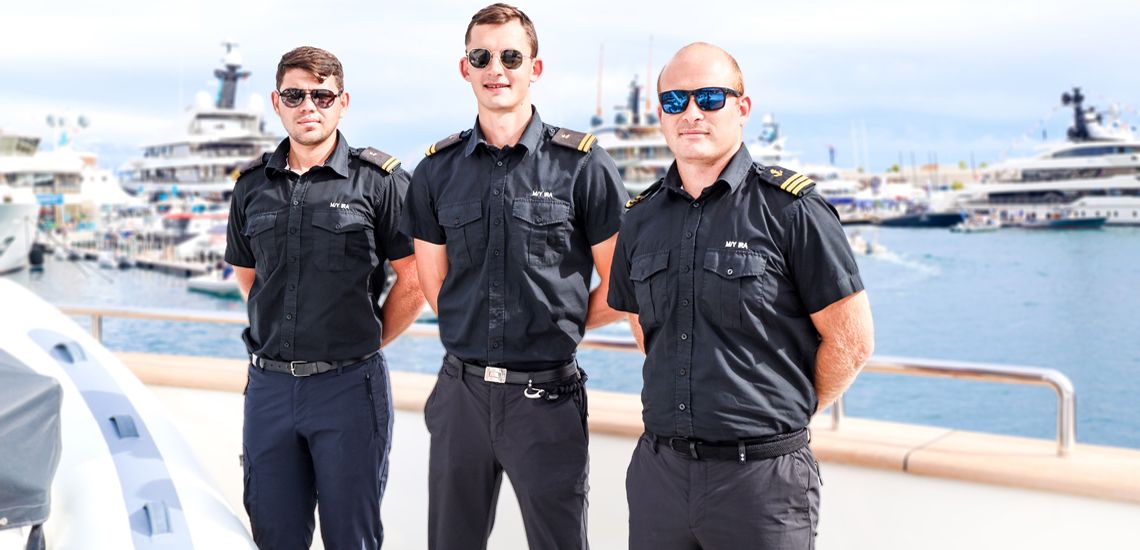
What do Yacht Stripes Mean on Epaulettes?
The epaulettes worn on the shoulders of superyacht crew are a legacy of 17th-century military dress in France —when they were used both as a decorative sign of status and a handy way of stopping your sword belt from slipping off your shoulder.
Epaulettes (also epaulets) were adopted by most world navies by the 18th century as a formal insignia of rank and then made their way into the merchant and leisure cruising industries.
The word ‘epaulettes’ comes from the French ‘épaule’, meaning shoulder, and are black with stripes in either gold or silver braid, with a symbol to designate department.
Why and When do Yacht Crew Wear Them?
Yacht crew wear epaulettes in their formal dress as a way of signifying their rank and department, as well as adding a certain status to an occasion.
Epaulettes are usually worn while welcoming guests onto the yacht at arrival and on evening service and passerelle watch, but rarely during daytime activities. These small bits of material add formality and are used as a sign of respect to the guests. You will also often wear epaulettes during boat shows or, less commonly, when welcoming officials or marine pilots on board.
Guests can use the epaulettes to know the rank and department of the crew member they are talking to (even if few guests probably know what they all mean!) Knowing the epaulette system is also helpful for crew to identify another’s rank and department at a glance. In contrast, the epaulettes act as a valuable code for the wider industry — for instance, for port officials to recognise a captain upon arrival.
Not all superyachts use epaulettes in their uniform, as they are in no way a legal requirement (as they are in the Navy). But most do — even if just for that first welcome of the boss from the airport.
The Epaulette ‘Ranking’ System The stripes run from 4 to 1 in descending order of rank. Unlike in the cruise ship industry, there are no half-stripes.
| Captain | 4 | Anchor | Gold |
| Chief Engineer | 4 | Propellor | Gold |
| First Officer/First Mate | 3 | Anchor | Gold |
| Chef | 3 | Knife & Fork | Silver |
| Purser | 3 | Quills | Silver |
| Chief Stewardess | 3 | Crescent Moon | Silver |
| First Engineer/ETO | 3 | Propellor | Gold |
| Bosun | 2 | Anchor | Gold |
| Second Stewardess | 2 | Crescent Moon | Silver |
| Second Engineer | 2 | Propellor | Gold |
| Second Chef | 2 | Knife & Fork | Silver |
| Deckhand | 1 | Anchor | Gold |
| Third Engineer | 1 | Propellor | Gold |
| Third Chef | 1 | Knife & Fork | Silver |
| Stewardess, 4th, etc | 1 | Crescent Moon | Silver |
You might have noticed that the different colours of the stripes are significant: The gold braid is reserved for deck and engineering roles, while the silver is for interior roles.
Symbols
- The symbols of anchors and propellers for deck and engineering roles are (hopefully!) self-explanatory.
- The stew’s crescent moon is a throwback to the 1800s when Napoleon introduced crescent-shaped bread to feed his army.
- The quills on a purser’s epaulettes refer to their administrative role.
How to Wear Epaulettes Like You Know What You’re Doing
Now that you know what an epaulette is and what each variation means, it’s your job to a) not lose them and b) wear them the right way up. You might wonder how you could lose an epaulette in a closed environment like a yacht, but trust us, those tiny bits of material sprout legs when you’re not looking.
We strongly suggest that you make a first-day-and-forever habit of always taking your epaulettes off and putting them on the same shelf in the bathroom. And once you’ve found them, always take a quick look to see that you haven’t put them on upside down.
Slipping on your epaulettes for the first time is a rite of passage for any new crew member. Relish the moment. Take a look in the mirror. Look sharp, don’t you?
Contact information
Laurie Lechene
You are using an outdated browser. Please upgrade your browser to improve your experience and security.

- Follow Cruise Jobs on Facebook
- Follow Cruise Jobs on Instagram

Free emails with tips and advice on how to get a job on-board a cruise ship.
Significance of Epaulettes worn by Cruise Ship Staff
- 19 November 2012
Staff on board a cruise ship are identifiable by uniform and name tags. The stripes (epaulettes) worn on their shoulders denotes their rank on the ship.
To understand the significance of these Stripes, we have compiled the following guide:

Four stripes:
- Chief Engineer
- Hotel Manager
- Staff Captain
- Staff Chief Engineer

Three stripes:
- A/C Engineer
- Casino Manager
- Chief Housekeeper
- First Purser
- Guest Relations Manager
- Second Engineer

Two and a half stripes:
- Assistant Bar Manager
- Assistant Chief Housekeeper
- Assistant Food Manager
- Guest Relations Officer
- Second Electrician
- Second Electronic Engineer
- Second Officer
- Security Officer
- Third Engineer

Two stripes:
- Second Deck Officer
- Second Engineer Officer
- Second Purser

One and a half stripe:
- Third Purser

One stripe:
- Fourth Deck Officer
- Fourth Purser
- Petty Officer
Departments
Colour between the stripes indicates the department:
| White: | Hotel |
| Purple: | Technical and Engineering, Electrical |
| Red: | Medical |
| Green: | Communications |
| Bronze: | Security |
| No colour: | Deck |
Experts puzzle over why Bayesian yacht sank. Was it a 'black swan event'?

The Bayesian set off on a leisurely cruise around Italy's southern coast on a sunny day in late July.
The luxurious super yacht − which boasted one of the largest masts in the world and carried a crew of business moguls, including British tech tycoon Mike Lynch and his family and a chair of Morgan Stanley − set sail from the Amalfi Coast, bound for Sicily.
Less than a month later, the ship had sunk 160 feet under the water , leaving its cook dead and six of its passengers, including at least two Americans, missing and prompting a massive search that has drawn international attention.
Now, experts are trying to piece together why in the early hours Monday the Bayesian was quickly pulled under the waves amid a storm that saw at least one tornado spin up over the water.
Breaking news to start your day smart. Sign up for USA TODAY's Daily Briefing newsletter.
A perfect storm led to Bayesian sinking, experts say
The combination of unlikely factors that could have contributed to the ship's fate constituted a "black swan event," Matthew Schanck, chairman of the Maritime Search and Rescue Council, told USA TODAY.
The Bayesian was well-built: A 2008 product of Italian ship maker Perini, it was constructed in accordance with international maritime standards and commercially certified by the U.K.'s Maritime and Coastguard Agency, according to Schanck.
The bout of bad weather that swept the area when the ship went down was also out of the ordinary in the northern Mediterranean, "which isn't renowned for prolonged, significant stormy weather," he said.
"The fact that those two elements have then resulted in the foundering of a super yacht is pretty extraordinary," Schanck said. "These things don't happen every day."
After the ship sank just before 5 a.m. local time, 15 people, including a 1-year-old, were pulled from the water. Some were rescued from a life raft by the crew of a ship docked nearby.
Ricardo Thomas, the ship's cook and a native of Antigua, was found dead, according to authorities.
As of Tuesday, six people were missing, including Lynch and his 18-year-old daughter. Several missing passengers were involved in Lynch's trial on fraud charges, including Jonathan Bloomer, a Morgan Stanley chair who served as his character witness, and one of Lynch's attorneys. Lynch, accused of fraud after he sold his company to electronics giant Hewlett-Packard, was acquitted of all charges weeks ago.
Who is Mike Lynch? UK entrepreneur among those missing after superyacht sinks off Sicily
Tornado formed over unusually hot water
Storms in the area that night may have whipped up a water spout, a tornado over the water , according to local meteorologists.
It was likely triggered by the water's unusual warmth, said Rick Shema, a certified consulting meteorologist who served in the Navy.
"The water spout was an uncommon occurrence," he said. "But again, these things happen, especially in warmer water."
At 83.7 degrees, water in the area was more than 3 degrees hotter than average on the day the Bayesian sank, likely the result of climate change, Shema said.
"Hurricanes can form at 80 degrees. This was almost four degrees higher than that," he said.
The water spout may have spun up when cooler air dropped from mountainous places nearby onto the hot water, he said. "A water spout is a vortex, basically like a tornado, spinning real fast, sucking up water and moisture as the column rises," he said.
Although water spouts only reach around 120 mph, as compared with tornadoes on land, which can reach up to 300 mph, "you don't need 200 mph to sink a ship," he said.
"Even an average tornado, 120 miles an hour, that's a lot of wind," he said, "which would heel the boat over for sure."
Water spouts spring up suddenly, Shema said. Before they strike, winds can be slow, but "once the water spout comes over, bam, it's on," he said.
Before sunrise, the ship's crew may not have seen the water spout coming. "The visibility was probably a big factor," he said.
With the windows of the yacht opened, as they likely were in the hot weather, the water spout could have triggered water that flooded through the portholes, Shema said, causing the ship to sink.
Tragedy strikes: Scramble to find survivors after Bayesian yacht sinks off Sicily coast
Search continues, but shift to recovery phase approaches
Italian authorities said the Bayesian was probably at anchor when the storm struck, meaning it couldn't maneuver and ride the waves, according to Mitchell Stoller, a captain and maritime expert witness. Other ships in the area that turned on their engines rode out the storm, he said.
"When you're at anchor and you see weather, you start your engine and you put the wind on the bow. You don't let it get on the side," he said.
Schanck said another key question concerns the position of the keel, a heavy weight underneath the boat that acts as a counterbalance to keep it upright, when the ship sank. When lifted, "that's going to affect the stability of the vessel, because, obviously, you've now raised the center of gravity of that vessel," he said.
The Bayesian was floating over 160 feet of water at the time, deep enough that the keel would likely be deployed. But the fact that "the vessel heeled over so heavily makes me question that," Schanck said.
The cause of the disaster may not be known until the ship can be examined in more detail, experts say. Prosecutors in a nearby town have already opened an investigation.
Schanck said investigators will have plenty to work with once the operation moves into a recovery phase.
"The vessel is intact and in good condition on the seabed," he said. "There's a lot of eyewitness accounts from other vessels in the area and the shore."
As the search entered its second day on Tuesday, the rescue effort may shift in that direction soon. "I suspect, later on, today or tomorrow, we'll probably see some mention of a recovery operation being stated," Schanck said.
The decision to would depend on whether rescuers find signs of life in the ship and air pockets or survivable spaces, Schanck said. At this point, survivors on the water's surface looks unlikely. "My professional opinion is that the casualties will be located within the vessel," he said.
"There is a risk versus benefit in all maritime search and rescue incidents," he said. "Where we start transitioning to a recovery phase, that line shifts."
Contributing: Reuters
Cybele Mayes-Osterman is a breaking news reporter for USA Today. Reach her on email at [email protected]. Follow her on X @CybeleMO.

Mike Lynch yacht latest: Two more crew under investigation as Bayesian captain refuses to answer questions
LIVE – Updated at 18:18
Two more crew members from the Bayesian are under investigation for manslaughter after seven people died when the superyacht sank off the coast of Sicily.
It comes as the captain of the boat has “exercised his right to remain silent” as he faced further questioning from Italian prosecutors investigating the sinking of billionaire Mike Lynch’s superyacht , according to his lawyer.
James Cutfield, a 51-year-old New Zealand national, is under investigation for possible manslaughter and culpable shipwreck charges and was questioned for the third time by the Termini Imerese prosecutors on Tuesday.
“The captain exercised his right to remain silent for two fundamental reasons,” lawyer Giovanni Rizzuti told reporters. “First, he’s very worn out. Second, we were appointed only on Monday and for a thorough and correct defence case we need to acquire a set of data that at the moment we don’t have.”
Being placed under investigation does not imply guilt and does not mean formal charges will necessarily follow. It is still unclear whether other individuals will also be placed under investigation.
It comes amid tributes for the owner of the British-flagged vessel Mike Lynch, his daughter Hannah Lynch, Morgan Stanley chairman Jonathan Bloomer , his wife Judith Bloomer , Clifford Chance lawyer Christopher Morvillo and his wife Neda Morvillo, who all died in the disaster.
Two more crew members from Bayesian under investigation
- Bayesian captain ‘exercised right to silence’, lawyer says
- Captain under investigation after sinking of Lynch’s yacht, judicial source says
- Timeline of the Bayesian luxury yacht disaster
- Tribute to ‘genius’ storyteller Mike Lynch
Pictured: British crew member being investigated after yacht tragedy
Three people are being investigated by the Italian authorities for manslaughter after the sinking of the Bayesian yacht off the coast of Sicily.
Ship engineer Tim Parker Eaton, is one of the two British crew members now also being investigated.
A source told Reuters that Parker Eaton is suspected of having failed to protect the yacht’s engine room and operating systems.
Being investigated does not imply guilt and does not mean formal charges will follow.
Five found in same cabin while Hannah Lynch found alone in another, according to reports
Five corpses were all found in the same cabin on the Bayesian while the body of Hannah Lynch was found alone in another, according to Italian officials.
The five people that rescue divers found together appeared to have gathered in the first cabin on the left of the superyacht in an attempt to escape, reported The Telegraph , while the 18-year-old was discovered in the third cabin on the left on her own.
Girolamo Bentivoglio Fiandra, a senior officer from the fire service, said on Saturday: “The yacht tended to the right and obviously the bodies tried to go to the other side and take refuge in their cabins. We found five bodies in a cabin on the left and another one in the third cabin on the left. They were in the higher part of the shipwreck.”
Who was on the Bayesian?
The sinking of the Bayesian off the coast of Sicily made headlines across the world, with interest rising when it was revealed that British technology tycoon Mike Lynch was among those onboard.
It then emerged that the boat trip was a celebration by Mr Lynch with friends, colleagues and his legal team after he won a decade-long legal battle.
Here we explain who was onboard the ship during the tragedy:
Mike Lynch yacht latest: Two crew investigated as Bayesian captain refuses questions
What are investigators focusing on?
Chief prosecutor Ambrogio Cartosio confirmed an investigation has been launched on Saturday.
He said his team will consider each possible element of responsibility, including those of the captain, the crew, individuals in charge of supervision, and the yacht’s manufacturer.
The Bayesian, a 184ft (56m) British-flagged luxury yacht, went down near the Mediterranean island in southern Italy last Monday.
Investigators are focusing on how a vessel deemed “unsinkable” by its manufacturer, Italian shipyard Perini Navi, sank while a nearby sailing boat remained largely unscathed.
Prosecutors said the event was “extremely rapid” and could have been a “downburst” - a localised, powerful wind that descends from a thunderstorm and spreads out rapidly upon hitting the ground.
The crew were saved, apart from the chef, while six passengers were trapped in the hull.
Watch: Final moments of seven who died in Bayesian tragedy revealed by fire service boss
Why did the bayesian sink.
Hatches and doors left open overnight on the superyacht Bayesian may have caused it to sink in Italy , a sailing expert has said.
Sam Jefferson, editor of magazine Sailing Today, believes the vessel’s huge mast is also likely to have contributed to the deadly event.
Mr Jefferson told the PA news agency: “I would have said that the boat got hit very hard by the wind, it was pinned over on its side.
“I imagine all the doors were open because it was hot, so there were enough hatches and doors open that it filled with water very quickly and sank like that.
“The reason it got pinned over so hard was because the mast is huge.
“It acted almost like a sail. (It) pushed the boat hard over on its side.
“(The boat) filled with water before it could right.
“This is all speculation, but that’s the only logical explanation.”
Bayesian captain ‘exercised right to silence’ in manslaughter probe questioning, lawyer says
The captain of the Bayesian yacht chose not to respond to prosecutors’ questions as he was spoken to for a third time on Tuesday, his lawyer has said.
James Cutfield, a 51-year-old New Zealand national, is under investigation for possible manslaughter and culpable shipwreck charges.
Being placed under investigation does not imply guilt or mean that charges will necessarily follow. Chief prosecutor Ambrogio Cartosio has said his team would consider each possible element of responsibility including those of the captain, the crew, individuals in charge of supervision and the yacht’s manufacturer.
The Times reported one of Mr Cutfield’s lawyers as saying that the captain is “understandably very shaken up” after the ordeal last Monday.
Who is being investigated?
On Monday, the boats 51-year-old captain James Cutfield, from New Zealand, was put under investigation. He declined to respond to prosecutors during questioning on Tuesday
Two British crew members are now also being investigated. Ship engineer Tim Parker Eaton and sailor Matthew Griffith are being investigated over the same crimes.
How Mike Lynch’s inner circle celebrated end of billionaire’s 13 year court battle
British technology tycoon Mike Lynch and his 18-year-old daughter Hannah were among the people initially unaccounted for after his superyacht Bayesian sank in a storm off the coast of Sicily in the early hours of Monday.
On Saturday morning, Italian authorities announced a manslaughter investigation had been launched into the deaths of seven people, after a five-day operation that has seen divers carefully navigating their way into the cabin bedrooms.
After a decade-long legal battle which had seen him extradited to the US to face an $11bn fraud case, Mr Lynch had celebrated by inviting his close friends, colleagues and those who helped him on his legal team aboard his boat as a gesture of gratitude.
Read the full article here:
Who was on Bayesian and how they were celebrating end of Mike Lynch’s court battles
Read the full story: Two more crew members under investigation
Two more crew members from the Bayesian are under investigation for manslaughter, including the ship engineer and sailor.
A source said that Tim Parker Easton is suspected of having failed to protect the yacht’s engine room and operating systems, while Matthew Griffith was on watch duty on the night of the incident.
Read the full article from Tara Cobham here:
Two more crew members under investigation over sinking of superyacht Bayesian
Investigation will consider every possible element
Chief prosecutor Ambrogio Cartosio, who is heading the investigation, has said his team would consider each possible element of responsibility including those of the captain, the crew, individuals in charge of supervision and the yacht’s manufacturer.
The legal team have also said their investigation would take time and required the wreck of the Bayesian superyacht to be salvaged from the sea. It is currenlty lying on its right side, at a depth of around 50 metres (164 feet).
Two more crew members from the Bayesian are under investigation for manslaughter after seven people were killed when the superyacht sank in a storm off Sicily last week.
A judicial source said on Wednesday that Italian prosecutors are probing two more crew members in connection with the vessel’s sinking, along with its captain, after the British-flagged Bayesian capsized on 19 August while anchored off northern Sicily .
Ship engineer Tim Parker Eaton and sailor Matthew Griffith are both also being investigated over the same crimes. The source said that Parker Eaton is suspected of having failed to protect the yacht’s engine room and operating systems, while Griffith was on watch duty on the night of the incident.
Pausing coverage
Good evening, that’s all for today on our coverage.
What happened when boat started sinking
The Bayesian sent its last signal before sinking via the tracking Automatic Identification System (AIS) at 0206 GMT, according to the MarineTraffic website.
Chief Prosecutor Ambrogio Cartosio said a red flare alerting rescue services about the emergency was fired into the sky at 0238 GMT, more than 30 minutes after the boat had gone down.
The head of Palermo’s Fire Brigade, Girolamo Bentivoglio Fiandra, said the boat sank from the stern and is lying on its starboard side at a depth of around 50 metres (164 feet).
In the yacht, the bodies of the dead were found in the cabins on the left-hand side of the boat, where the passengers may have tried to search for remaining bubbles of air, he added.
Prosecutor Cammarano said the passengers were all probably asleep at the time of the storm which was why they failed to escape.
The Bayesian captain’s legal team
The Bayesian captain James Cutfield was asked to appoint a lawyer after questioning by Italian prosecutors investigating the sinking of the yacht on Sunday.
The 51-year-old has been placed under investigation for possible manslaughter and shipwreck, according to his lawyer Aldo Mordiglia.
Mr Mordiglia is one of two lawyers who are representing the New Zealander. The other is Palermo lawyer Giovanni Rizzuti.
According to Italian media reports, Mr Mordiglia, from Genoa, is specialised in maritime and international law.
The captain of the Bayesian yacht chose not to respond to prosecutors’ questions as he was spoken to for a third time on Tuesday, his lawyer has said.
The Times reported one of Mr Cutfield’s lawyers as saying that the captain is “understandably very shaken up” after the ordeal last Monday.
Giselda Vagnoni has more in this report:
Lawyer gives update on investigation into captain of superyacht that sank off Sicily
Hatches and doors left open overnight on the superyacht Bayesian may have caused it to sink in Italy , a sailing expert has said.
Bayesian now an ‘environmental bomb'
Reports in Italy are emerging about the sunken Bayesian with divers from the coast guard beginning to film the wreck under the request of the prosecutor as the investigation gathers pace.
There are also concerns over the 18,000 litres of fuel and oil reportedly still on the boat.
Speaking to local outlet Corriere Della Sera, a fisherman said: “It is an environmental bomb at the bottom of our sea.”
Mass for the victims
In case you missed it over the bank holiday weekend, a mass for the victims of the Bayesian tragedy was held in Porticello on Sunday.
Flowers were also sent into the sea as a mark of tribute to those who died.
Boat was ‘one of the safest in the world’
The Bayesian was built in 2008 by Perini Navi, an Italian luxury yacht maker. It featured the world’s tallest aluminium mast, measuring 72 metres, but early reports that the mast broke in the storm have so far proven unfounded.
Giovanni Costantino, CEO of the Italian Sea Group, which owns Perini, said the yacht was “one of the safest boats in the world” and basically unsinkable.
He alleged that the sinking was due to a chain of human errors given that the storm was expected. He made his assertions partly based on data from the Automatic Identification System. The captain and other crew members have not spoken publicly about the disaster and attempts by Reuters to reach them have been unsuccessful.
Costantino said that had the crew shut all doors and hatches, turned on the engine, lifted the anchor, lowered the keel and turned the yacht to face the wind, it would have suffered no damage.
He added that data showed it took 16 minutes from when the wind began buffeting the yacht, and it began taking on water, for it to sink.
Nothing wrong with the Bayesian being moored offshore - say coast guard
The Bayesian was anchored off the port of Porticello, near Palermo, when it sank in the pre-dawn dark amid a very severe and sudden weather event.
Prosecutor Raffaele Cammarano said on Saturday the event was most likely a “downburst”, a very strong downward wind that is an intense but relatively frequent event at sea, rather than a waterspout which involves rotating winds like a tornado.
The coast guard have also said that given the weather forecast, there was nothing wrong about the Bayesian being moored offshore rather than at sheltering at port. Another yacht anchored nearby emerged from the storm unharmed.
Twenty-two people were on board, and 15 survived, including nine out of 10 crew members as well as Lynch’s wife, whose company owned the Bayesian. They were found on a life raft.
Six out of the 12 passengers died. Prosecutors, who have put the yacht’s captain James Cutfield under investigation for manslaughter and shipwreck, said the ship would have to be pulled out of the water before the investigation could be concluded.
Puzzlement over sinking
The sinking has puzzled seafarers and nautical engineers, who have said that it should have taken hours for the Bayesian to fill up with enough water to sink it, making its swift demise incomprehensible.
There have been suggestions that one or more portholes, windows or other openings may have been inadvertently left open by the crew, or broken or smashed by the storm, letting in water.
Experts also wondered if the yacht had been moored with its keel up, potentially compromising its stability. The keel is a fin-like stabilising structure under the hull, which can be partially lifted to reduce the depth of the boat in shallow waters or harbours.
Prosecutors have said it was too early to comment on either hypothesis. They also said crew members were not immediately tested for alcohol or drugs because they were in a state of shock when rescued.
Captain of Bayesian under investigation - recap
The captain of the Bayesian is being investigated for manslaughter and shipwreck , a judicial source has said, as the probe into the sinking of the superyacht in a storm off Sicily continues.
Italian prosecutors have placed James Cutfield under investigation over the deaths of British tech tycoon Mike Lynch and six other people , the official, who asked not to be named, told Reuters on Monday, confirming earlier reports by Italian media.
Being placed under investigation in Italy does not imply guilt and does not mean formal charges will necessarily follow. Notices to people under investigation need to be sent out before authorities can carry out the autopsies on the bodies of the dead.
Bayesian captain ‘investigated for manslaughter’ as probe into sinking continues
Mike Lynch’s wife leaves Sicily
Mike Lynch’s wife, Angela Bacares, was among the 15 survivors of the sunked Bayesian.
Her husband and 18-year-old daughter Hannah, however, were among the seven people who died.
Many of the survivors have stayed in Italy as authorities try to work out what happened onboard ahead of the sinking last week.
But on Sunday, Ms Bacares reportedly left Sicily along with other survivors in a private jet.
Bayesian captain ‘deeply affected’ by ordeal
James Cutfield, 51, the captain of the tragic Bayesian, faces further questioning from prosecutors in Italy today after he was placed under investigation for possible manslaughter and shipwreck.
One of his lawyers, Giovanni Rizzuti, told the Guardian on Monday: “Our client is deeply affected by this ordeal.”
“We are currently assessing, with other legal representatives, the defence strategy and examining the technical aspects of the case.”
Bayesian captain facing further questioning from prosecutors on Tuesday
Prosecutors in Italy continue to investigate the captain of a superyacht that sank during a storm off Sicily last week.
James Cutfield, the 51-year-old New Zealand national who was captain of the Bayesian, was among 15 survivors of the August 19 sinking that killed British tech magnate Mike Lynch, his daughter Hannah and five others.
Mr Cutfield is being investigated for possible manslaughter and culpable shipwreck, said lawyer Aldo Mordiglia, one of two attorneys appointed for the captain’s defence.
Mr Mordiglia said Mr Cutfield, who already has been questioned, would be questioned again by prosecutors on Tuesday. He declined to discuss the strategy for the defence.
Under Italian law, being under investigation does not imply guilt and does not necessarily lead to criminal charges.
On Saturday, chief prosecutor Ambrogio Cartosio confirmed an investigation has been launched.
New York lawyer who died in yacht disaster wrote haunting LinkedIn post weeks before
A lawyer who died after a yacht sank off the coast of Sicily wrote a haunting post on LinkedIn two months before he joined the doomed voyage.
In one of his only posts on the site, Christopher Morvillo, 59, thanked his legal team after they helped British tech tycoon Mike Lynch win a fraud trial and discussed living “happily ever after.”
Graig Graziosi and Mike Bedigan report:
NYC lawyer who died in yacht disaster wrote haunting LinkedIn post weeks before
What is a downburst?
Officials said the superyacht had been hit by a downburst and the Italian officials said they would be looking at how it could affect one vehicle and not other nearby vessels, according to the translation of the conference.
A downburst is an intense burst of wind at ground level emenating from the strong downdraft of a thunderstorm; the wind often blows radially from a point source, as opposed to the rotating winds associated with a tornado.
Downbursts usually last just a few minutes, and can be particularly dangerous for aviation.
They have been blamed for a number of air crashes over the years, although the risk tends to be well forecast by meteorologists allowing pilots to avoid them.
Ex-court appointed guard says Mike Lynch ‘became more like a family’
A court-appointed armed guard, tasked with ensuring Mike Lynch did not abscond while facing fraud charges, has paid tribute to the tech mogul, saying the security team “became less of a detail and more like a family”.
Rolo Igno also described “the memory of a beautiful soul” in Mr Lynch’s daughter Hannah.
Mr Igno said he had the “privilege” of spending “almost every waking moment” with Mr Lynch while he was in custody in San Francisco, describing the detail as unlike any other he had ever worked and one that was “life changing”.
“As an executive protection agent, the number one rule is simple, don’t ever get close to the principal,” he said.
“They aren’t your friends, they’re a client and the relationship is strictly professional. But with Mike, that didn’t fly with him and for me that rule quickly dissolved.”
Final moments of seven who died in Bayesian tragedy revealed by fire service boss
Why was mike lynch’s yacht named the bayesian.
Autonomy, the software firm which Mike Lynch sold in a £8.64bn deal in 2011, was a pioneer of business data analysis, using machine learning and what Mr Lynch called “adaptive pattern recognition”.
It used a statistical method called “Bayesian inference” at the heart of its software, devised by the 18th-century mathematician Thomas Bayes.
The yacht’s name, Bayesian , harks to the same model that was at the heart of Autonomy’s – and Mr Lynch’s – success.
How did Mike Lynch make his money?
Once dubbed the “British Bill Gates”, Mike Lynch and his wife Angela Bacares were valued at £852m in 2023 by the Sunday Times Rich List.
The 59-year-old tech tycoon is known for founding Invoke Capital and Autonomy Corporation and had been in the headlines after he was cleared of charges in a high-profile fraud case.
My colleague Barney Davis has more details:
Mike Lynch net worth: How the billionaire made his money
Watch: Captain details Bayesian sinking 'within two minutes' after rescuing survivors
In focus | how the world of yachts got supersized.
The sinking of the 56-metre yacht Bayesian and the tragic deaths of British tech tycoon Mike Lynch and his guests and boat staff have given the public a glimpse into the rarefied world of superyachts, writes Boat Internationa l’s Lucy Dunn .
From the sheer size of the mast (74 metres, roughly the size of seven two-storey houses stacked on top of each other) to the expense ( Bayesian was put up for sale in 2014 with an asking price of $30m, which is around £23m), to the sheer luxury (the interiors were by Remi Tessier, the designer behind Claridge’s new penthouse), it’s a world few people normally get to see.
There are currently 12,626 superyachts on the water around the world with 1,166 superyachts in build or on order. If you have been to a Greek island this year, or maybe the Amalfi coast, you may have glimpsed them coming in and out of harbours and wondered who owns a yacht like that. Or who can afford to charter a yacht like that – which have an average price of around £180,000 a week.
While you may think of glossy influencers and A-listers, the superyachting fraternity is where millionaires are sorted from the billionaires from the centi-billionaires; the 0.001 per centers. Rarely will you find a celebrity with the financial clout to afford a yacht owned by Lynch, these are generally under-the-radar industry titans who don’t have household names.
So, what exactly makes a superyacht super? According to Boat International, where I work, it can be applied to any boat, motor or sailing yacht which is over 24 metres in length. Size, in the superyacht world, is everything – and yachts are getting bigger all the time.
Read the full article with Independent Premium:
Giant masts, moon pools and explorer pods: How the world of yachts got supersized
Friend pays tribute to Bayesian chef Recaldo Thomas
Recaldo Thomas was the superyacht’s chef and the first person whose death was confirmed.
The Canadian-Antiguan national was found by the Italian coastguard near the sunken boat. A friend of Mr Thomas, who asked to remain anonymous, said the yachting community has been saddened by his death.
She told The Independent: “He was a one-of-a-kind special human being. Incredibly talented, contagious smile and laugh, an incredible voice with a deep love of the ocean and the moon. I spoke to him nearly every day. He loved his life his friends and his job.”
Bayesian captain to be questioned again on Tuesday, lawyer says
James Cutfield, the 51-year-old New Zealand national who was captain of the Bayesian, is being investigated for possible manslaughter and culpable shipwreck, said lawyer Aldo Mordiglia, one of two attorneys appointed for the captain’s defence.
Mr Cutfield, who already has been questioned, will be questioned again by prosecutors on Tuesday, Mordiglia said.
Under Italian laws, being under investigation doesn’t imply any guilt, and doesn’t necessarily lead to criminal charges.
Chief prosecutor Ambrogio Cartosio confirmed on Saturday that an investigation had been launched and that his team would consider each possible element of responsibility including those of the captain, the crew, individuals in charge of supervision and the yacht’s manufacturer.
Watch: The moment Bayesian yacht was engulfed by storm
Yacht ‘should have taken hours' to fill up with enough water to sink it.
The sinking of the Bayesian has puzzled seafarers and nautical engineers, who have said that it should have taken hours for the yacht to fill up with enough water to sink it, making its swift demise incomprehensible.
Bayesian sank from its stern, fire chief says
The Bayesian sent its last signal before sinking via the tracking Automatic Identification System (AIS) just after 4am local time, according to the MarineTraffic website.
Chief Prosecutor Ambrogio Cartosio said a red flare alerting rescue services about the emergency was fired into the sky more than 30 minutes later.
Hannah Lynch was ‘one of the best English students in the country’, teacher says
Hannah Lynch had just completed her A-levels and secured a place to study English at Oxford University.
Her former English teacher Jon Mitropoulos-Monk said she was “one of the best English students in the country” having scored 100% in her English Literature GCSE.
Patrick Jacob, a family friend, paid tribute to her on Friday, saying: “Hannah was charming and ferociously intelligent with an insatiable thirst for life and knowledge. She was also warm, loving and deeply considerate; remarkably for her age.
“I am 50 years older than her and in my life I have never met anybody like Hannah. We have lost one of our brightest stars whose future held so much promise. Her loss is unbearable.”
After a decade-long legal battle which had seen him extradited to the US to face an $11bn fraud case, Mike Lynch had celebrated by inviting his close friends, colleagues and those who helped him on his legal team aboard his boat as a gesture of gratitude.
Yet a week of sunshine along the Italian coastline would soon turn to horror after the boat capsized shortly before dawn, only offering those onboard a few minutes to get themselves to safety.
My colleagues Rachel Hagan and Jabed Ahmed report:
Prosecutors say powerful wind could have caused the Bayesian’s ‘extremely rapid’ demise
Investigators are reported to be focusing on how the 56-metre luxury yacht Bayesian – a vessel deemed “unsinkable” by its manufacturer, Italian shipyard Perini Navi – sank while a nearby sailing boat remained largely unscathed during the storm off the coast of Sicily last Monday.
Prosecutors said the event was “extremely rapid” and could have been a “downburst” – a localised, powerful wind which descends from a thunderstorm and spreads out rapidly upon hitting the ground.
Prosecutors say no suspect identified so far
On Saturday, chief prosecutor Ambrogio Cartosio confirmed an investigation has been launched into the sinking of the superyacht but said a suspect has not been identified.
He said his team will consider each possible element of responsibility, including those of the captain, the crew, individuals in charge of supervision, and the yacht's manufacturer.
The five people that rescue divers found together appeared to have gathered in the first cabin on the left of the superyacht in an attempt to escape, reported The Telegraph , while the 18-year-old was discovered in the third cabin on the left on her own.
Prosecutors describe Bayesian sinking as ‘extremely rapid’
Prosecutors have described the sinking of the Bayesian superyacht as “extremely rapid” and suggested it could have been caused by a “downburst”.
A downburst is a localized, powerful wind that descends from a thunderstorm and spreads out rapidly upon hitting the ground.
Mike Lynch and daughter Hannah were ‘part of a united, vibrant, loving family’
Family friends of Mike and Hannah Lynch have said the father and daughter were part of a “united, vibrant, loving family” – with the teenager remembered as a “diamond in a sea of stars” and the tech mogul as a brilliant storyteller.
The pair were among seven people who died after the luxury superyacht Bayesian sank off the coast of Sicily early on Monday morning.
Mr Lynch was the creator of software giant Autonomy and had been cleared in June of carrying out a massive fraud related to its 11 billion dollar (£8.64 billion) sale to US company Hewlett Packard.
Ellie Ng reports:
Teenager who died in superyacht tragedy was ‘a diamond in a sea of stars’
Rolo Igno also described “the memory of a beautiful soul” in Mr Lynch’s daughter Hannah, 18, after they died in the sinking of the luxury superyacht Bayesian off the coast of Sicily early on Monday.
Mr Lynch founded software giant Autonomy in 1996, and was cleared in June of carrying out a massive fraud relating to its 11 billion dollar (£8.64 billion) sale to US company Hewlett Packard, after a trial at a federal court in San Francisco , California.
Bayesian captain insisted ‘we didn’t see storm coming'
The captain of the Bayesian insisted he did not see the storm that sank the Bayesian last week.
Speaking of the storm, James Catfield, 51, said on Tuesday: “We didn’t see it coming.”
A judicial official, who asked not to be named, confirmed to Reuters on Monday the earlier reports in Italian media that the New Zealander was being investigated by Italian prosecutors after the superyacht capsized in a tornado off the coast of Sicily last Monday.
Mike Lynch had concerns over Lucy Letby conviction, says former minister
Former cabinet minister Sir David Davis has said that Mike Lynch , the tech mogul who died when his yacht sank off the coast of Sicily last week , was planning to examine the murder conviction of nurse Lucy Letby over concerns about its safety.
Sir David, the former Brexit secretary, has previously told The Independent he plans to spearhead an investigation questioning the conviction of Letby after a number of experts cast doubt over her guilt.
Sir David said he hopes to visit Letby in prison as part of an investigation into whether the serial baby killer may be the victim of a miscarriage of justice . Letby is serving 15 whole-life sentences for seven murders and eight attempted murders of babies in her care at the Countess of Chester Hospital between 2015 and 2016.
My colleague Jabed Ahmed reports:
Mike Lynch had questions over Lucy Letby conviction, says former minister
Mike Lynch’s net worth and how the billionaire made his money
British tech tycoon Mike Lynch was among seven people who died after the luxury superyacht Bayesian sank off the coast of Sicily early on Monday morning
The 59-year-old is known for founding Invoke Capital and Autonomy Corporation and had been in the headlines after he was cleared of charges in a high-profile fraud case.
He was on the boat, named Bayesian, which sank in bad weather in the early hours of Monday near the Sicilian capital Palermo .
My colleague Barney Davis reports:

Ship captain who saw Mike Lynch’s yacht sink blames ‘extreme mast’

An eye witness to the sinking of British tech entrepreneur Mike Lynch ‘s yacht on Monday attributed the tragedy to the extremely tall mast, which made the vessel more vulnerable to the violent storm that was lashing the area.
Dutch ship captain Karsten Börner, whose own boat was anchored near Lynch’s Bayesian , told the Financial Times that the superyacht appeared to have stability problems.
“The center of gravity is too high with this extreme mast,” he explained, while also dismissing the Italian coast guard’s initial view that the Bayesian was in the wrong place at the wrong time.
“I was on the same spot,” Börner added. “I have two masts and they are 28 and 29 meters above deck, she has one, 73 meters (239.5 feet) above deck.”
Authorities are looking into possible reasons Lynch’s yacht quickly sank , when other boats nearby seemed to weather the same storm without issue.
The 56-meter long superyacht had been carrying 22 passengers and crew. Börner rescued 15 passengers and said they told him the ship sank in less than two minutes.
He also described the wind as “violent, very violent,” telling the FT that the wind speed likely reached hurricane strength as “tons of water” came down.
“I never saw that before, there was a water tornado,” he said.
The CEO of the Italian Sea Group, which owns the company that built the Bayesian , previously told the FT that it was designed to be stable with its tall mast and suggested the crew didn’t carry out proper safety measures.
But Börner said the crew told him they “closed the ship,” according to the FT .
The Italian Sea Group didn’t immediately respond to Fortune’s request for comment on Börner’s remarks and declined to comment to the FT .
Meanwhile, prosecutors in Italy have launched a probe into the shipwreck and multiple counts of culpable homicide, which are equivalent to manslaughter charges.
The Italian coast guard also confirmed Friday that it had recovered the body of Lynch’s 18-year-old daughter, Hannah. In addition to Lynch and his daughter, the other victims included Morgan Stanley International chair Jonathan Bloomer and his wife, Judy Bloomer; Clifford Chance lawyer Chris Morvillo and his wife, American jewelry designer Neda Morvillo; and chef Recaldo Thomas.
On Saturday, Italian prosecutors told reporters that the emergency began at 4:38 a.m. local time , when a red flare was launched and seen by the coast guard, adding that the passengers were likely asleep at the time.
Deputy prosecutor Raffaele Cammarano told reporters that a crew member had been on duty, as required, when the “truly sudden” storm struck.
Chief prosecutor Ambrogio Cartosio said ship-tracking data showed the yacht started to drift from anchor just before 4 a.m., then traveled about 360 meters over five minute to the spot where it eventually sank some 15 minutes after that.
Latest in Tech

X will shut down its SF headquarters in two weeks — on Friday the 13th

Half of Gen Zers don’t intend to vote—but Kamala Harris and Donald Trump still need their support to win the 2024 election

Generative AI is accelerating the spread of fake reviews and malicious apps

Instagram reportedly explores real-time integration of Spotify

Nvidia’s stock may be down after its latest results, but there’s no fundamental reason for that

Nearly half of Nvidia’s revenue comes from just four mystery whales each buying $3 billion-plus

IMAGES
VIDEO
COMMENTS
Speaks multiple languages fluently. New build experience. Project Management certification or Management degree. Limited experience in intended cruising area. Lack of experience on a similar size vessel. Yacht Captains have 5+ years experience and are responsible for the safety of passengers, crew & vessel. They earn $84K-180K based on yacht ...
A captain's role is always to run the crew, oversee the technical condition of the yacht and monitor the finances whilst keeping it safe, secure and in compliance of all local and international maritime regulations. Beyond that, the role that a captain fulfils changes deepening on the size of the yacht, the owner's style and if there is a ...
The simple answer, says Gordon, is no - and in fact the role of a modern yacht captain is highly complex and multifaceted. Take Gordon's current command, for example - a 33-metre private yacht that cruises extensively with the owning family on board. "My responsibilities of course encompass safely operating and navigating the boat ...
Hours, Salaries, and Expectations. Yacht crew is a service job at its core, and every yacht owner is looking for service-oriented people who understand how to deliver a hotel-quality living and restaurant-quality fine dining. Work experience in luxury hotels and restaurants is a big plus for some jobs, and makes breaking into yacht work easier.
The top of the hierarchy on each yacht is the Captain, who reports to the yacht owner either directly, or through a representative or a yacht management company. Salaries vary and depend on the yacht size, use, type and location, as well as the experience and qualification of the crew member. We included typical salaries of crew based on the ...
Captain derives the Latin term caput, meaning head (see capital) and the French word capitaine, meaning leader. [2] The Captain is the highest ranking position onboard the yacht and are tasked with the management and safe operation of the entire yacht.
Connor started the company in 2001, after spending nine years at sea as a professional yacht captain. If there's a recruitment strategy to avoid, says Connor, it's hiring the first referral from a well-meaning friend. While recommendations from trusted sources are helpful, "there are times when it can feel like trying to fit a square peg ...
Here are the duties and responsibilities of a boat crew: Captain: The captain is the team leader of the crew, responsible for navigating the vessel, monitoring the weather and sea conditions, and making decisions on the direction and course. The captain is also responsible for the safety of the crew and the vessel.
We look for help in the Cambridge and the Merriam Webster again, the two most reliable dictionaries, both agree that a captain is a person in charge of a ship. You can feel a tiny difference if we compare "a person in charge" to the definition of a skipper: "a master of a ship". The former is assigned, the latter is just there.
Bayesian was a 56-metre (184 ft) sailing superyacht, built as Salute by Perini Navi at Viareggio, Italy, and delivered in 2008. [9] It had a 72-metre (237 ft) mast, one of the tallest in the world. The yacht was last refitted in 2020. [10] It was in the legal ownership of Angela Bacares, wife of the technology entrepreneur Mike Lynch. [11] [12] It was at anchor off the northern coast of Sicily ...
Each vessel has a different business model. At a minimum, the captain is responsible for budget oversight and financial record keeping. If the owner engages a management company, the captain is the interface between the yacht and that organization. Navigating. The classic definition of a captain's job is that of a navigator.
The direction and speed of the wind as felt in a moving boat - the way it 'appears". Astern. The direction toward or beyond the back of the boat (stern). Athwartships. Perpendicular to the yacht's centerline. An 'athwartships berth," means the bed is parallel to the yacht's sides instead of to its bow and stern.
Important sea service requirements for Master Inland/GL: Must be at least 19 years old. Must be able to document 360 days of experience on a vessel. (See: What Counts as Sea Service) 90 days of sea service must be within the last 3 years of when you apply. The tonnage of the license (25 Ton, 50 Ton, or 100 Ton) that you get, is determined by ...
Captain and Sipper are often used to mean the same thing even though they're not exactly the same. The Captain is in charge of the crew and everything happening on the boat. They are in command of the ship, while a Skipper is in charge of the ship alone rather than anyone that is actually on it. Also, a Captain is usually used on a larger ...
Gaff: The spar that holds the upper edge of a fore-and-aft or gaff sail.Also, a long hook with a sharp point to haul fish in. Gaff-topsail: Triangular topsail with its foot extended upon the gaff. Galley: The kitchen of the ship. Gangplank: A movable bridge used in boarding or leaving a ship at a pier; also known as a "brow". Gangway: Either of the sides of the upper deck of a ship
Naturally, the captain sits at the top of the pecking order with four stripes while green crew will likely be given just the one, although this can vary from yacht to yacht depending on size and number of crew on board. Four stripes: Captain, chief engineer. Three stripes: First officer, first engineer, chief stewardess, chef
The captain of a sunken Italian yacht is under investigation after the accident off the coast of Sicily last week that killed seven people and left 15 survivors.
The captain of the yacht, James Cutfield, is also facing a manslaughter inquiry to determine whether his actions negligently caused the shipwreck, one of his lawyers said Tuesday.
Commercial yacht. A motor or sailing vessel in commercial use (i.e. charter) for sport and pleasure, carrying no cargo and not more than 12 passengers. Private yacht. A pleasure vessel solely used for the recreational and leisure purpose of its owner and his guests. Flag administration.
Crescent Moon. Silver. Colours. You might have noticed that the different colours of the stripes are significant: The gold braid is reserved for deck and engineering roles, while the silver is for interior roles. Symbols. The symbols of anchors and propellers for deck and engineering roles are (hopefully!) self-explanatory.
Significance of Epaulettes worn by Cruise Ship Staff. Staff on board a cruise ship are identifiable by uniform and name tags. The stripes (epaulettes) worn on their shoulders denotes their rank on the ship. To understand the significance of these Stripes, we have compiled the following guide:
Any yacht that is 79 feet long or longer is classified as a "large yacht." Beyond a length of 130 feet, the vessel is typically called a "super yacht" (sometimes written as one word, superyacht). Sidebar: the current reigning champion for the longest yacht in the world is the super yacht Azzam, which is 590 feet in length. Another ...
Italian authorities said the Bayesian was probably at anchor when the storm struck, meaning it couldn't maneuver and ride the waves, according to Mitchell Stoller, a captain and maritime expert ...
The captain of Mike Lynch's yacht flew out of Palermo on Thursday, 10 days after the British tech tycoon and six other people were killed when the vessel sank off the coast of Sicily.
Mike Lynch yacht latest: Two more crew under investigation as Bayesian captain refuses to answer questions - Italian prosecutors are investigating captain James Cutfield over deaths of British ...
Dutch ship captain Karsten Börner, whose own boat was anchored near Lynch's Bayesian, told the Financial Times that the superyacht appeared to have stability problems.